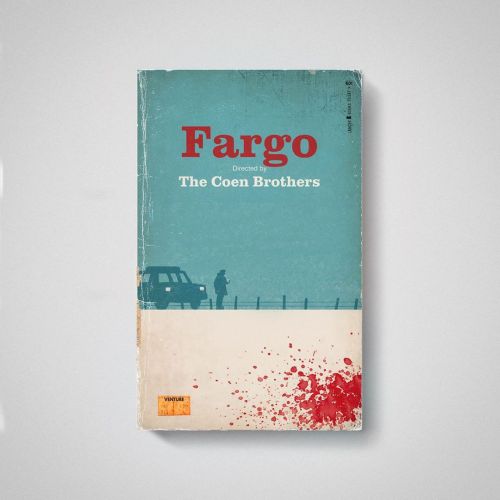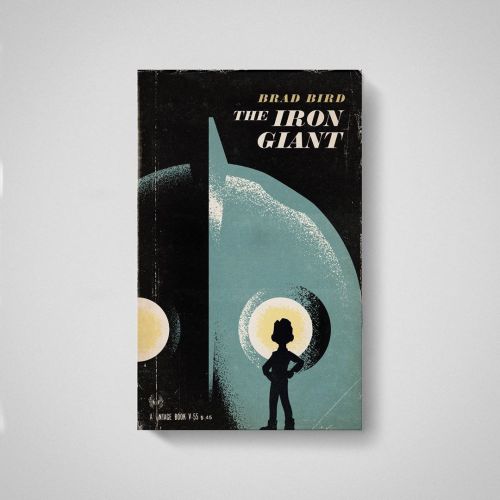torp3918
Shared posts
Colorized portraits of Ellis Island immigrants, 1906-1911
Ontario woman stunned after scoring 365 points on a single word in Scrabble

In Scrabble, 365 points would be considered a great score for an entire game, but Betty Kuchta of Chatham, Ont., earned all those points with just a single word.
Street life of Victorian London in rare historical photographs, 1873-1877
Hand-colored photographs of Japan on the brink of modernity, 1870s
Belfast in amazing rare color photographs, 1955
The harsh life in Greenland, 1888-1907
Steampunk Busts Sculpted from Resin and Repurposed Objects Evoke Futuristic Relics

“Hippy Betsoebe,” resin, recycled objects, and paint. All images © Tomàs Barceló, shared with permission
Spotted with corroded patches, Tomàs Barceló’s sculptures fuse classical antiquity and retro-futurism. The Cala Millor, Mallorca-based artist casts steampunk-style figures from resin and recycled objects that resemble ancient art while evoking otherworldly relics of an alternate reality.
Barceló sculpts the polychromatic artworks with a narrative and identity in mind, considering the way each will interact with others. He expands on the idea in a recent interview:
I believe that sculpture is the art of presence… Sculpture shares space and time with the viewer, and that is what makes it so powerful. That’s why I don’t try so much to tell stories as I try to create powerful presences, each in its own way. The fact that a small robot girl looks at you more intensely than you look at her, is fascinating to me.
Despite having created sculptures of clay, LEGO, and cardboard since childhood, Barceló fully immersed himself in the art world in 2014 after working for years as a high-school teacher. Throughout the 20 years leading up to his current practice, Barceló has realized the potential of juxtaposing traditional and fantastic elements. “For too long, I was focused only on the language of sculpture, and I forgot the content,” he says. “As if, to make a classical sculpture, I could only make naked figures; or if I wanted to make something of Egyptian-style, I had to make writings, and so on.”
Barceló lists available pieces on Etsy, and you can find more of his figurative sculptures on Instagram.

“Happy KAL-IX,” sculpted in clay and plaster, cast in resin and details added with epoxy and recycled objects, painted with shellac, acrylics, and metallic paint

“Happy KAL-IX,” sculpted in clay and plaster, cast in resin and details added with epoxy and recycled objects, painted with shellac, acrylics, and metallic paint

“WINNA-T,” resin

“WINNA-T,” resin

“Hippy Betsoebe,” resin, recycled objects, and paint

“Kek Betsoebe,” wall sculpture in resin, painted with shellac, acrylics, and metallic paint

“Kek Betsoebe,” wall sculpture in resin, painted with shellac, acrylics, and metallic paint
Contemporary Elevation Data and Historical Maps Merge in Scott Reinhard’s Digital Works

1966 Allen’s Creek, Indiana. All images © Scott Reinhard, shared with permission
By day, Scott Reinhard designs graphics for The New York Times. Recently, he created a United States map detailing where city-dwellers fled during the pandemic and another showing how the Pantanal wetland in Brazil has transformed into a massive inferno. Incorporating an ever-growing swath of data, his daily tasks are connected to the fluctuations of news cycles.
But in his off-hours, the Brooklyn-based designer takes a broader look at the state of the nation. He merges vintage maps and contemporary elevation data, creating stunning digital works that flatten the differences of time and space into hybrid objects. While his graphics for The Times are rooted in the ever-changing present, his personal work is nestled within historical contexts.

1962 Demotte Park
Reinhard’s interest in data and map-generation grew while he was pursuing a master’s degree in graphic design at North Carolina State University, particularly during an introductory course centered around geographic information systems. “I basically became aware of all these cartography tools that I had no idea about. Because I wasn’t coming from that background, I was free to play around… and approach visualizing geographic data in new and interesting ways,” he says.
That experimental period spurred Reinhard’s ideas of fusing historical maps and contemporary land elevations, and he began exploring filtering, a cartographic method that calculates a theoretical sun and provides data about corresponding landscapes. “It’s pretty crude, but it really fascinated me that from a flat, black-and-white image, which is basically what elevation data looks like, you could interpolate this scene,” he shares, noting that he began to work with 3-D renderings around the same time. “That data that’s stored in a paper map can still be activated.”

1928 Los Angeles
Since 2019, Reinhard has refined his focus and shifted to larger series. “I’m still interested in these USGS (United States Geological Survey) maps as graphic objects and as really beautiful works of graphic design. What I’ve really been enjoying is to build these out,” he says. The more comprehensive collections have included studies of Alaskan maps from the 1950s, one series focused on the Oregon coast, and another considering south-central Indiana where he was raised.
A macro-view captures the intricacies and histories etched into the landscape of a region, showcasing glacial formations, seismic activity, and how a mountain range emerged during a period of years. “I realized once I started visualizing the landscape that, on a day-to-day standpoint when you look around you, you see elevation changes, but you don’t really see patterns. We’re just a little too small,” he says. Because USGS maps utilize coordinates, they also circumvent more political orientations found in documents outlining territories or other cordoned-off areas, offering an opportunity to correct false narratives that have been perpetuated by cartographic objects in the past. The historical maps hold additional information on trends and periods in design, which manifest in aesthetic choices like style and color.
Reinhard currently is working his way through producing a collection of USGS-recommended maps from the 1950s, a novel project that’s rooted in exploration and curiosity. “All maps are exaggerations, to some extent,” he says. “You can push and pull what the map says and what the map tells you.” Explore Reinhard’s extensive collection of digital works on Instagram and his site, where he also sells an array of prints.

1948 Cordova, Alaska

1928 Topanga

1962 Vishnu Temple

1963 Anchorage, Alaska

1951 Menan Buttes

1950 Strasbourg
People of old Ireland in rare photographs, 1885-1925
torp3918Reference photos?
This is what department stores used to look like in Toronto
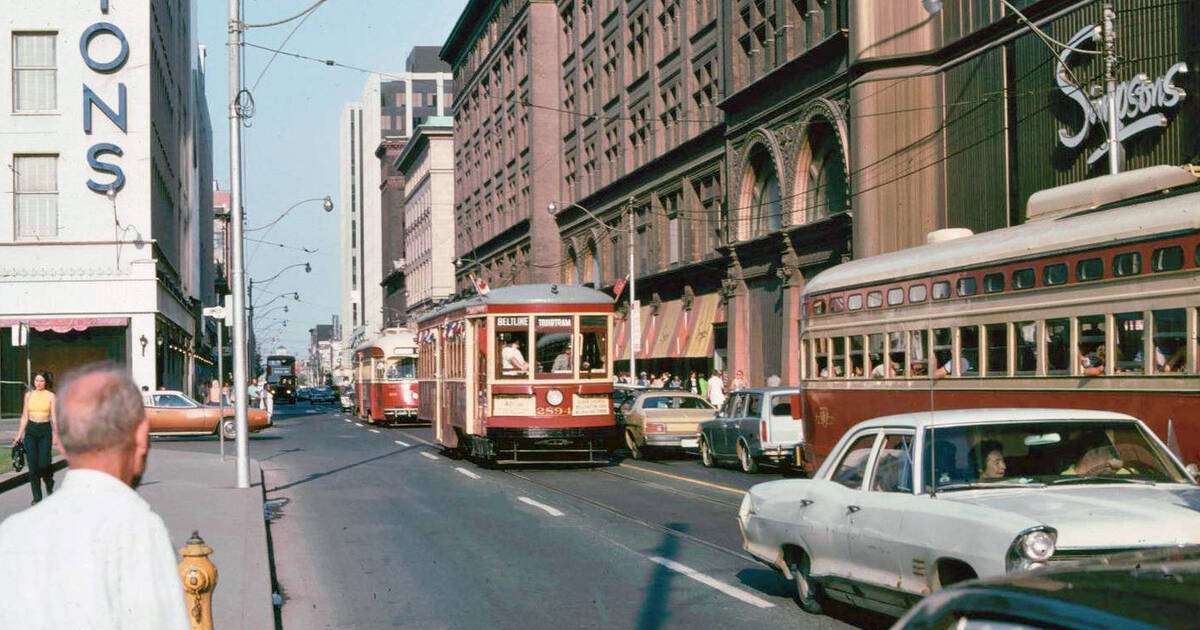
The department store in Toronto might not be dead, but it sure has changed in the last few decades. Gone are the days when a diverse array of companies battled it out for consumers who expected to buy just about everything under the sun in such stores.
Before the death of Eaton's in the 1990s, the department store wars involved many more players.
If you've been around long enough, you'll remember names like Kresge (later K-Mart), Simpson's, Woolworth, Woolco, and Morgans, not to mention discount shops like BiWay, Bargain Harolds, Towers, and the much loved Zellers.
Through the 1980s, the retail economy had yet to centralize in massive corporations to the degree that it has now.
There were the big players like Eaton's, Sears, Simpson's, and the Bay at malls across the city, but despite their reach, they never came close to the size, sprawl, and buying power of big box stores like Walmart and Costco.
It's hard not to look back at these store's with a bit of nostalgia. These were, after all, the places where a kid's dreams came true in the toy department.
In the days before the internet made consumer choice endless, these retail hubs were repositories of desire, as evidenced by the advertisements of the time.
Behold, what department stores used to look like in Toronto.
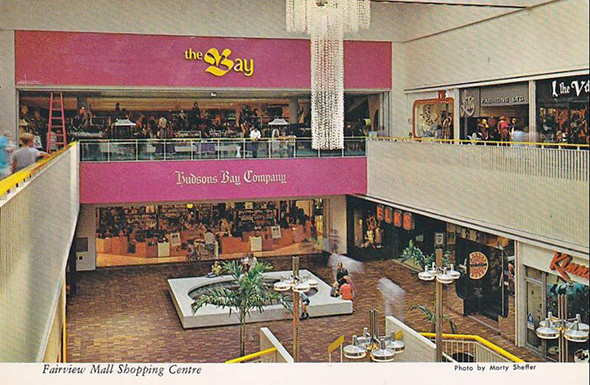
The Bay at Fairview Mall.
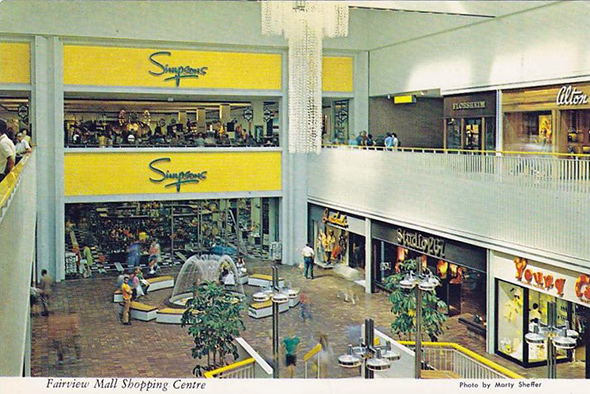
Simpson's at Fairview Mall.
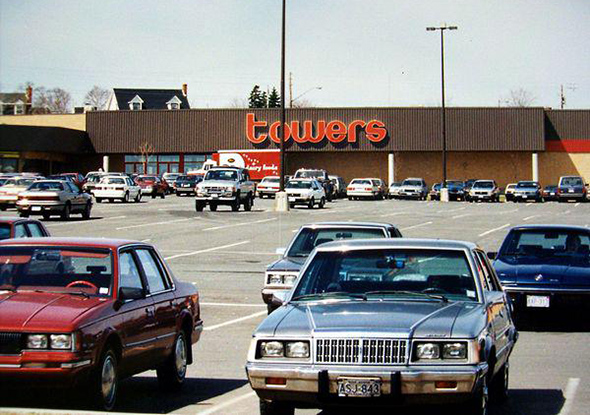
Towers at Midland and Lawrence.
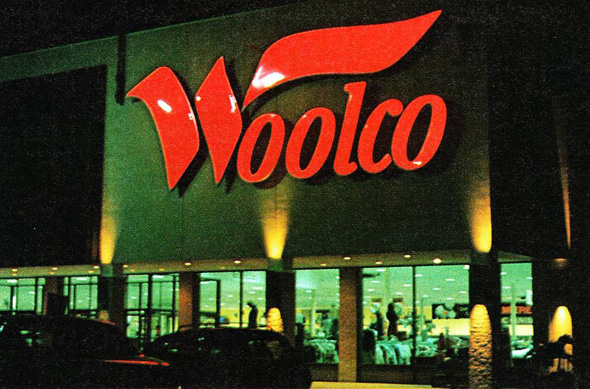
The mighty Woolco.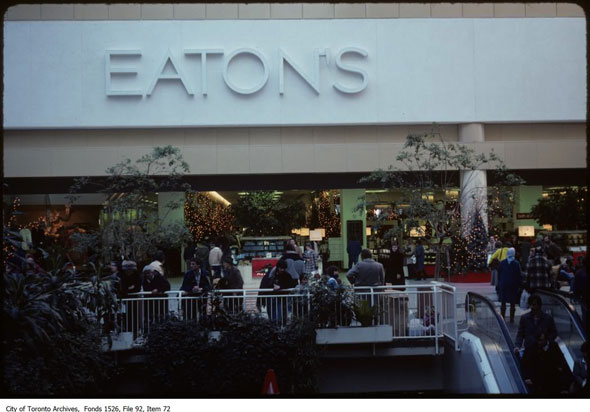
Eaton's at the Eaton Centre in the 1990s.
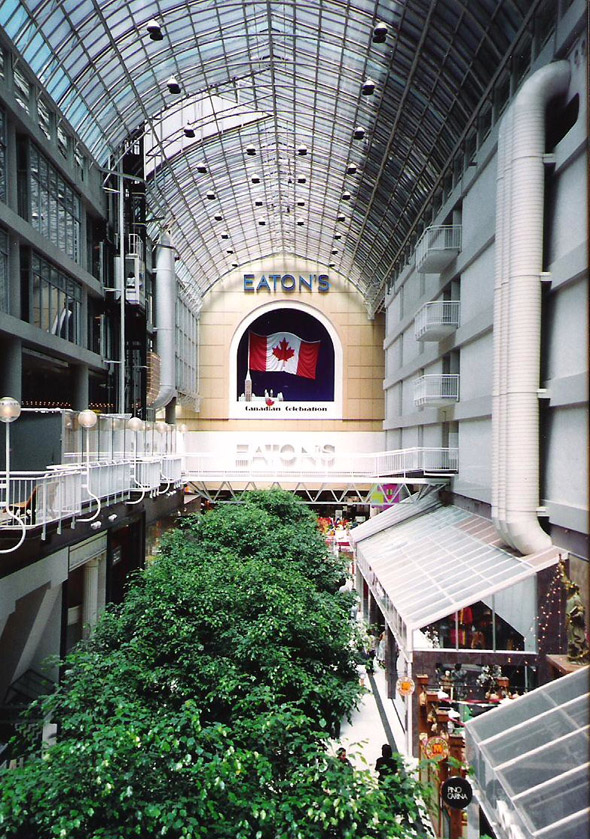
Wide view of the anchor Eaton's at the Eaton Centre.
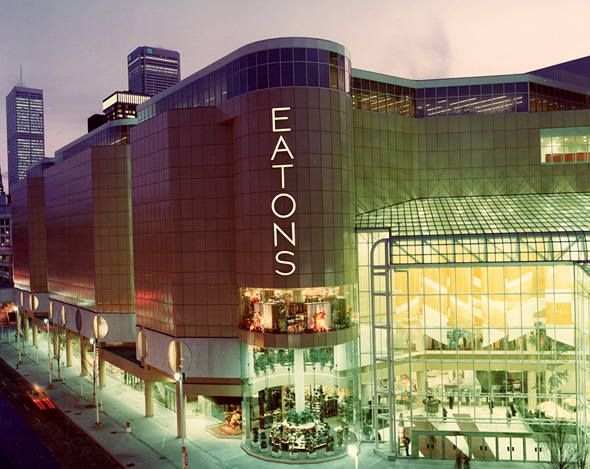
The Yonge and Dundas entrance to Eaton's in the late 1970s.
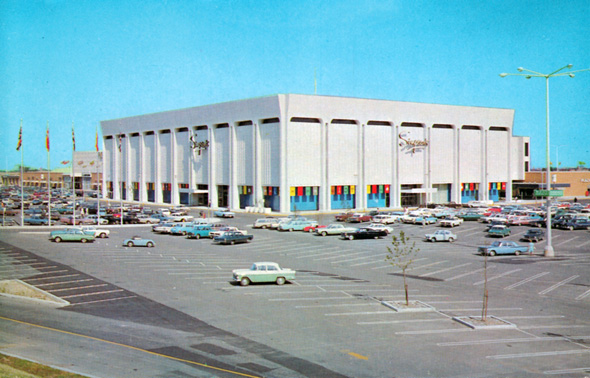
Simpson's at Yorkdale Mall.
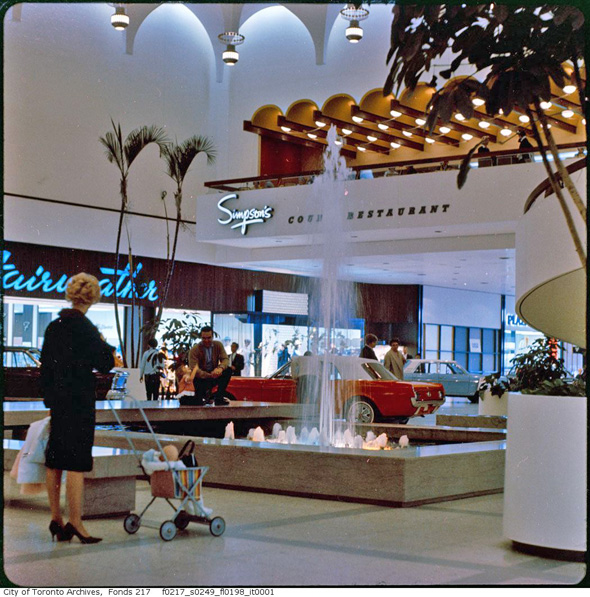
Entrance to Simpson's at Yorkdale in the 1970s.
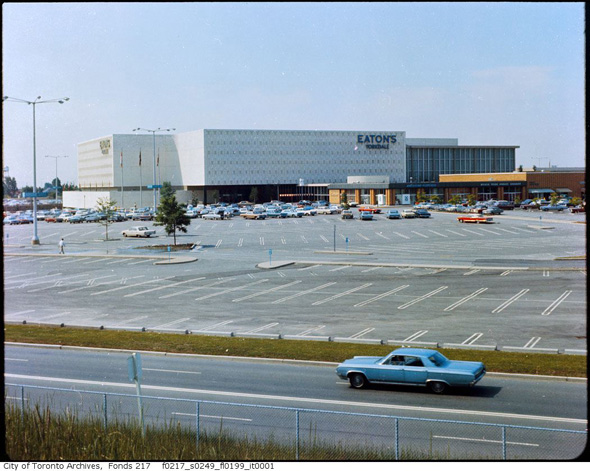
Eaton's at Yorkdale Mall in 1965.
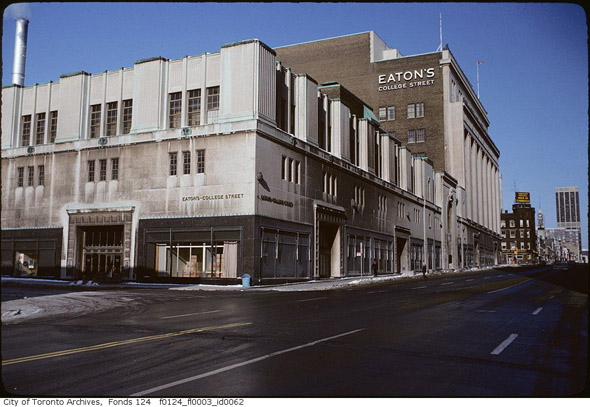
The Eaton's location at College Park.
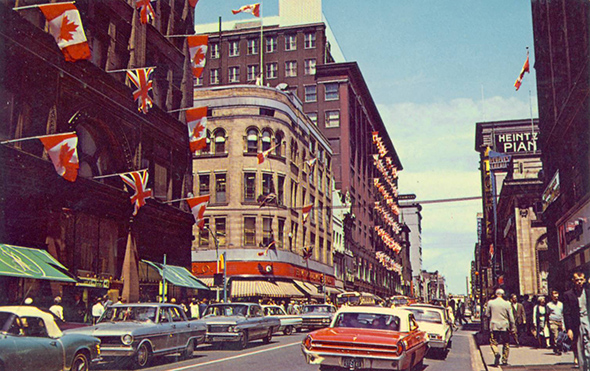
Woolworth flagship at Yonge and Queen streets.
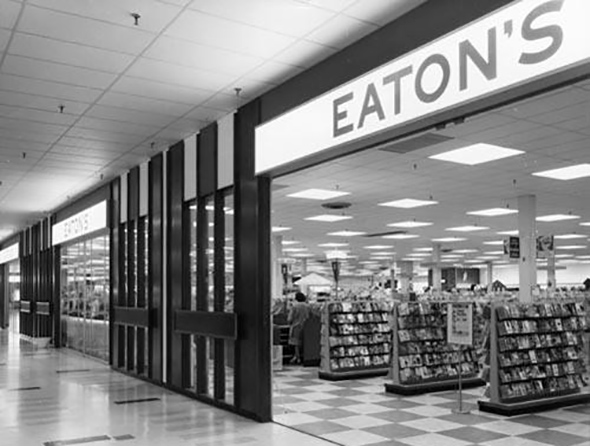
Eaton's at Shopper's World.
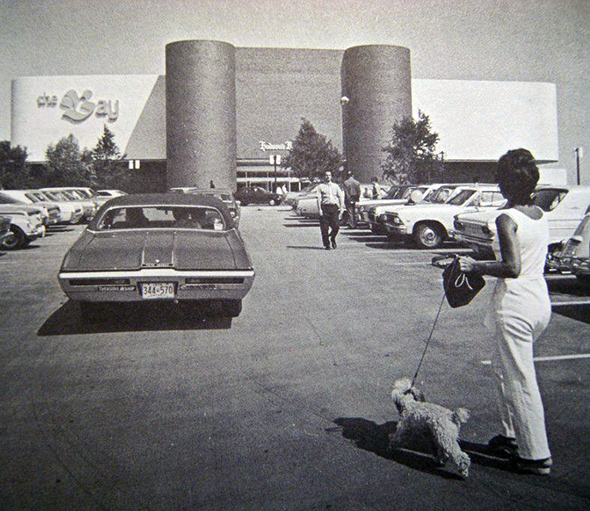
The exterior view of the Bay at Fairview Mall.
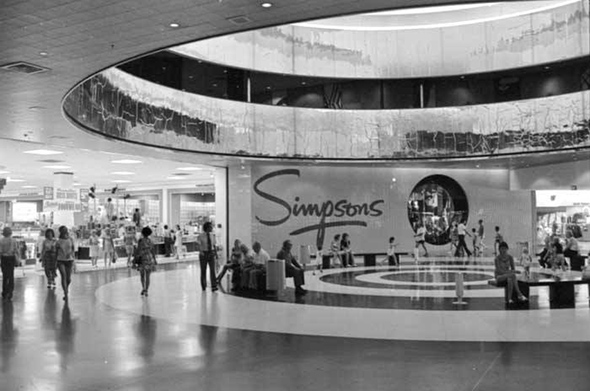
Simpson's location at Sherway Mall.
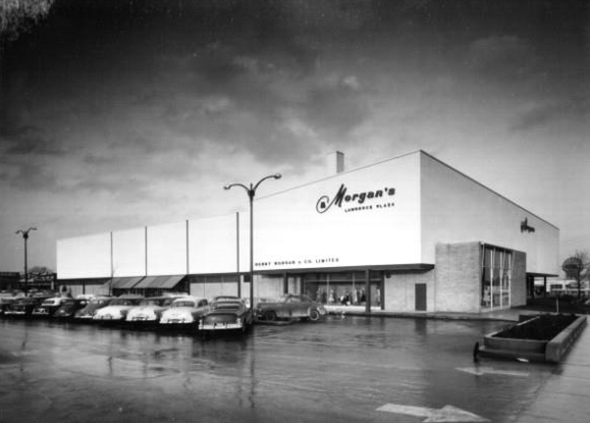
Morgan's Department Store at Lawrence and Bathurst.
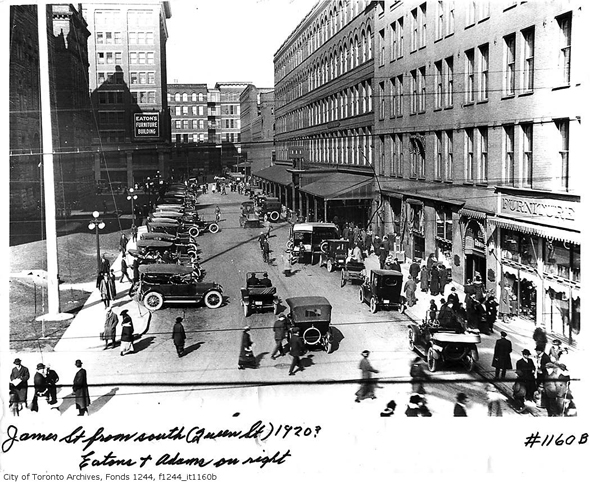
The old Eaton's at Queen and James streets.
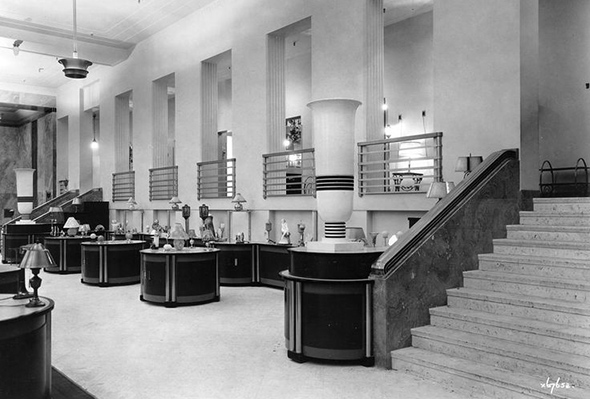
The opulent interior of Eaton's at College Park ca. 1940s.
Everyday life along the Berlin Wall, 1985-1986
Inside Information: Cross-Sections of Retro Technology Reveal Historical Moments of Iconic Objects

The distinctive Arriflex 35 IIC is one of the most significant motion picture cameras of all time, and a favourite of the Hollywood new wave of cinematographers of the 60’s ad 70’s. The hand held camera was famously beloved by Stanley Kubrick whose 1971 cult classic, A Clockwork Orange, was shot almost entirely on the Arri 35 IIC.
As part of an ongoing series titled Inside Information, UK-based design studio Dorothy explores some of the most iconic designs in the areas of film, music, personal computing, and fashion through clever “cutaway” infographics. Each illustration reveals a miniature isometric world packed with historical moments from famous concerts that used the Vox AC30 amplifier to films that utilized the Arriflex 35 IIC handheld camera, which transformed movies forever. All five of the Inside Information graphics are available as three-color litho prints on its website. (via Colossal Submissions)


Released in 1959 to meet the demand for louder amplifiers, the Vox AC30 was quickly adopted as the amp of choice for bands like The Beatles, The Kinks and The Stones, helping to define the sound of the ‘British Invasion’ when the popularity of British rock ’n’ roll bands spread to the States. Its appeal has continued through the decades with bands like Queen, U2, The Smiths, Oasis, Blur, Radiohead, Arctic Monkeys all counted as loyal Vox fans.


The Nike Air Max is a bona fide design classic. Designed by Tinker Hatfield and released in 1987 it has, in its 30 plus years of existence, established a cult following. Inspired by the architecture of the Centre Pompidou, it was the first trainer to offer a window to the sole, kickstarting a revolution in sneaker design.


The Minimoog was the world’s first portable (and affordable) synthesiser. Billed as ’The Moog for the road’, it revolutionized music, acquired a cult-like following (which it still enjoys to this day) and quickly became the most popular synth of its time.


The Apple Macintosh (later know as the Macintosh 128k) was launched with an Orwell inspired commercial directed by Ridley Scott, and introduced to the world by Steve Jobs on 24th January 1984. It blew our tiny little minds and for many heralded the beginning of a lifelong love affair with all things Apple.

Elegant Portraits Highlight the Feathery Features of Leila Jeffreys’ Perfectly Posed Birds

“The Tweets.” All images © Leila Jeffreys, shared with permission
Those of us who’ve been party to an awkward family photoshoot or embarrassing school picture have reason to feel envious of the birds Leila Jeffreys (previously) photographs. From a pair of stoic budgerigars to a yellow trio named “The Tweets,” the avian subjects are captured in sophisticated and graceful poses that highlight their most stunning features, from the curvature of their beaks to the singular barbs of their feathers.
Jeffreys often teams up with conservationists, ornithologists, and sanctuaries to determine her subjects before bringing them to a studio. When they’re together, the Australian photographer focuses on their personalities, hoping to capture their idiosyncratic tendencies. The result is intimate and engaging photographs at a human-scale, a choice that strays from traditional portraiture by centering a different species.
Many of the elegant portraits here are included in Jeffreys’ recently released book, Des oiseaux, and you can explore a larger collection of photographs available for purchase on her site. Otherwise, keep up with her feathered frames on Instagram and watch this arresting footage of the birds in action.

“River and Cloudy”

“Rain and June”

“Celery”

“Coral”

“Candle”
Richard
(AUTHOR NOTE: My publisher told me I could post a chapter from the new book. There were 25 chapters to choose from, but I chose this one. Because I wanted to give you a love letter. And it seemed like the most appropriate love letter to give you would be an extremely indirect one that screams, "DO NOT FEEL SCARED—I AM JUST INTERACTING WITH YOU!!")
---------------------------------
For the first few years of my life, the only people I knew how to find lived in my house.
A concrete objective never emerged, but the missions became bolder and more frequent. I started bringing things back with me. Richard's things.
And I said:
"Hanging out with Richard."
The spider was supposed to be Richard. I hadn't figured out how many arms and legs people are supposed to have yet, so I just put a whole bunch on there and hoped it was enough. I didn't want him to feel offended because I shortchanged him on legs.
The thing that finally blew my cover was stealing Richard's cat.
Stealing it wasn't the original plan. The opportunity presented itself, I seized it.
And now it is time for a quick fact about cats: cats aren't good secrets, because, under extreme duress, they have the ability to make a sound like:
YAOAOAOAOAOAOAOAOAOAOAOAOAOAOAOAOAOAOAOAO
My parents eventually realized the sound was coming from inside the house and located the source of it.
They confronted me after a strategy meeting about how the fuck to handle this. That's not something the books prepare you for. There's no chapter on what to do if you suspect your child is a predator. There's no Hallmark card for "Sorry we accused you of being a molester; we didn't realize our kid was sneaking into your house and stealing your spoons and animals and watching you while you sleep. We're really, really sorry."
That primal instinct I'd felt in Richard's garage flickered back online a little bit. Looking at the objects, and the freaked out cat, and my parents' confused faces, I realized that yeah, maybe this had been a weird thing to do....
So we all just stood there, feeling weird about ourselves and each other.
A Plant Overruns an Incredibly Intricate Cardboard Universe for Robots by Greg Olijnyk

All images © Greg Olijnyk, by Griffin Simm, shared with permission
Until now, Greg Olijnyk’s cardboard robots have been poised for adventure, whether perched on a speed bike or sailing an undulating sea. His meticulously crafted universe, though, has taken an eerie and slightly dystopic turn. The Melbourne-based artist presents fully articulate robots lying on an operating table and attempting to wrangle an aloe plant bound to a cage. Complete with LED lights and glass where necessary, the latest iteration even features an illustrated danger sign, warning that the plant will soon breach its enclosure.
To follow the latest sculptures in Olijnyk’s science-fiction inspired reality, head to Instagram, where he shares process shots and videos of the robots in action.









Translucent Sculptures of Segmented Glass by Artist Jiyong Lee Evoke Single-Celled Organisms

“Green Cosmarium Segmentation” (2018), hot sculpted, cut, color laminated, carved, glass, 7 1/4 × 10 × 7 1/4 inches. All images © Jiyong Lee, shared with permission
Fascinated by the organisms found in the sea and bodies of freshwater, artist Jiyong Lee (previously) sculpts semi-transparent artworks that evoke the various forms of algae and other microscopic creatures. The segmented pieces, which are composed of smooth, matte glass, create both organic and geometric shapes. Part of an ongoing Segmentation Series, the composite works consider the evolution of a single cell, which Lee expands on:
I work with glass that has transparency and translucency, two qualities that serve as perfect metaphors for what is known and unknown about life science. The segmented, geometrical forms of my work represent cells, embryos, biological and molecular structures—each symbolizing the building blocks of life as well as the starting point of life.
Lee is based in Carbondale, Illinois, where he teaches at Southern Illinois University, and many of the pieces shown here will be part of a group show at Duane Reed Gallery in St. Louis from September 12 to October 17, 2020. The artist also was chosen as one of 30 artists for the Loewe Foundation’s Craft Prize, which will bring him to Paris for an exhibition in the spring of 2021. Until then, explore more of Lee’s biology-informed sculptures on Artsy.

“Mitosis” (2010), cut, color (white) laminated, carved glass, 8.6 x 13 x 14 inches

“Diatom segmentation” (2019), cut, color laminated, carved, hot formed glass, 7 x 10 x 7 inches

“Black and White Diatom Segmentation” (2020), hot sculpted, cut, color laminated, carved, glass, 8 × 12 × 8 inches


Left: “Gray Diatom Segmentation” (2018), cut, color laminated, carved glass, 5 1/4 × 12 1/2 inches. Right: “Yellow Orange Diatom Segmentation” (2020), hot sculpted, cut, color laminated, carved, glass, 7 1/2 x 10 x 8 1/2 inches

“Green Yellow Diatom Segmentation” (2020), hot sculpted, cut, color laminated, carved, glass, 5 3/4 × 12 × 12 inches

“White Green Diatom Segmentation” (2020), hot sculpted, cut, color laminated, carved, glass, 8 1/2 × 10 × 8 1/2 inches
John Vachon’s Chicago in candid photos, 1941
This is what Toronto looked like in the 1950s in colour photographs

Toronto was a quieter place in the 1950s. Our skyline was made up of a handful of buildings from the 1930s, our brick buildings were stained with soot from the industry that still dominated our waterfront, and you couldn't get a drink or go shopping on Sundays.
Yes, there was a time when this was a downright sleepy town.
That said, Toronto was already starting to change in the 50s. It would take a decade or two for these little seeds to blossom into the type of full scale transformation the city experienced in the late 1960s and early 70s, but the signs are there.
In these photos you see the birth of the subway and the suburbs, tidy downtown streets that are about to explode with neon signs and taller developments.
While Kodak released colour film in the late 1930s, it wasn't until the 1960s that its use became widespread among amateurs. As such, the collection of colour photographs of Toronto from the 1950s is tiny compared to that of the decade that followed.
Perhaps because of this, they provide an alluring glimpse of a cheerful if somewhat boring city on the brink of great change.
The images below represent a mix of photographs, postcards, and other marketing materials that were deemed important enough at the time to be produced in colour.
Behold, the Toronto of the 1950s in vivid colour.
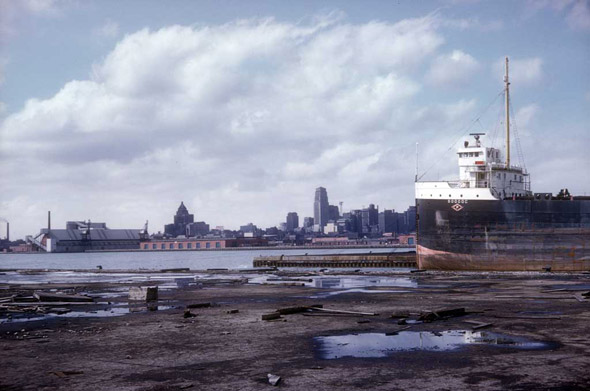
The Toronto skyline in 1956. Photo by PJs Deceased.
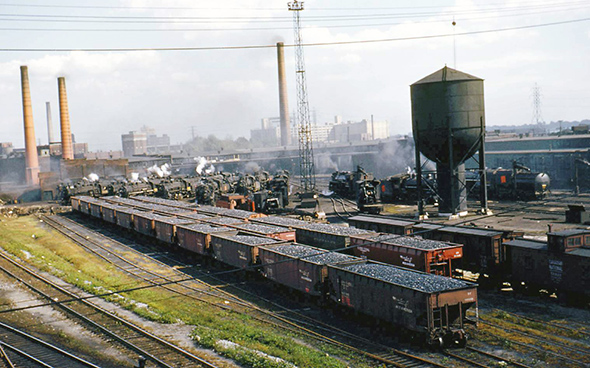
The massive railway lands before the CN Tower and condo developments. Photo via Chuckman's Nostalgia.
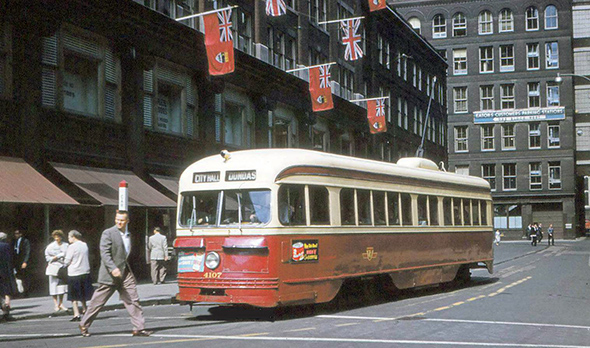
James and Albert streets. Photo via Chuckman's Nostalgia.
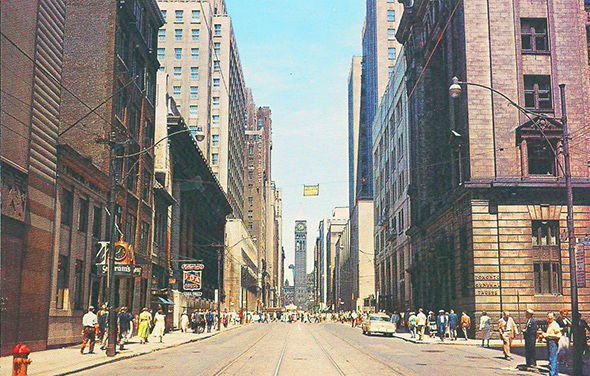
Postcard view looking up Bay toward Old City Hall.
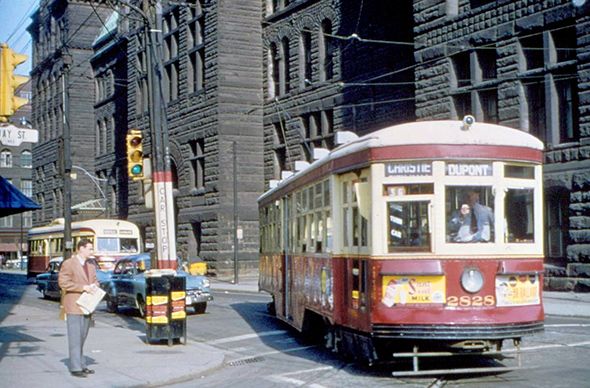
Old City Hall and Peter Witt streetcar. Photo via Chuckman's Nostalgia.
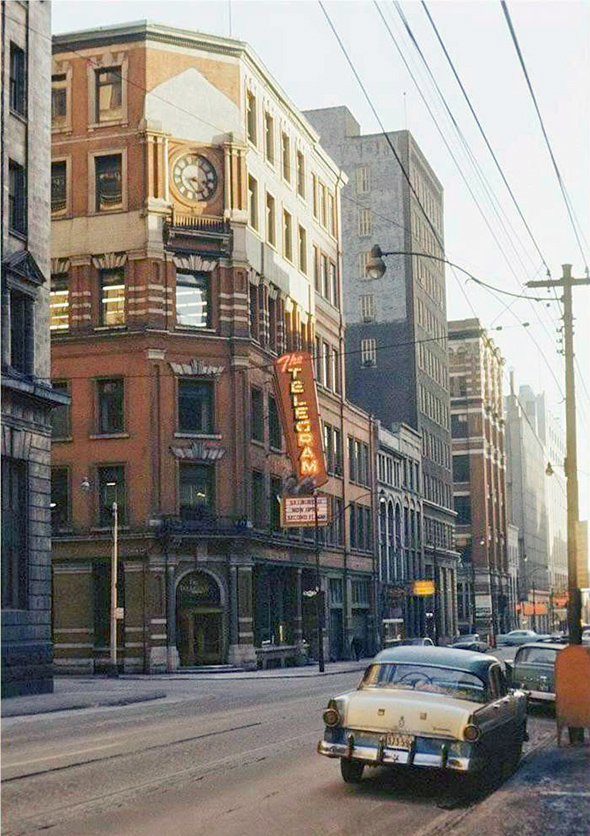
Toronto Telegram Building at Bay and Melinda streets.
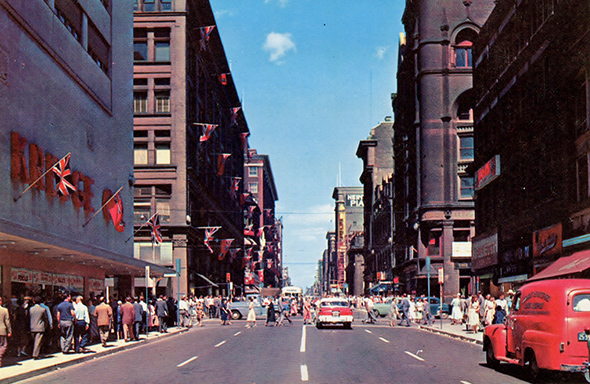
Postcard view looking up Yonge St. north of Queen St.
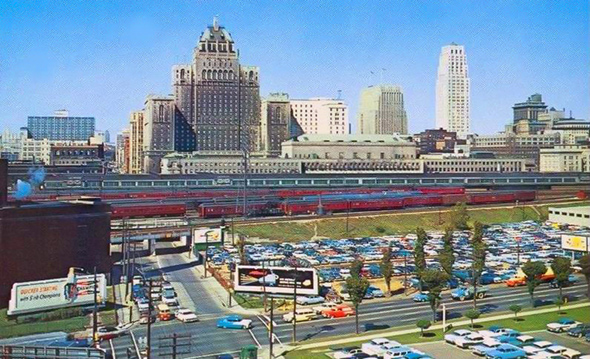
Postcard view of the pre-sign Royal York.
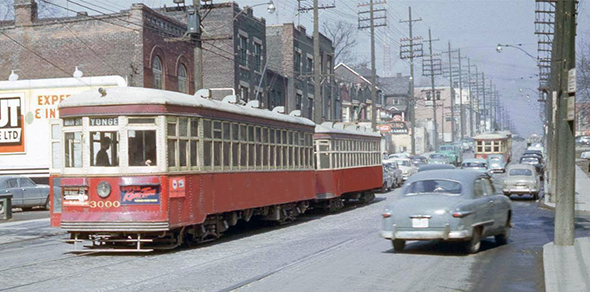
Yonge St. near Summerhill. Photo via John Bromley's Archives.
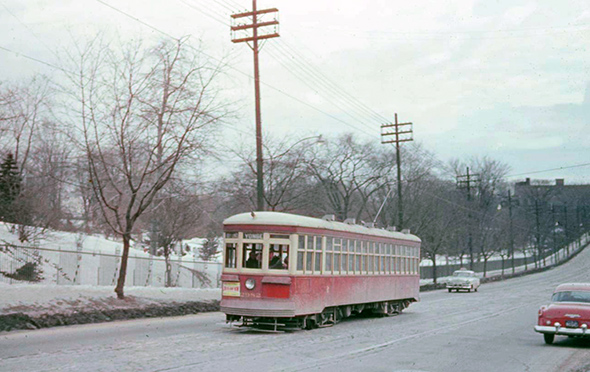
A streetcar passes Mt. Pleasant Cemetery on Yonge St. pre-subway. Photo via Chuckman's Nostalgia.
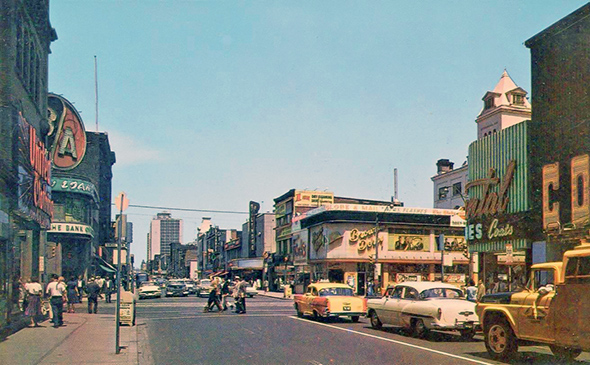
Postcard view looking north to Yonge and Dundas.
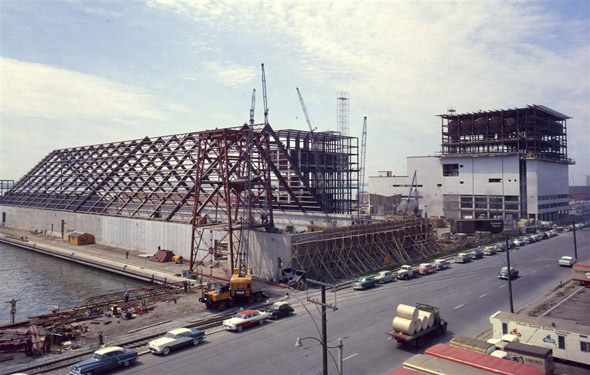
Redpath Sugar under construction on Queens Quay. Photo via the Wikimedia Commons.
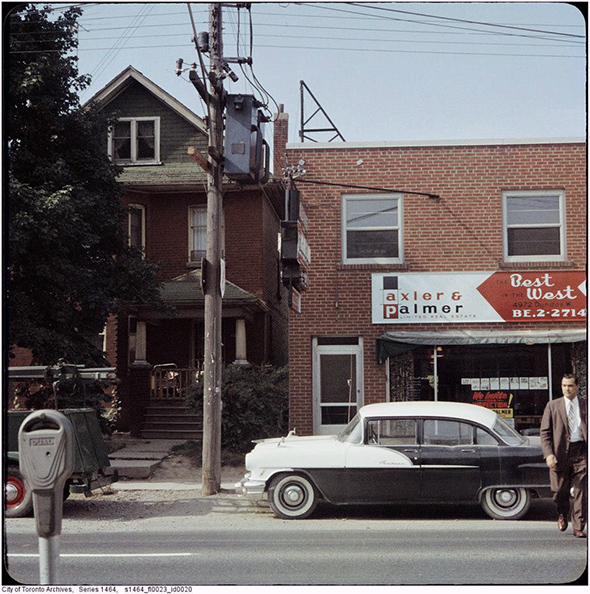
4972 Dundas West. Photo via the Toronto Archives.
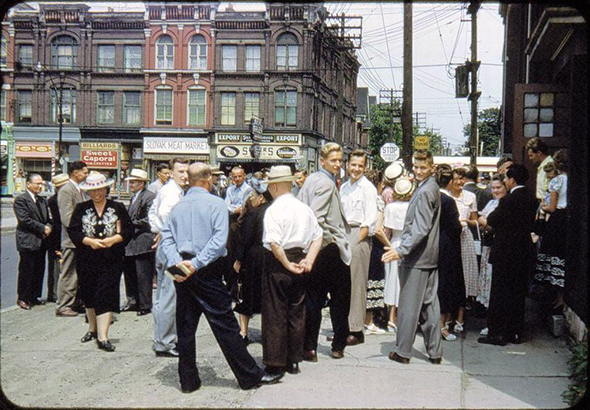
People getting out from Sunday service. Photo via the Toronto Archives.
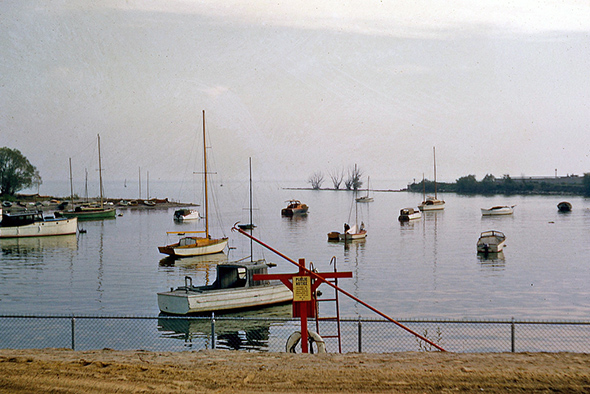
The quiet Toronto waterfront (likely Ashbridges Bay). Photo via the Wikimedia Commons.
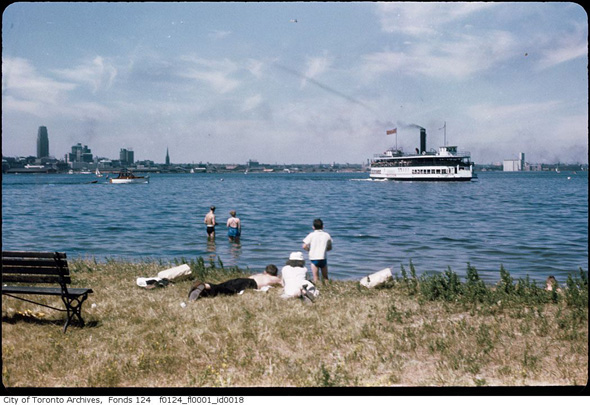
Toronto harbour and ferry in the late 1950s. Photo via the Toronto Archives.
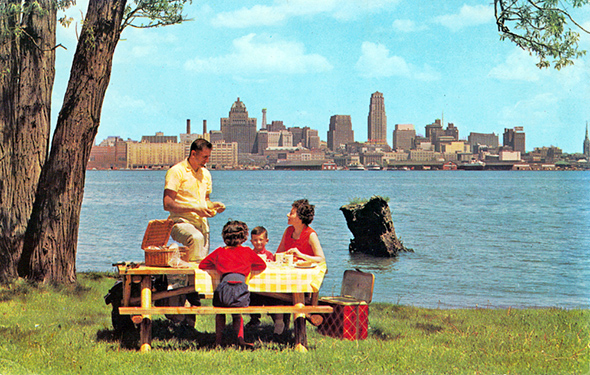
Postcard view of a picnic on the Toronto Islands.
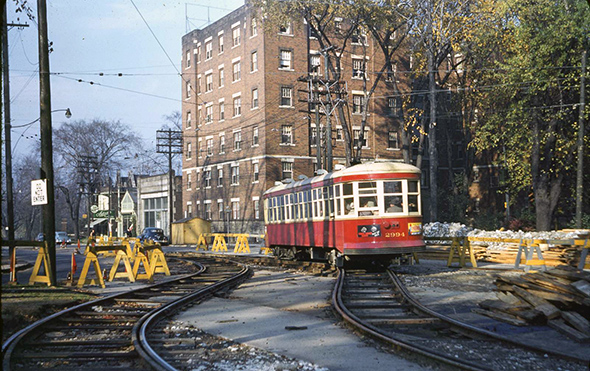
A Peter Witt streetcar near Yonge and Lawton. Photo via Chuckman's Nostalgia.
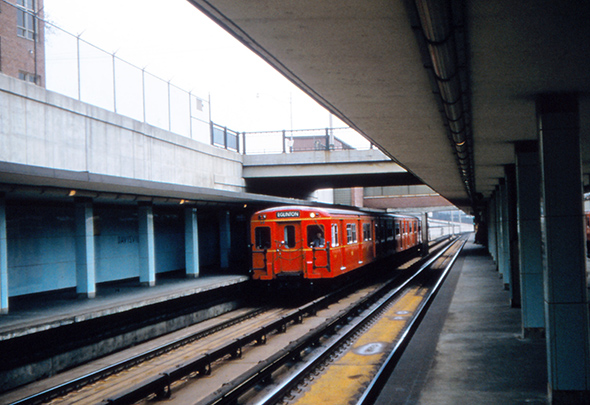
Davisville Station in 1956. Photo via Transit Toronto.
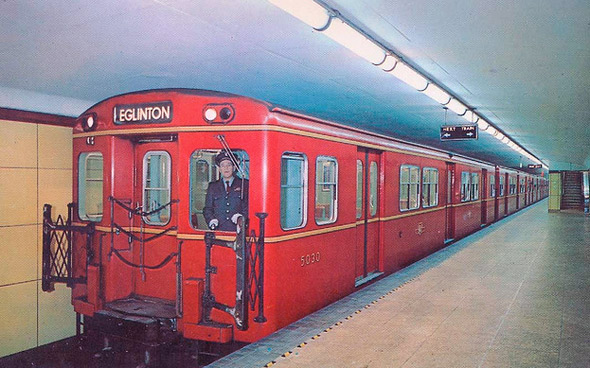
Postcard view of Gloucester train at King Station.
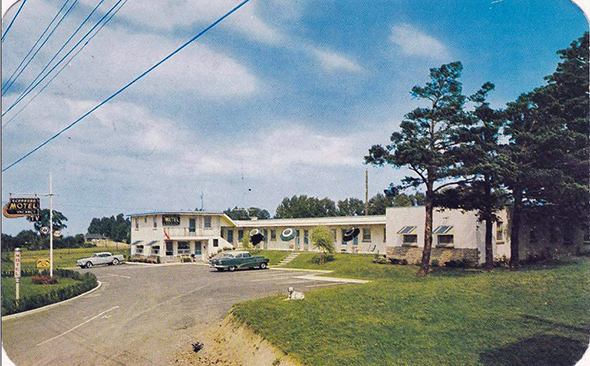
Postcard view of the Scarboro Motel, 1950s.
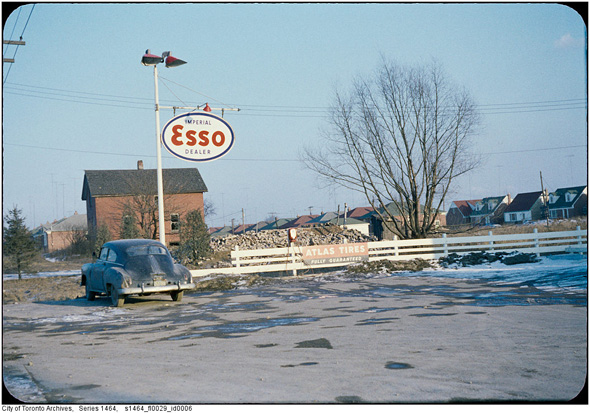
Rexdale in the late 1950s. Photo via Toronto Archives.
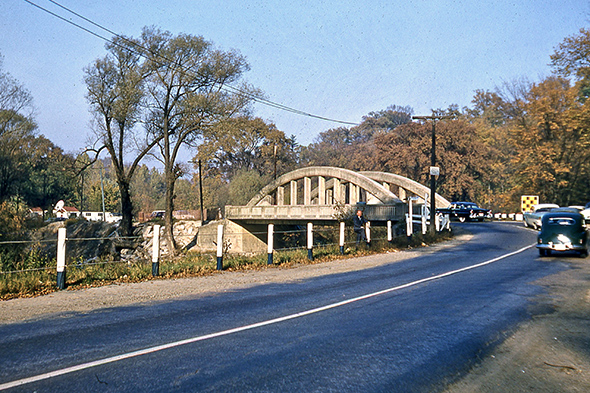
Old Don Mills Rd. Bridge (now part of the bike trail system). Photo via Chuckman's Nostalgia.
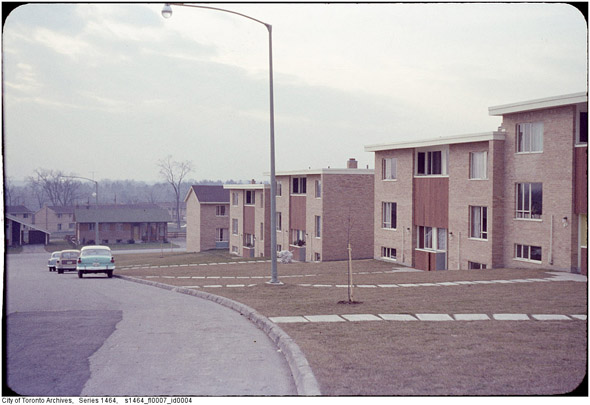
The birth of Don Mills. Photo via the Toronto Archives.
The history of the Danforth Music Hall in Toronto
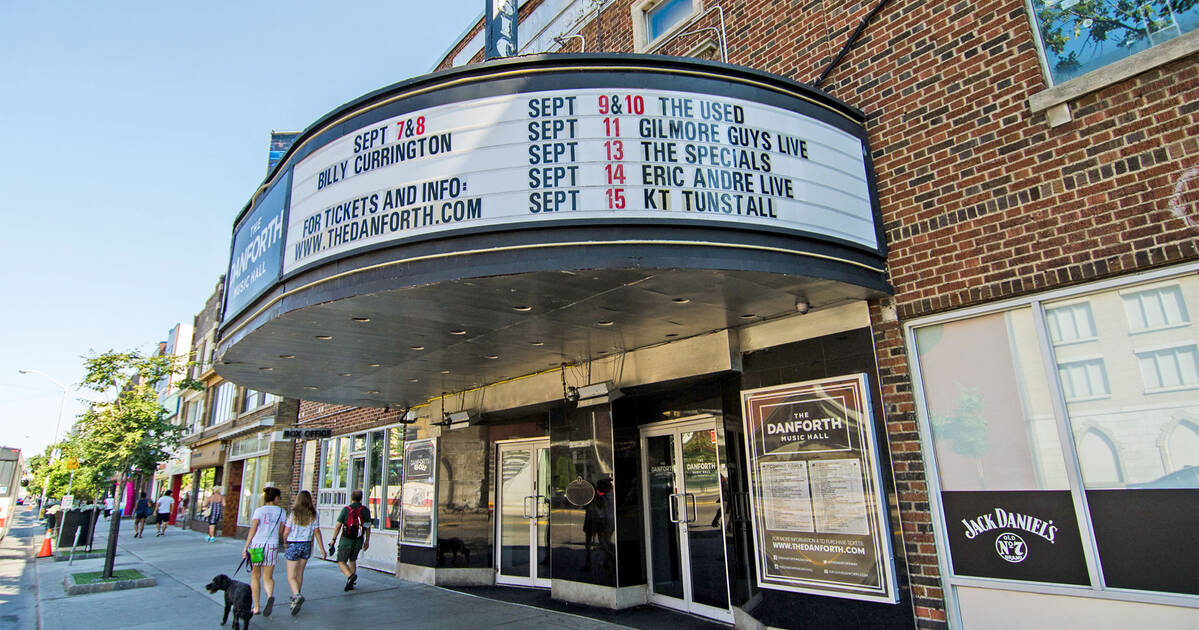
The Danforth Music Hall has established itself as one of the top venues in Toronto of its size. While it's had its ups and downs over the decades, it has lasted through periods of neglect, to emerge as a great-sounding live room with good sight lines.
It's easy to forget that for the majority of its existence, the building's primary purpose had very little to do with live music.
When it was originally erected in 1919, it was called Allen's Danforth, and was part of the rapidly growing Allen movie theatre chain.
The construction of the Prince Edward Viaduct a year earlier had brought with it a wave of development in Riverdale, and the area was becoming less of a suburb and more a part of Toronto.
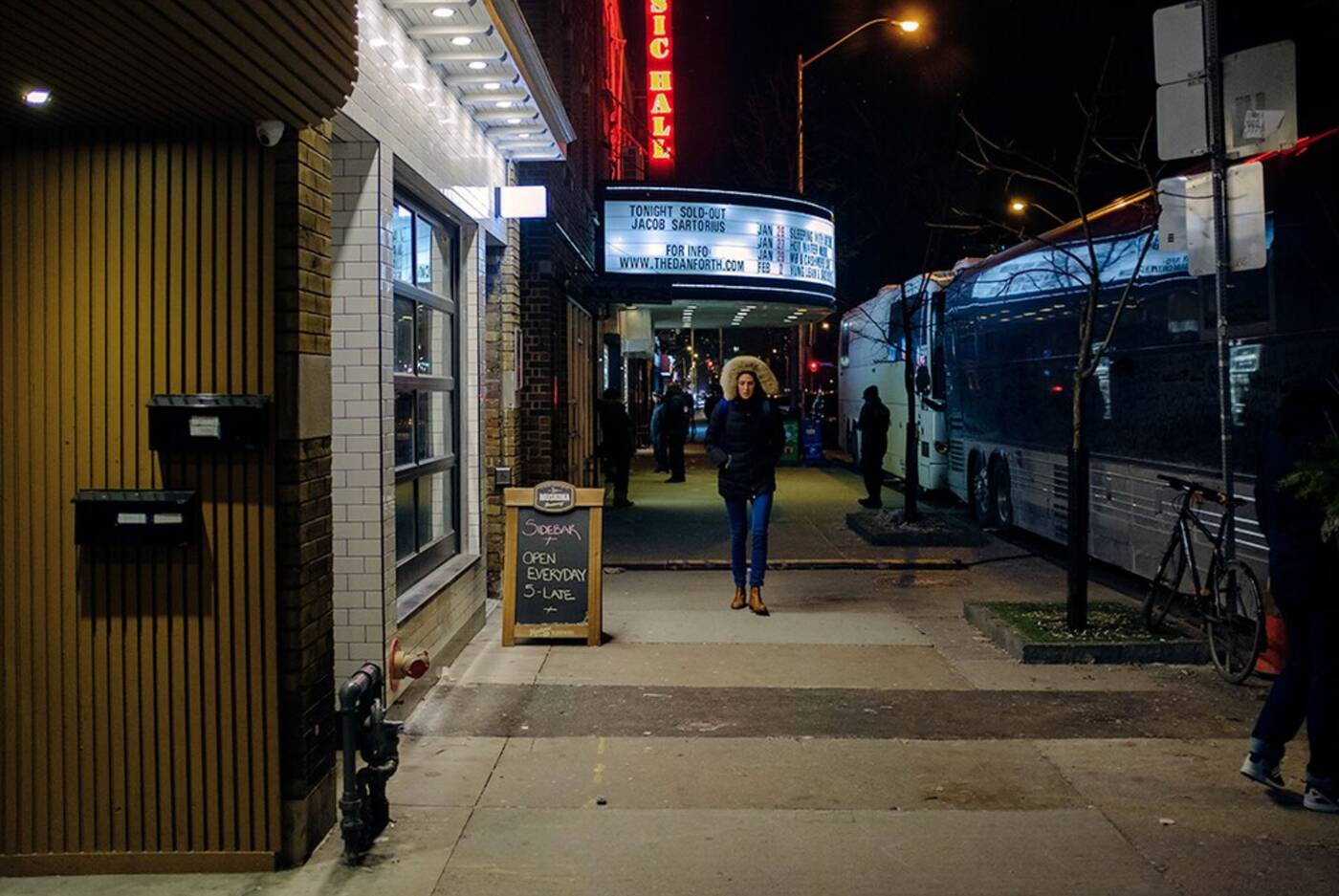
The Danforth Music Hall in 2018. Photo by Dominic Bugatto.
The Allen brothers saw an opportunity, and promoted the theatre as "Canada's First Super-Suburban Photoplay Palace".
Designed by Detroit architecture firm Howard Crane, the building's ornamentation was more restrained than some large theatres of the time, but it was still much larger and more upscale than the existing neighbourhood movie houses in the area.
Before they even opened, three smaller local theatres attempted to petition Queen's Park to deny them a license, out of fear that the competition would ruin their businesses.
But the chain's success was relatively short-lived, and in 1923 Famous Players began buying up most of their theatres, including the Danforth.
It was known as The Century until the end of the '60s, when it became a Greek-language movie palace named the Titania Theatre. (Lee's Palace is the only other former Allen theatre still standing in Toronto.)
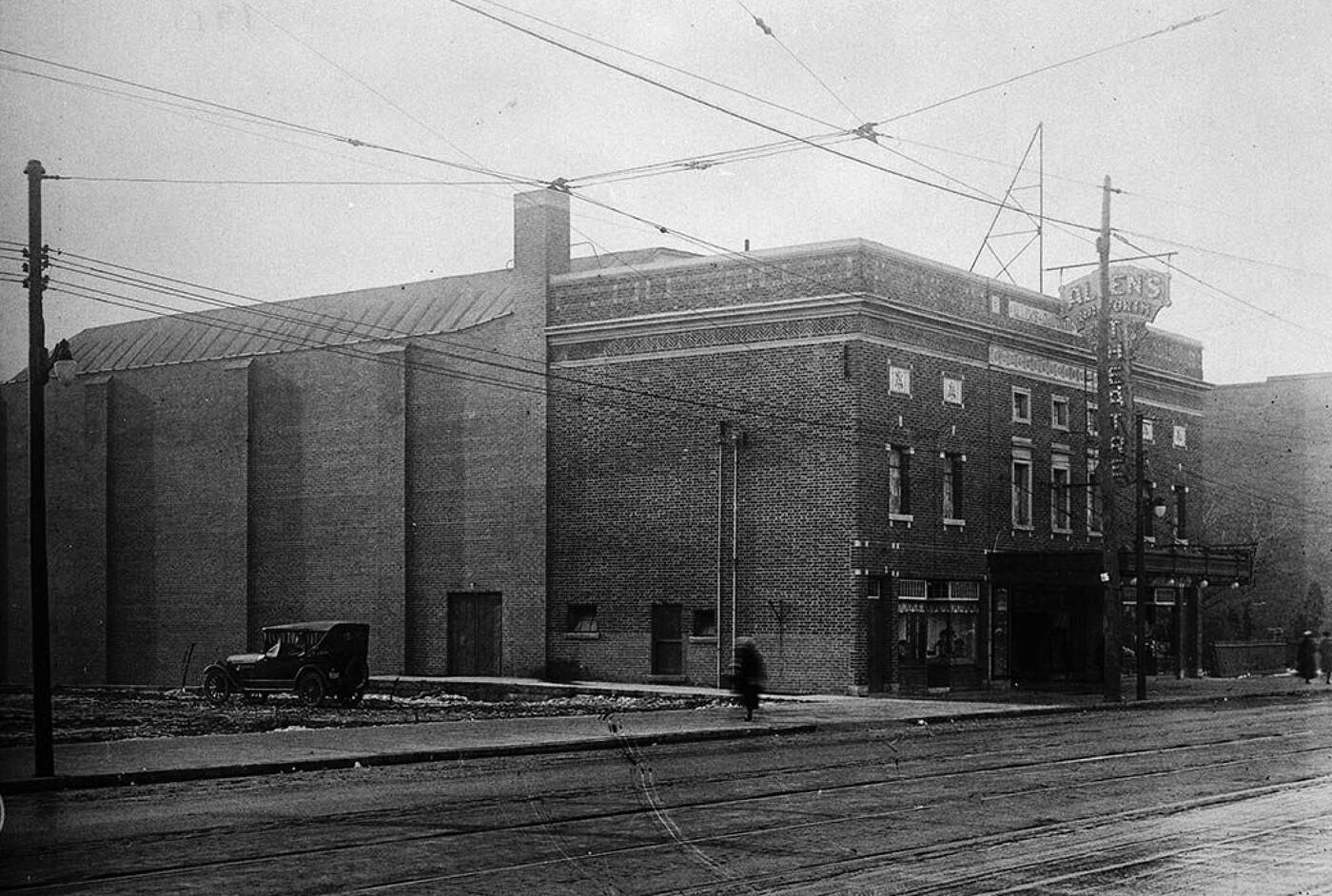
The Danforth Music Hall back when it was a movie theatre. Photo via Toronto Archives.
It wasn't until the late '70s that the Danforth became known for live music. In the early silent movie days, they'd featured live variety shows before the films, but music was definitely not the main attraction.
After being renamed The Music Hall in 1978, the theatre began offering live performances, as well as continuing to show second-run films. This split-personality served it well, and that era saw it hosting big names like James Brown, the Clash, and the Police.
It had become such an institution by 1985 that it was designated a property of historic interest under the Ontario Heritage Act. However, it was also steadily sliding into a sorry state of disrepair, and the roof was becoming infamously leaky. Few were surprised when the hall eventually closed in 2004.
After a year and a half remaining vacant, Ellipsis Leisure Retail Inc. took over the space, and undertook ambitious renovations to re-open the Music Hall.
Things seemed like they were looking up, but in 2010 the owners of the property - Electra Films Limited - evicted the new tenants, as they had fallen behind by $44,857.86 on rent payments.
This opened the doors for Impresario Inc. to take over; they reopened the theatre on December 1st, 2011.
Licensing the entire place made a big impact on the financial viability of the hall, and acoustic issues with the space were dealt with.

Rihanna playing the Danforth Music Hall in 2012. Photo by Jerry Abramowicz.
The new flexibility of removable seating also helped it adapt to a wider variety of types of concerts, like Rihanna's "surprise" 2012 appearance as part of her 777 promotional tour.
Like most long-standing buildings in Toronto, the Danforth Music Hall has continued to shapeshift and adjust to the times. Films might no longer be the focus, but it is still as vital a social and cultural space as it was when the doors first opened close to a century ago.
Dazzling colour photographs of 1970s and 80s Toronto at night
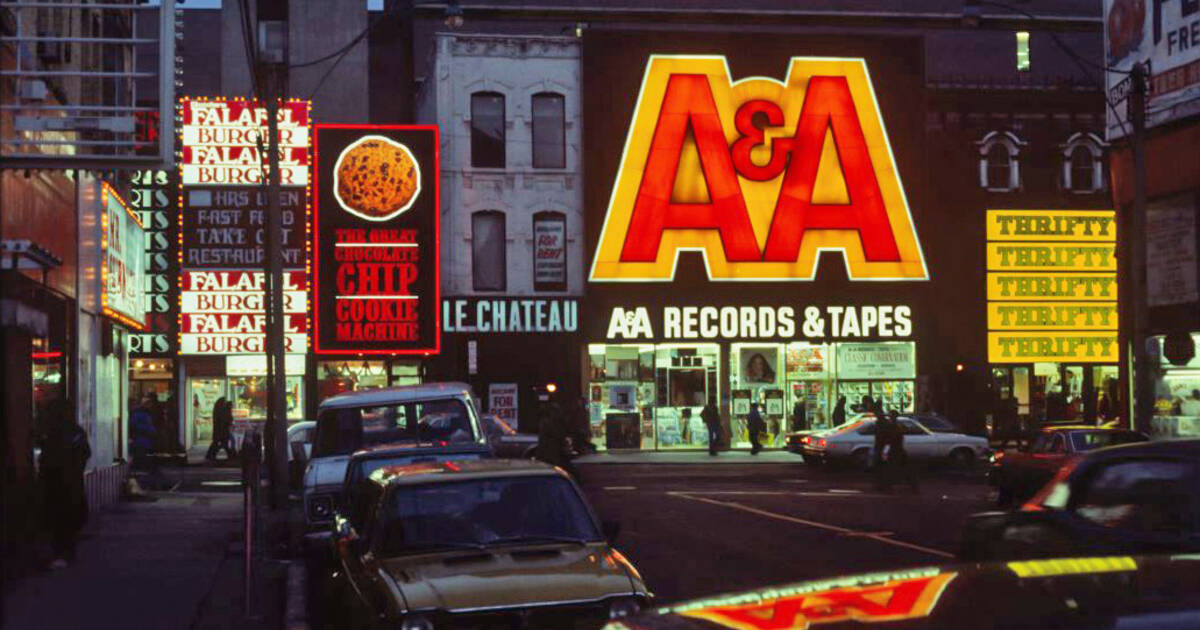
If there's a decade that calls to mind the pure glory of urban night photography, it's the 1970s. For its part, Toronto brimmed with just enough sleaze during this period to get the heart racing when walking down Yonge St. after hours.
By the time the 1980s rolled around, things were starting to clean up, but the proliferation of cameras and high speed colour film meant that more and more people were able to capture the city at night.
When Toronto made good on the description "bright lights, big city," photographers were creeping all over our streets capturing the mood of a messy city that finally liked to stay up late.
Here's what Toronto looked like at night during the 1970s and 80s.
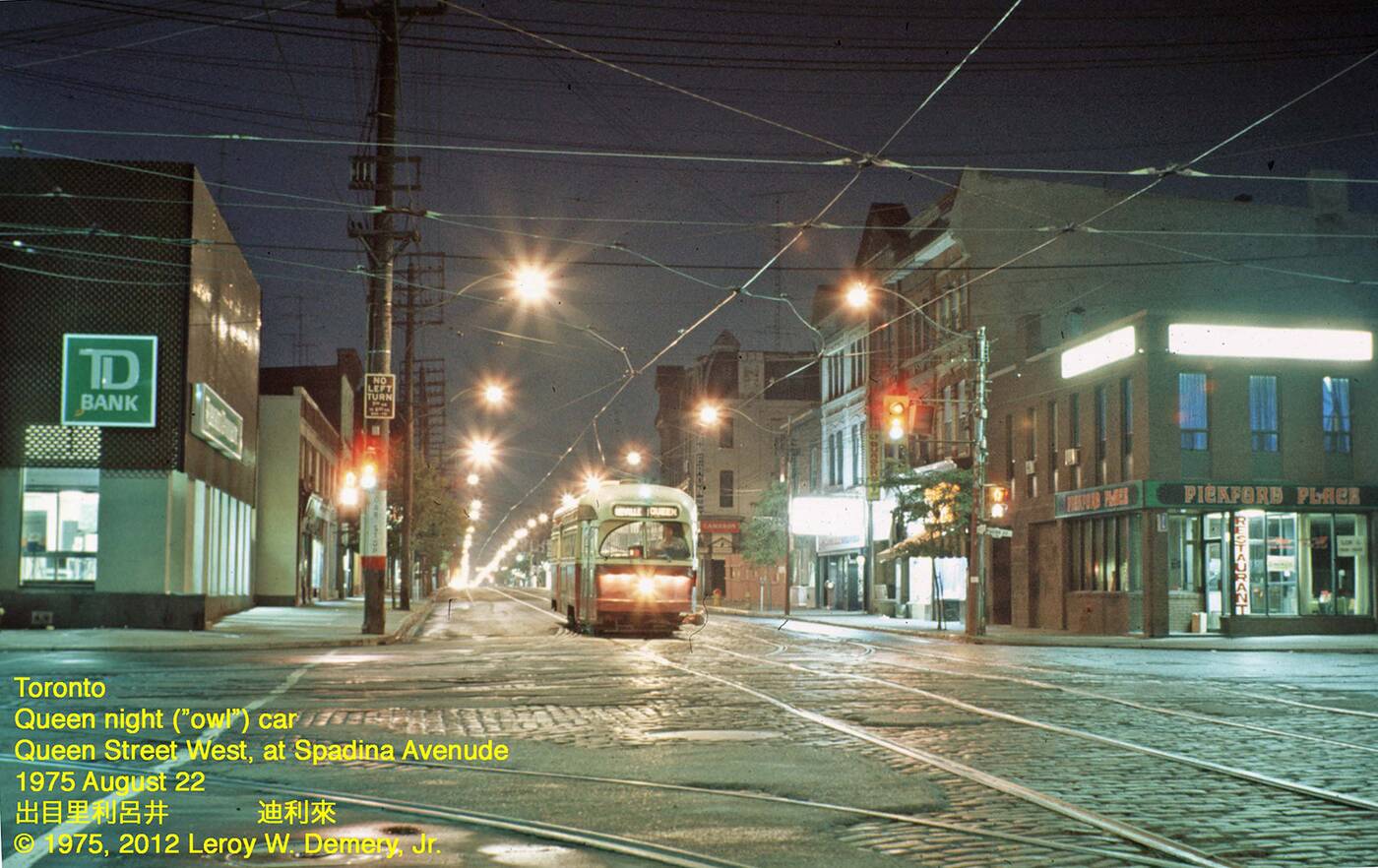
Queen and Spadina before the McDonald's took residence on the northwest corner. Photo by Leroy W. Demery Jr.
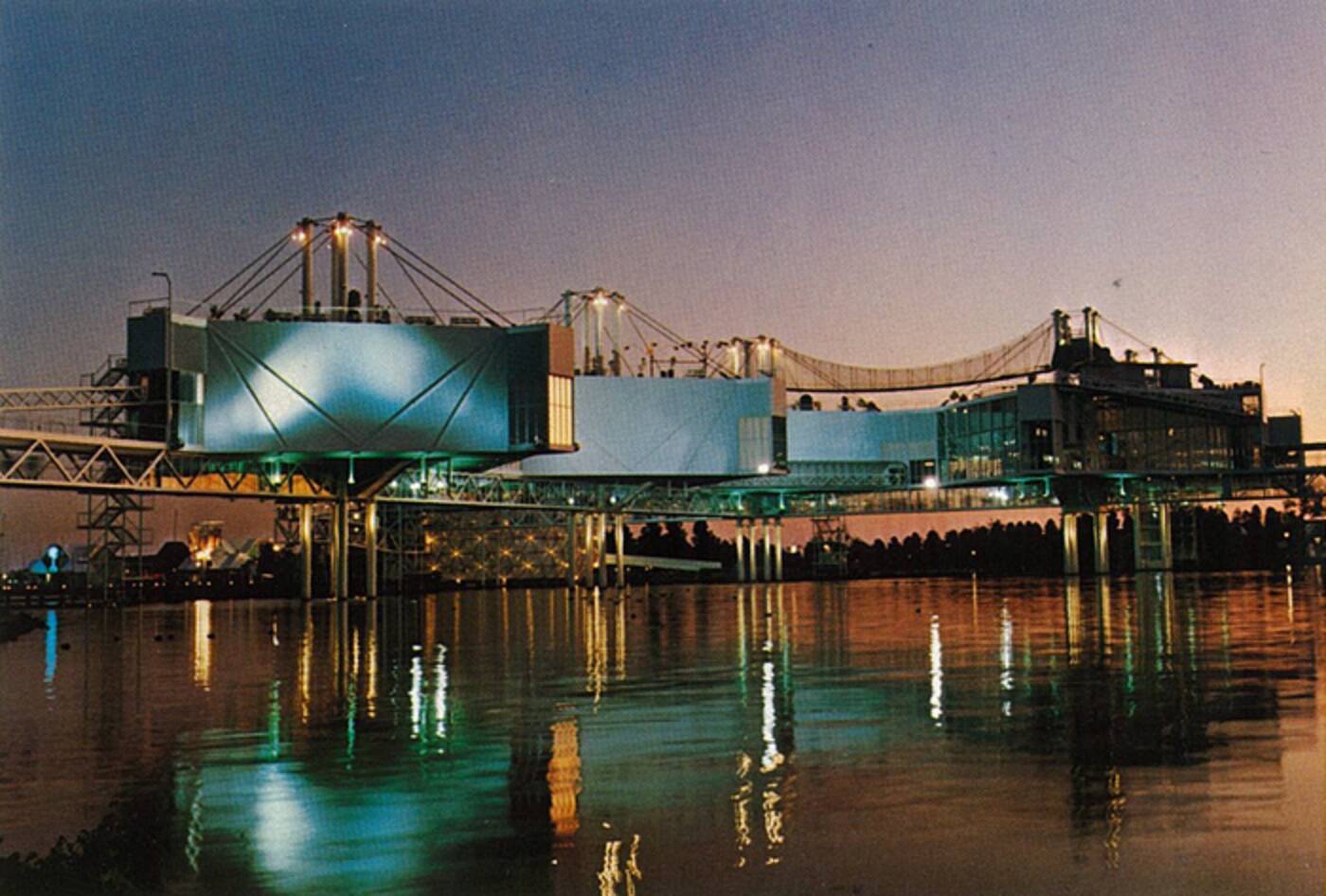
Recently built Ontario Place looking good at dusk.
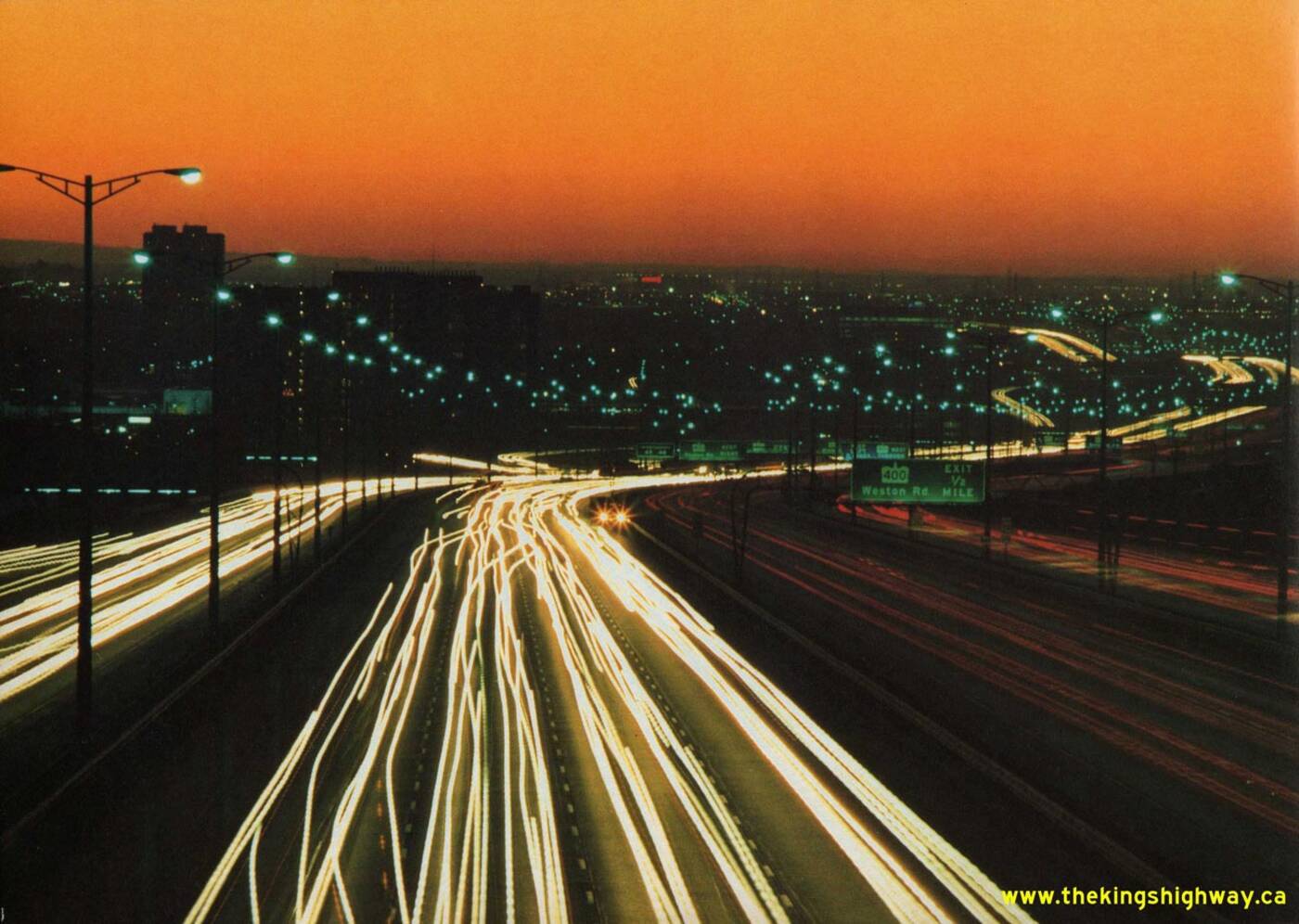
Looking west on the 401 towards Weston Rd. Note the distance is marked in imperial units on the sign to the right. Photo via The King's Highway.
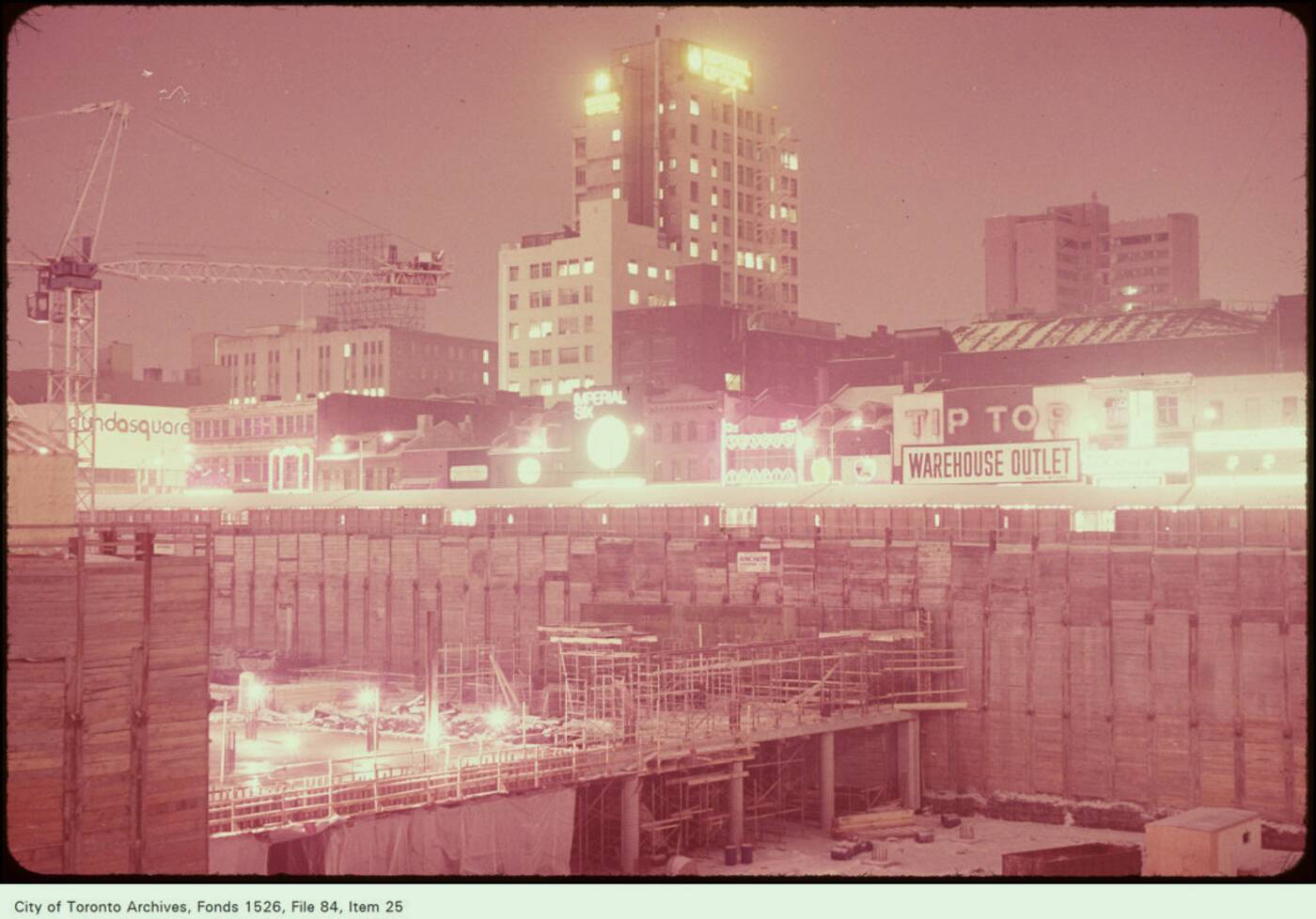
The Eaton Centre under construction.
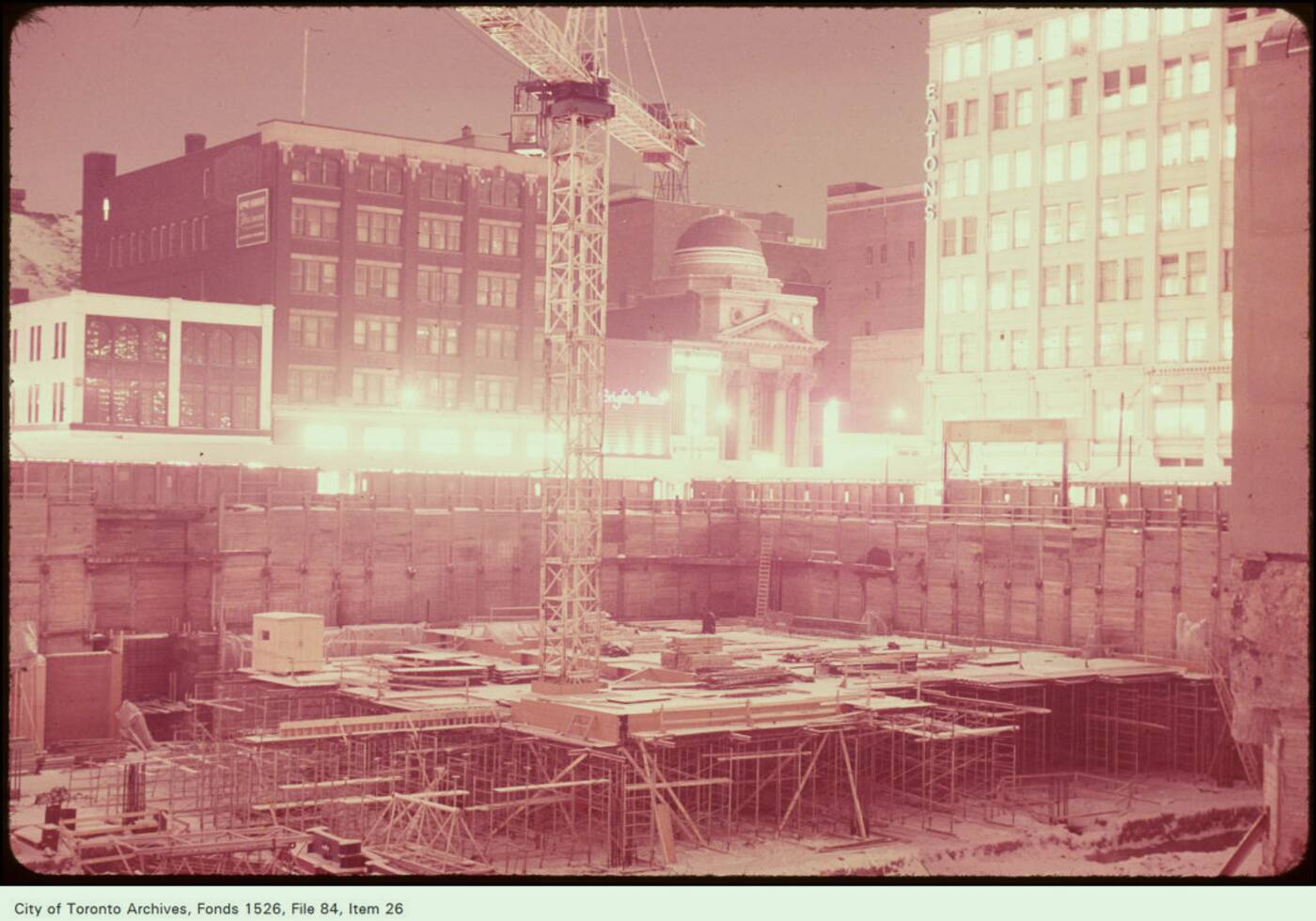
Eaton Centre construction further south.
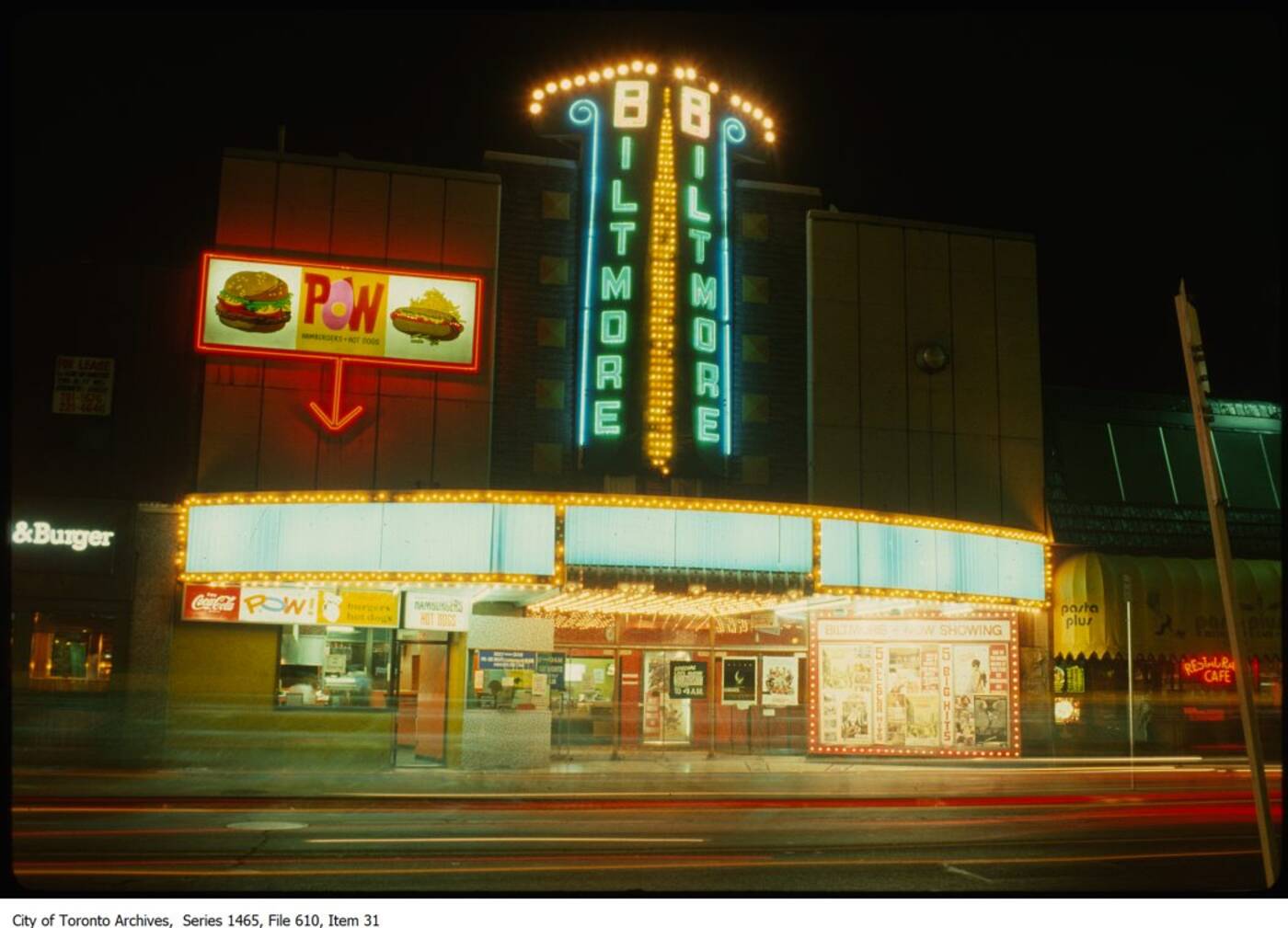
Biltmore's Theatre looking absolutely majestic in the late 1970s.
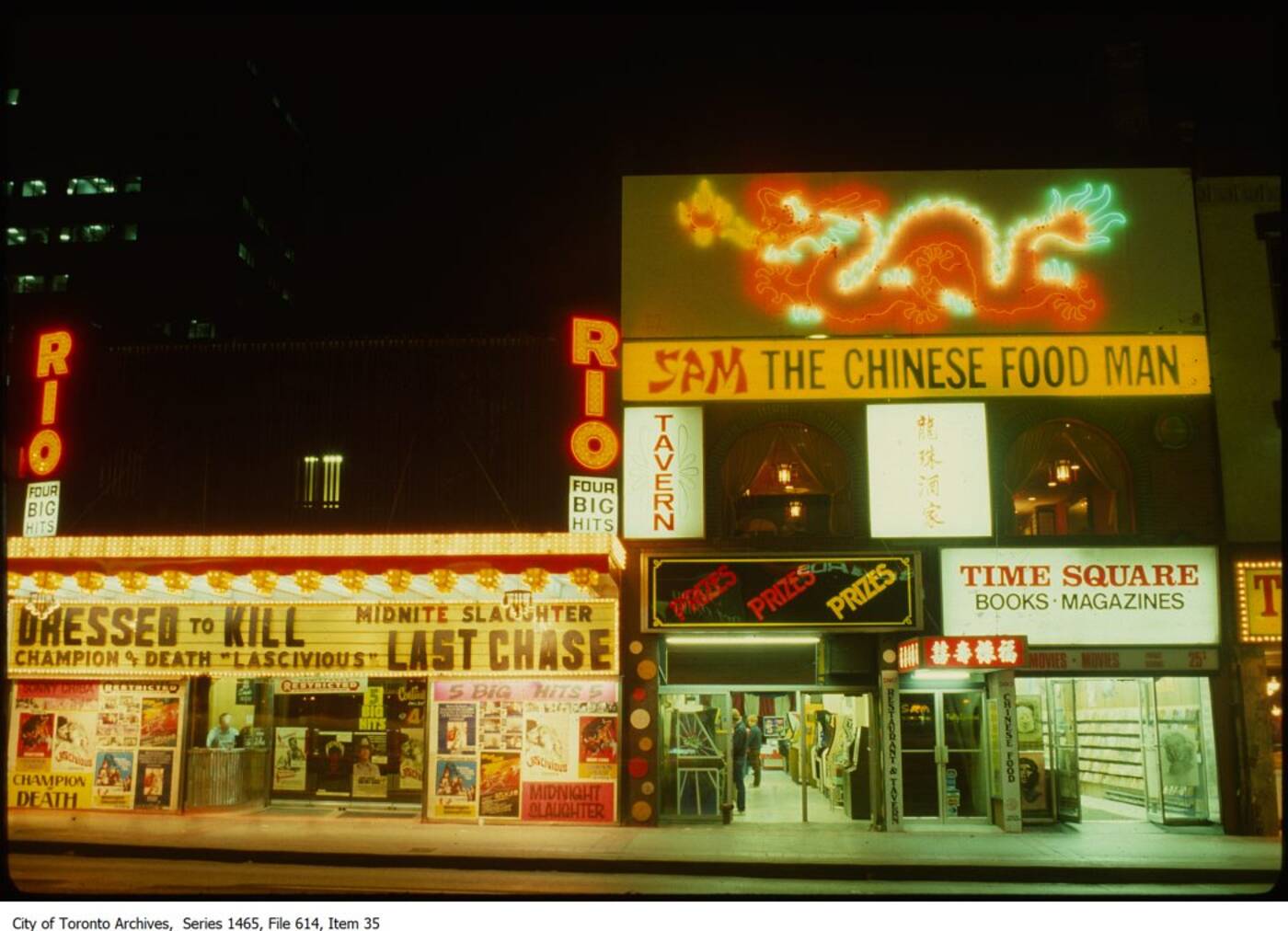
The Rio and Sam the Chinese Food Man on a much seedy Yonge St. strip.
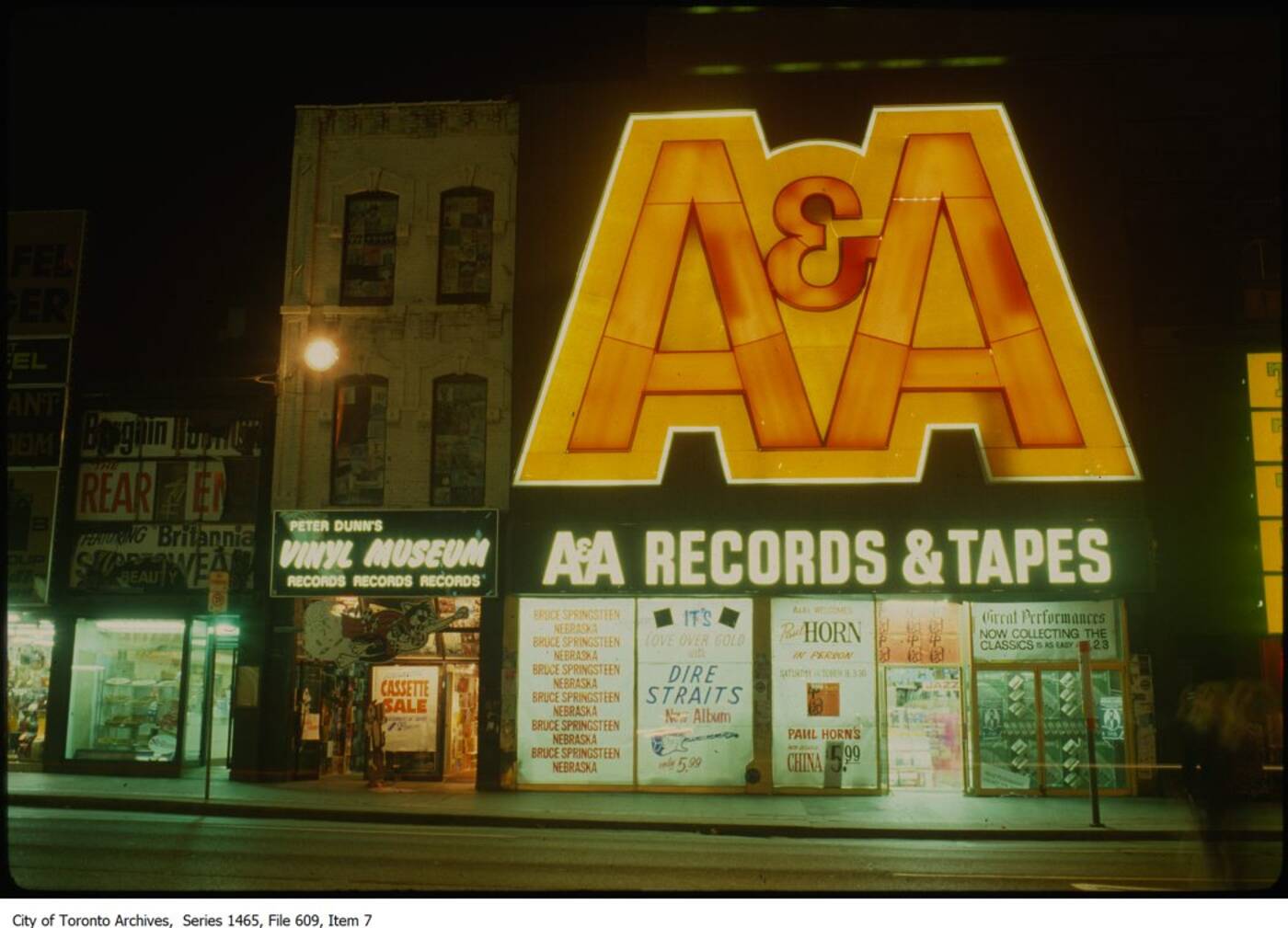
A&A Records and Peter Dunn's Vinyl Museum in 1982 (the year Dire Straits released "Love over Gold."
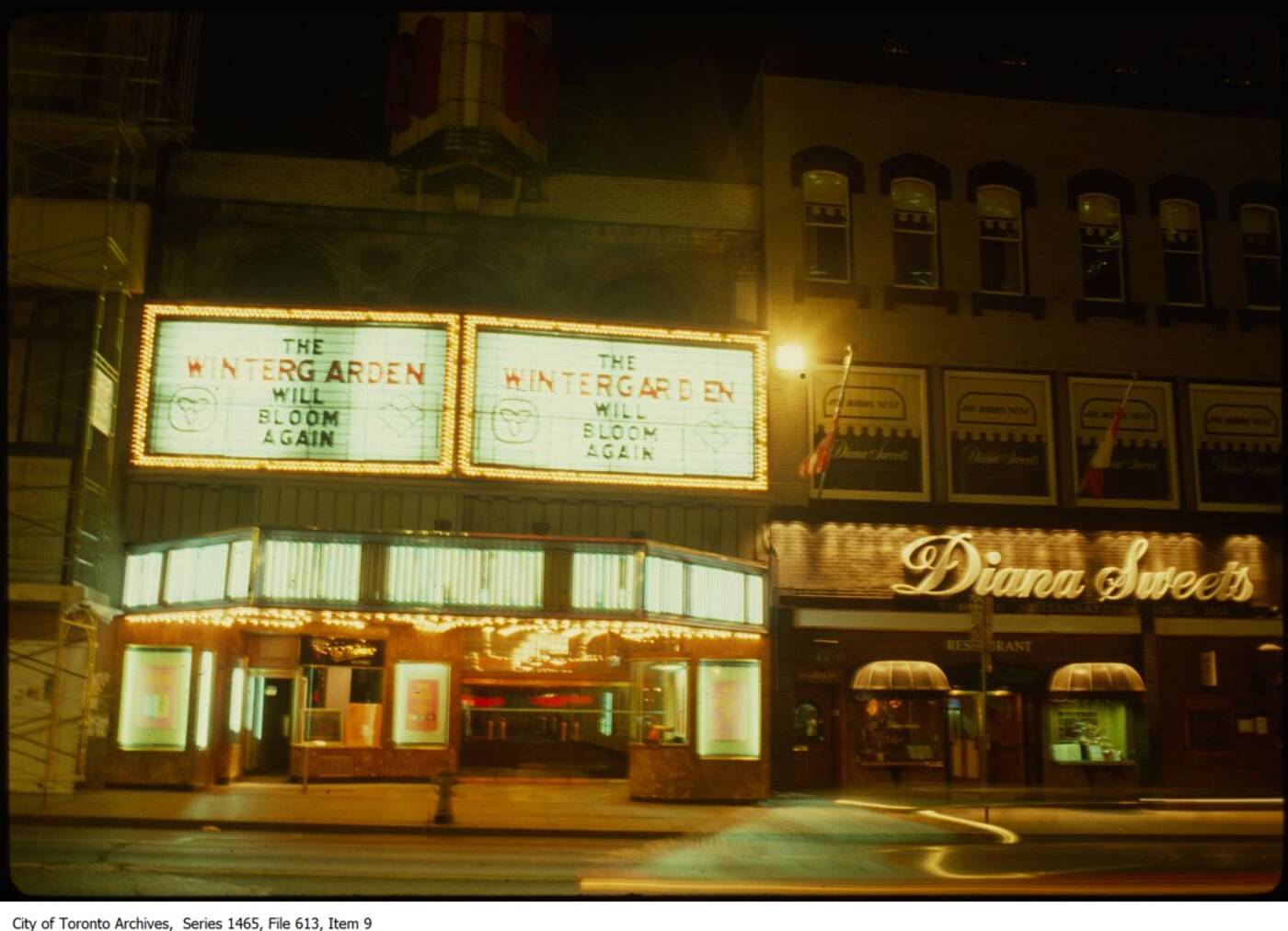
The Wintergarden Theatre and Diana Sweets further south on Yonge St.
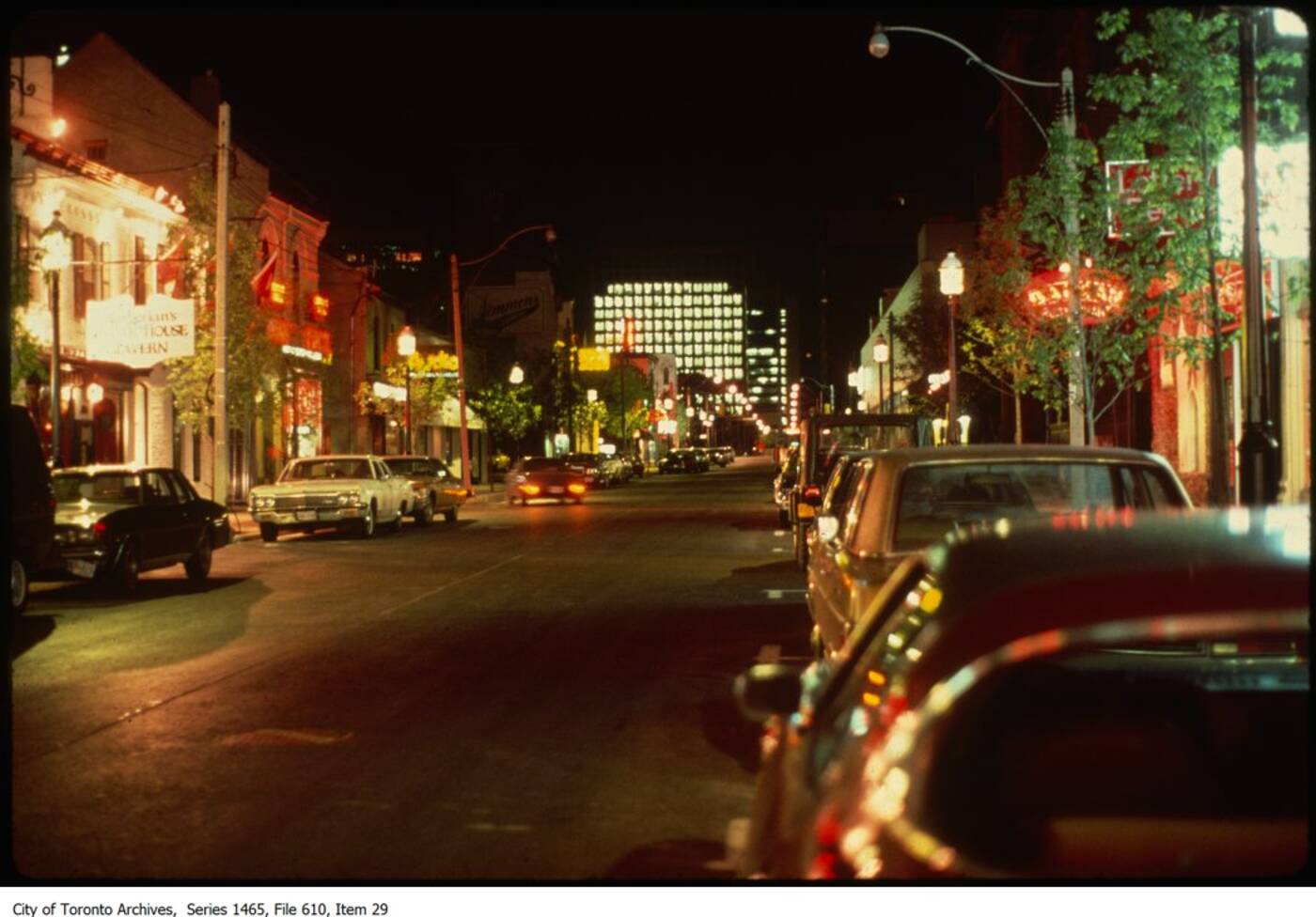
Elm St. just west of Yonge. You can bet the interior of Barberian's Steakhouse (left side) looked pretty much the same back then.
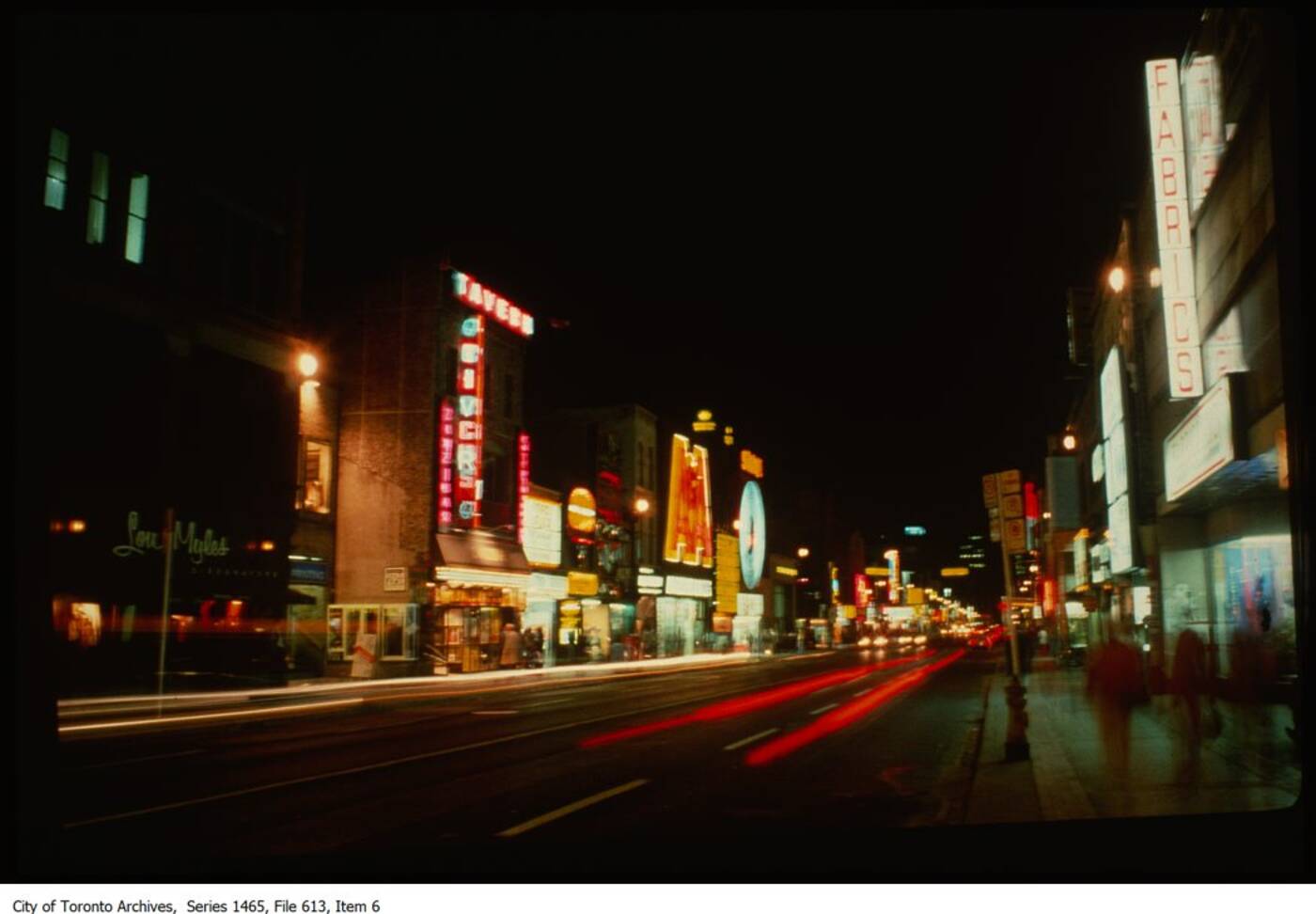
A wide shot of Yonge St. looking south to Gould in the early 1980s.
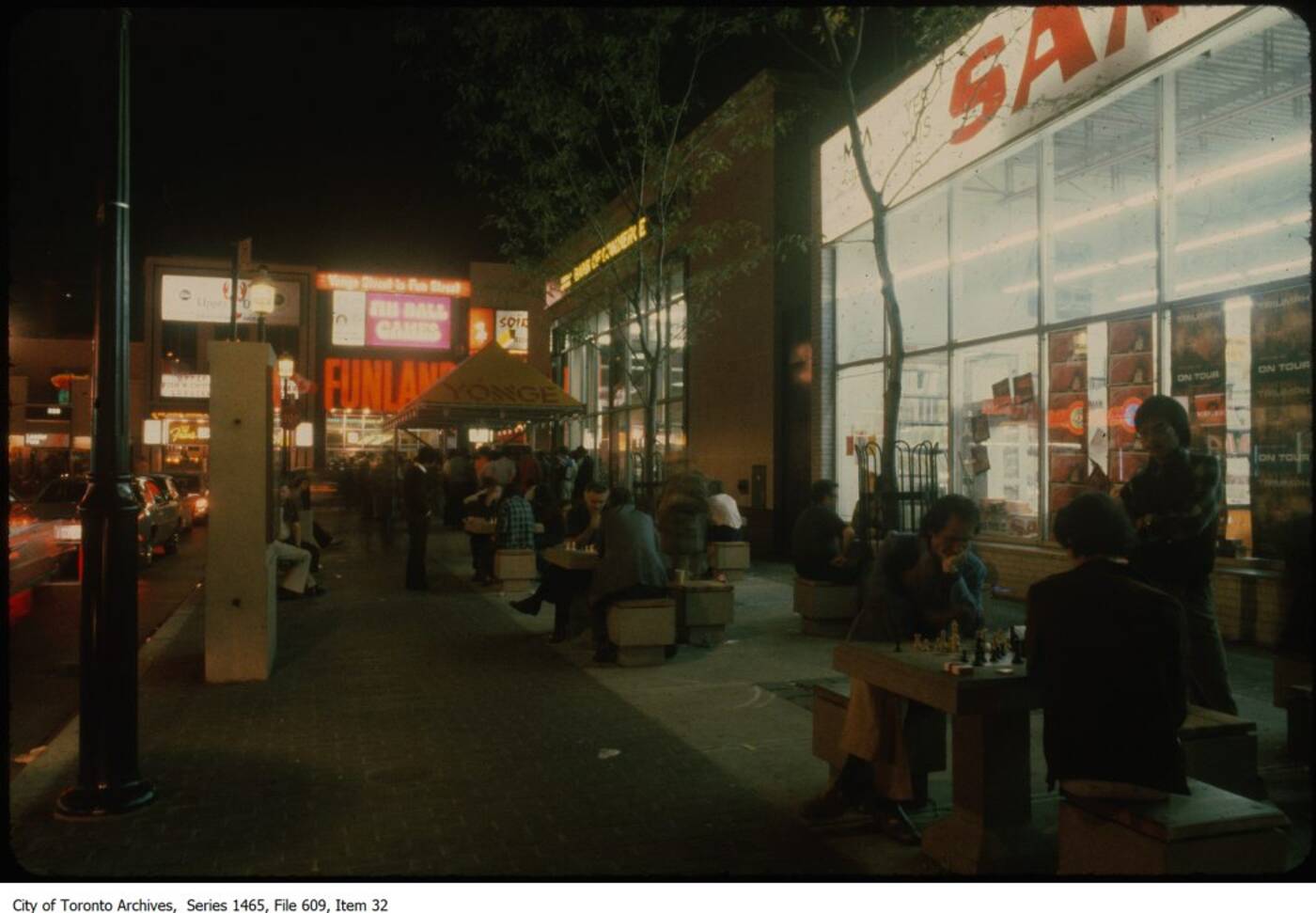
A lost Toronto tradition. Chess games outside Sam the Record Man on Gould St.
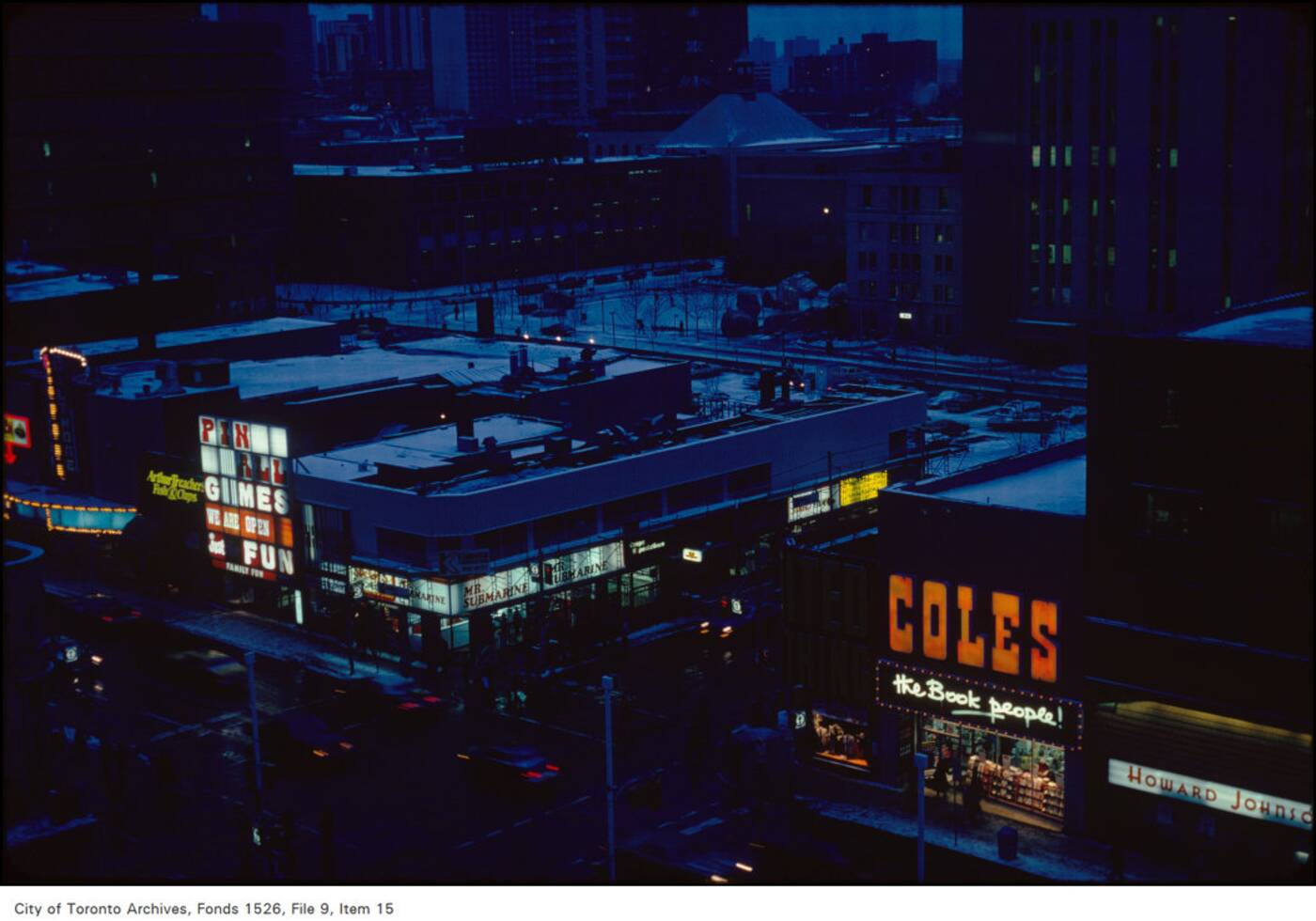
Looking down on Yonge and Dundas from the roof of the Eaton Centre. Note the Howard Johnson to the far right of the photo.
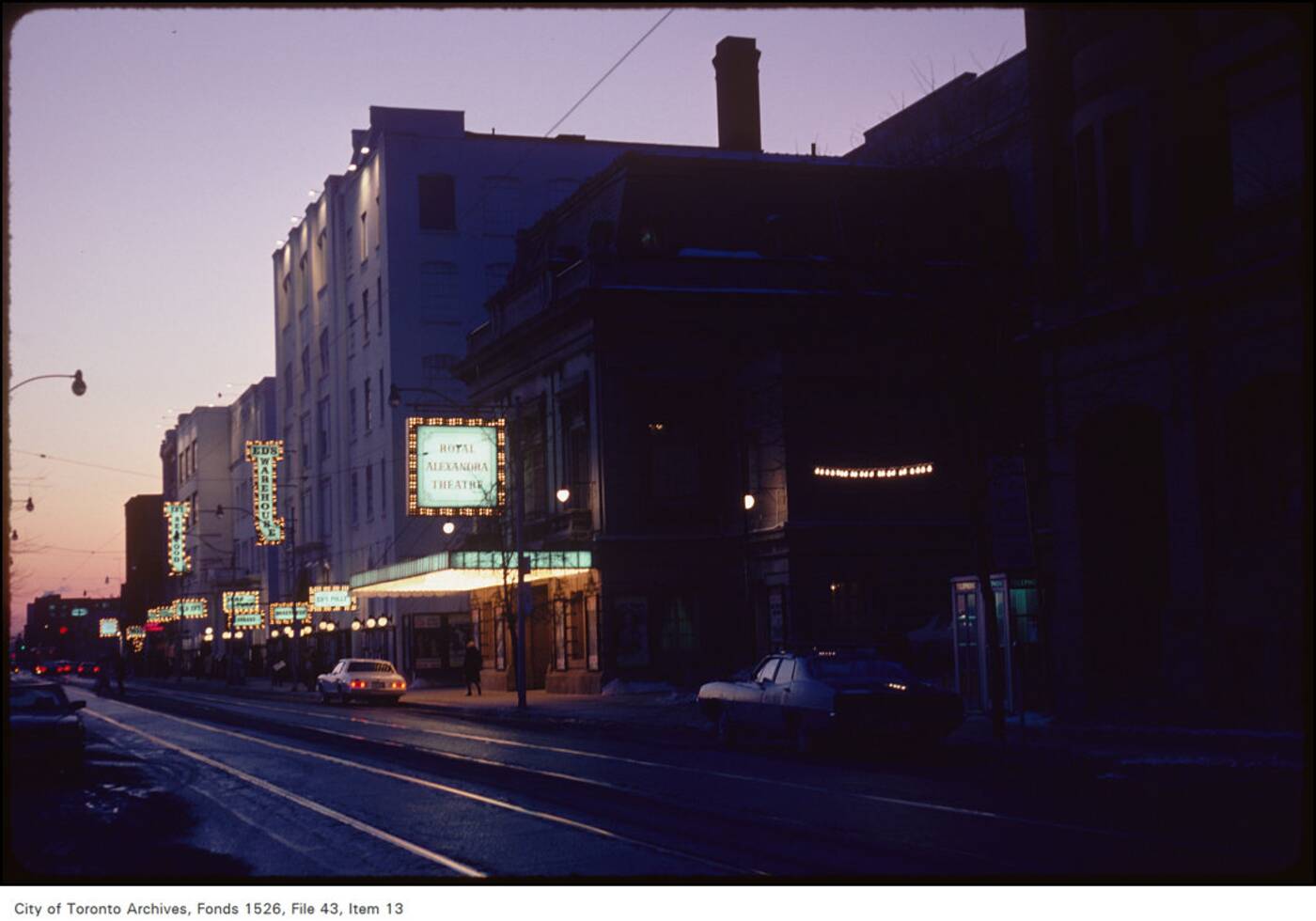
King St. looking west from Simcoe across Ed Mirvish's empire.
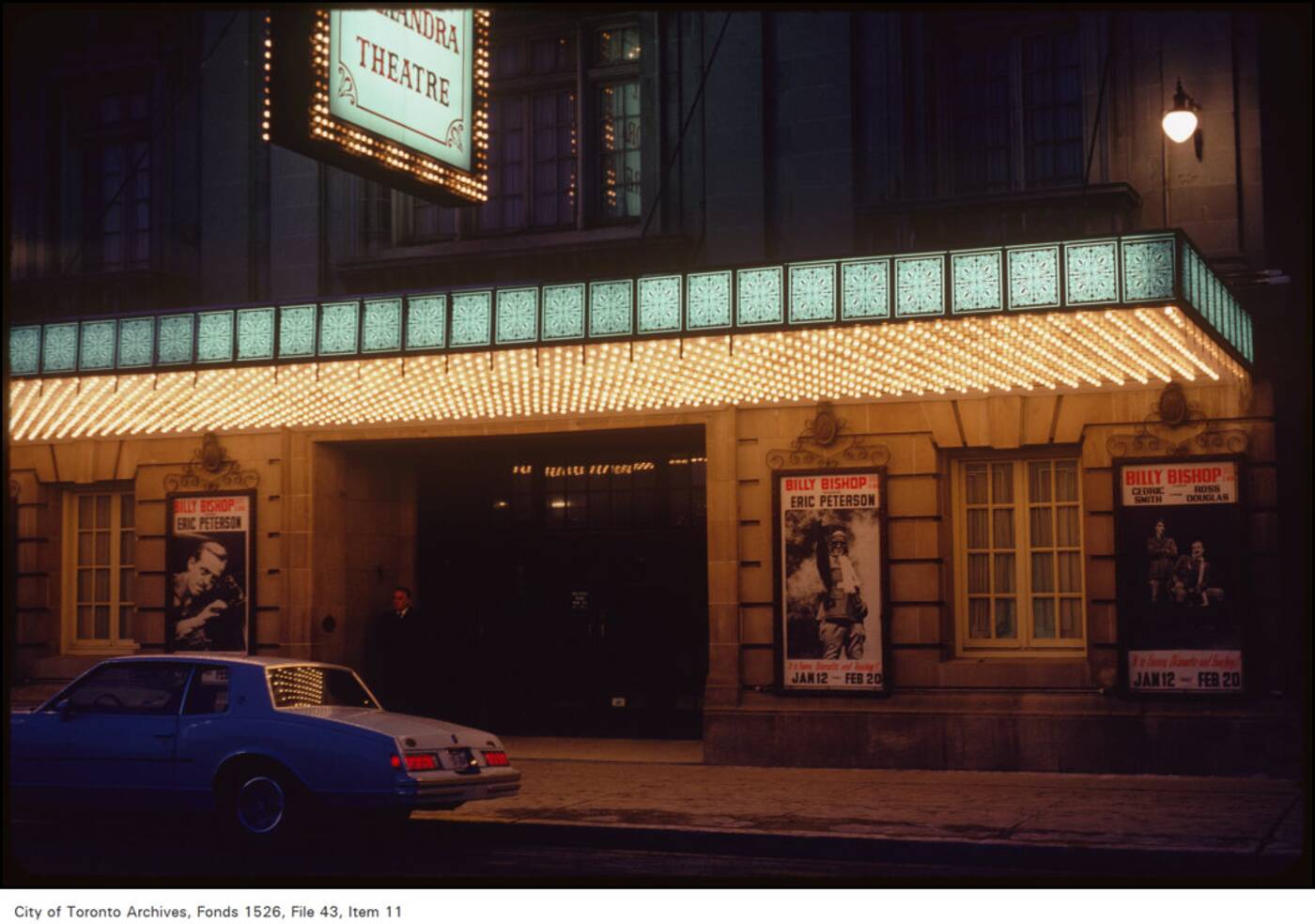
The marquee at the Royal Alex Theatre.
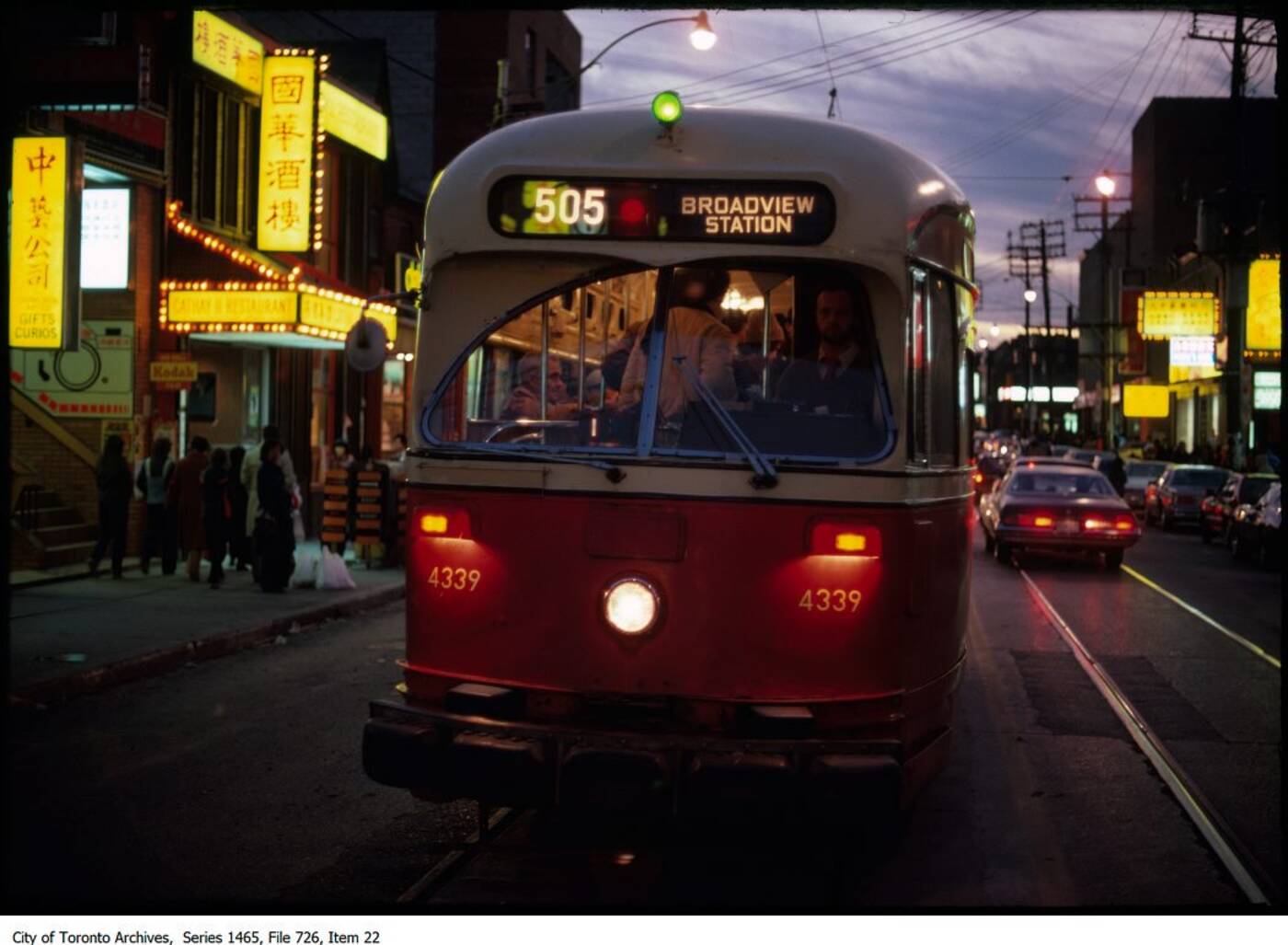
A perfectly moody looking Dundas West between Beverley and Spadina in the early 1980s.
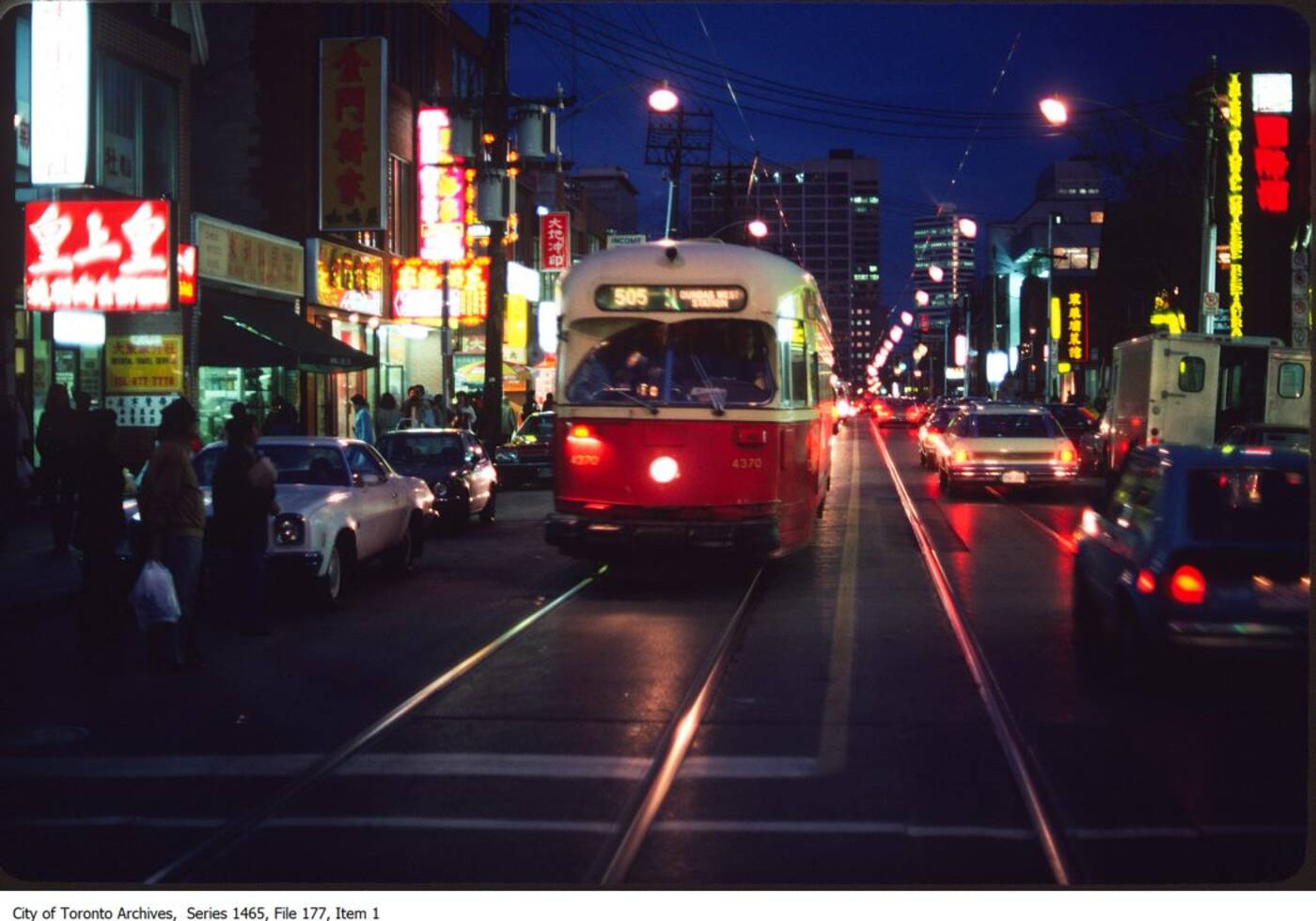
Now looking the other way, still on Dundas West.
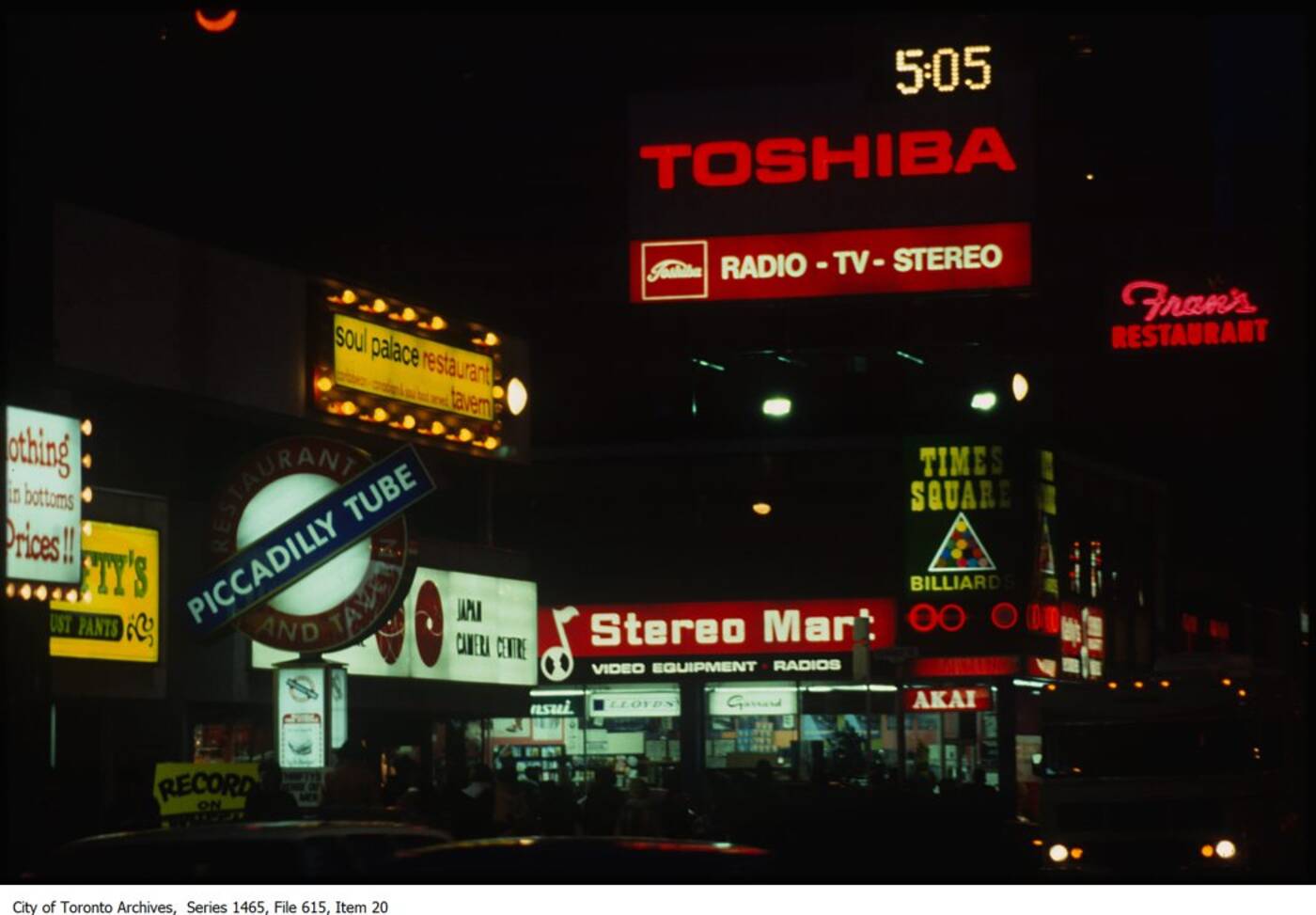
A jumbled group of signs on Yonge St. near Gerrard.
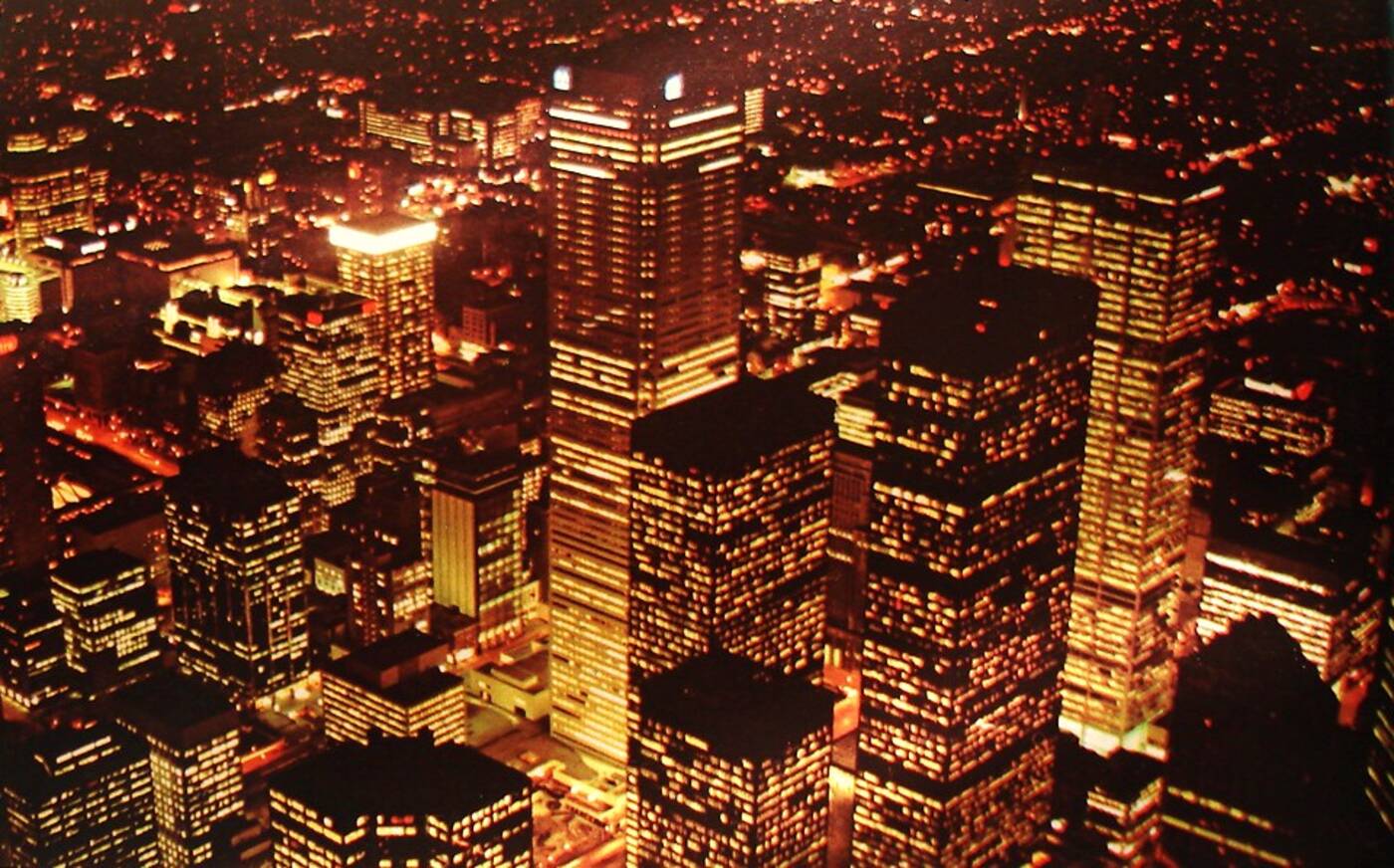
The quintessential, hand-held 1980s skyline shot from the CN Tower.
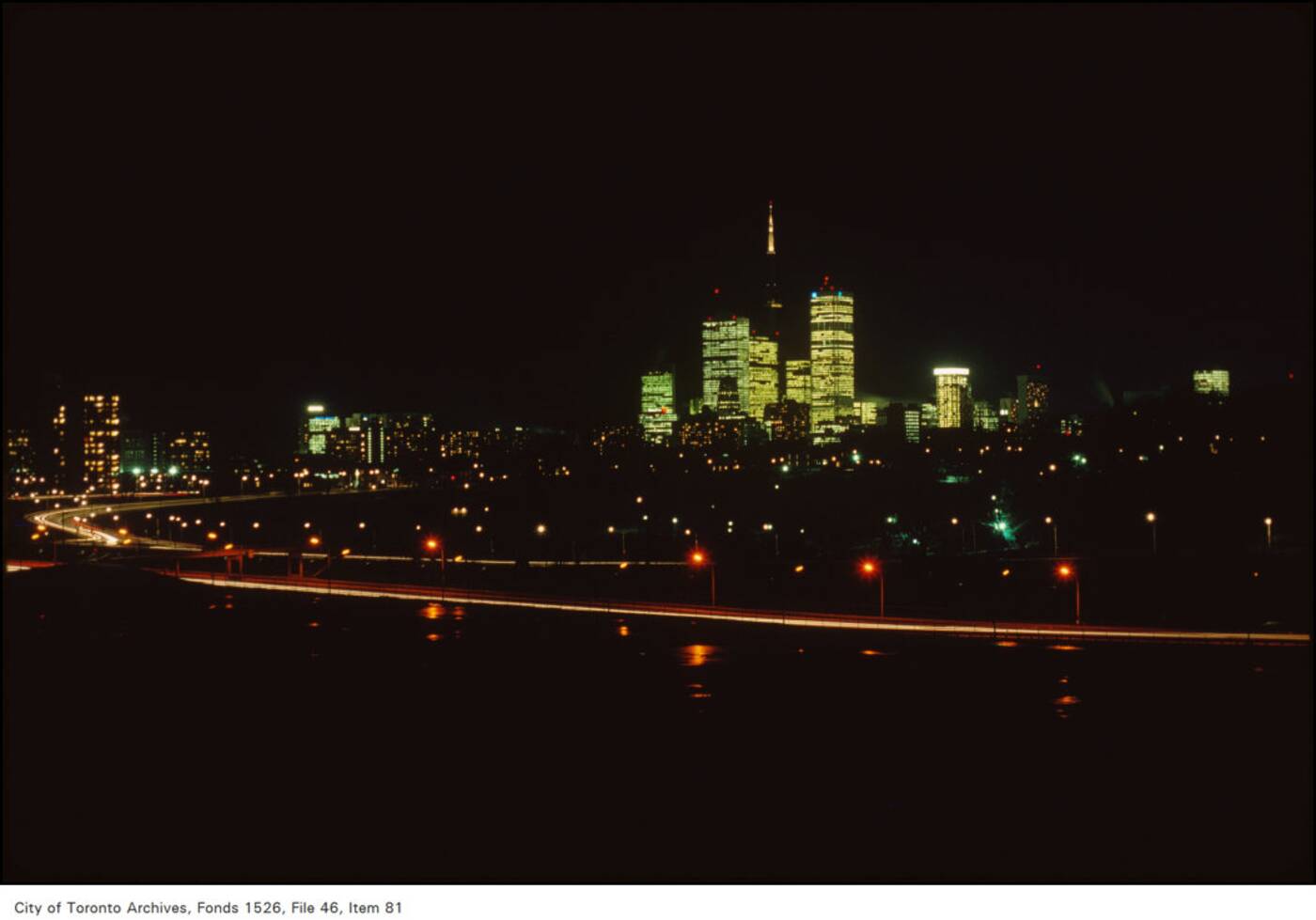
Now zooming out and looking at the skyline from Broadview Ave.
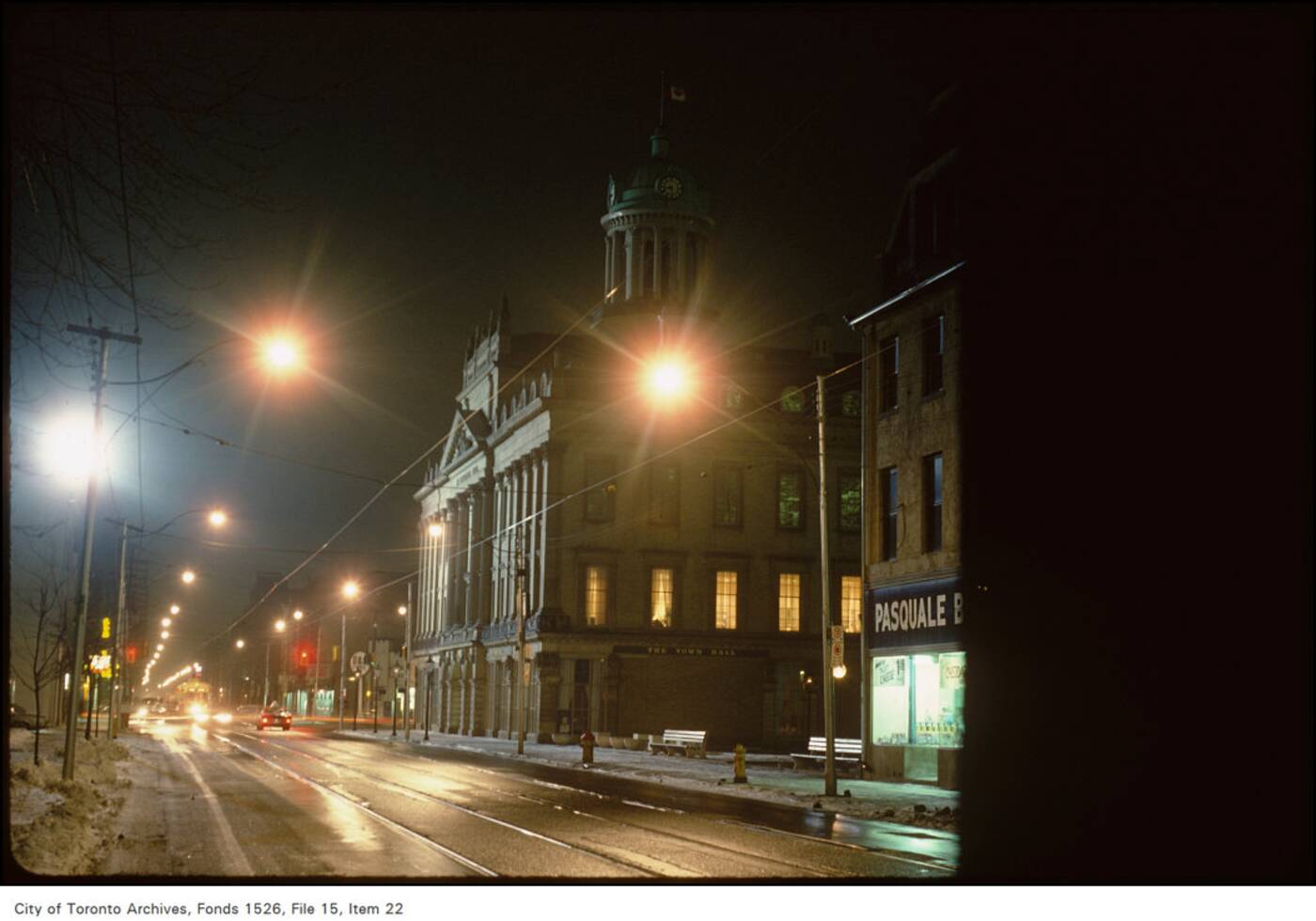
Quiet King St. looking east towards St. Lawrence Hall.
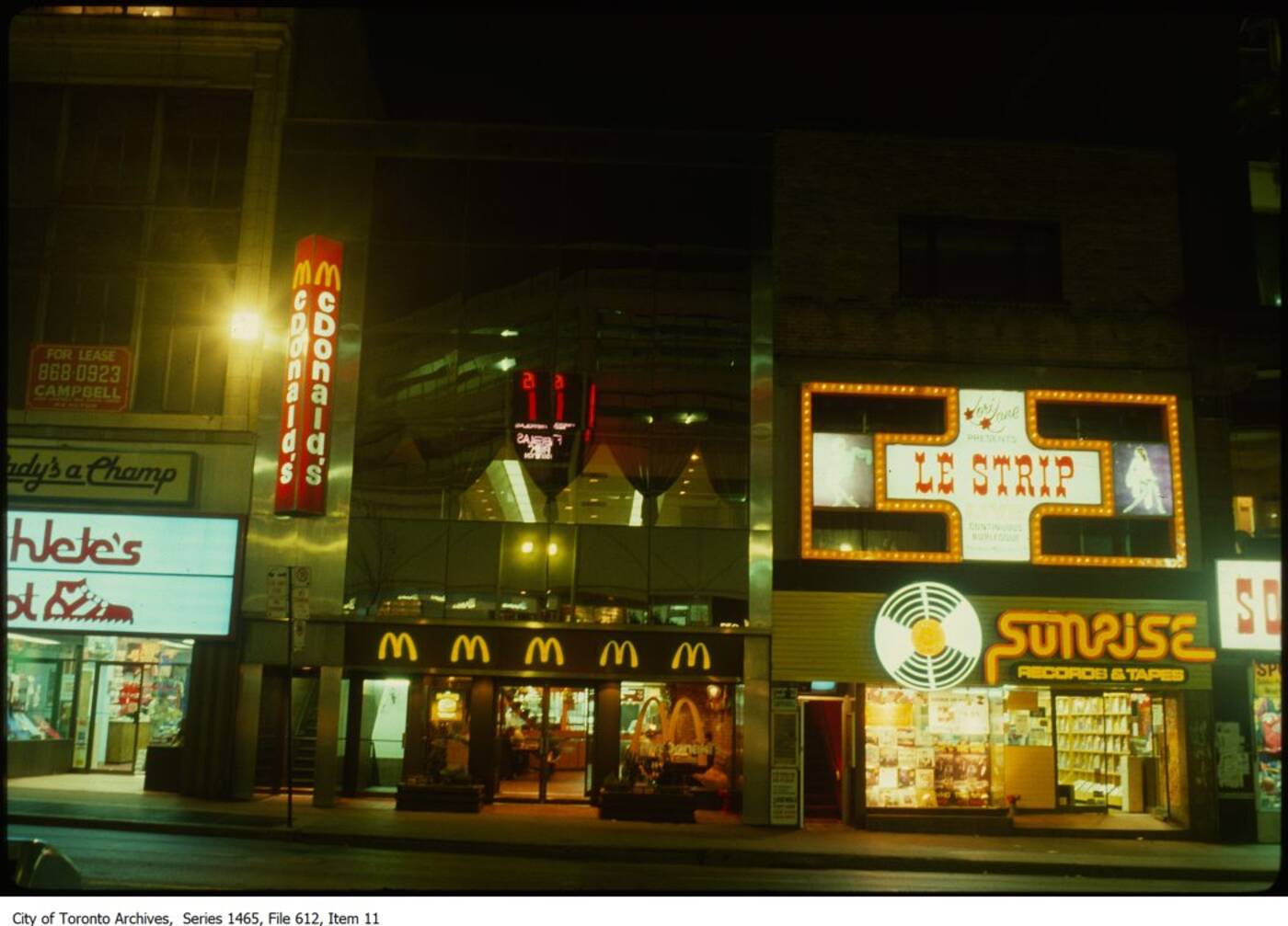
Record shops, strip clubs, and fast food: Yonge St. in the 1980s.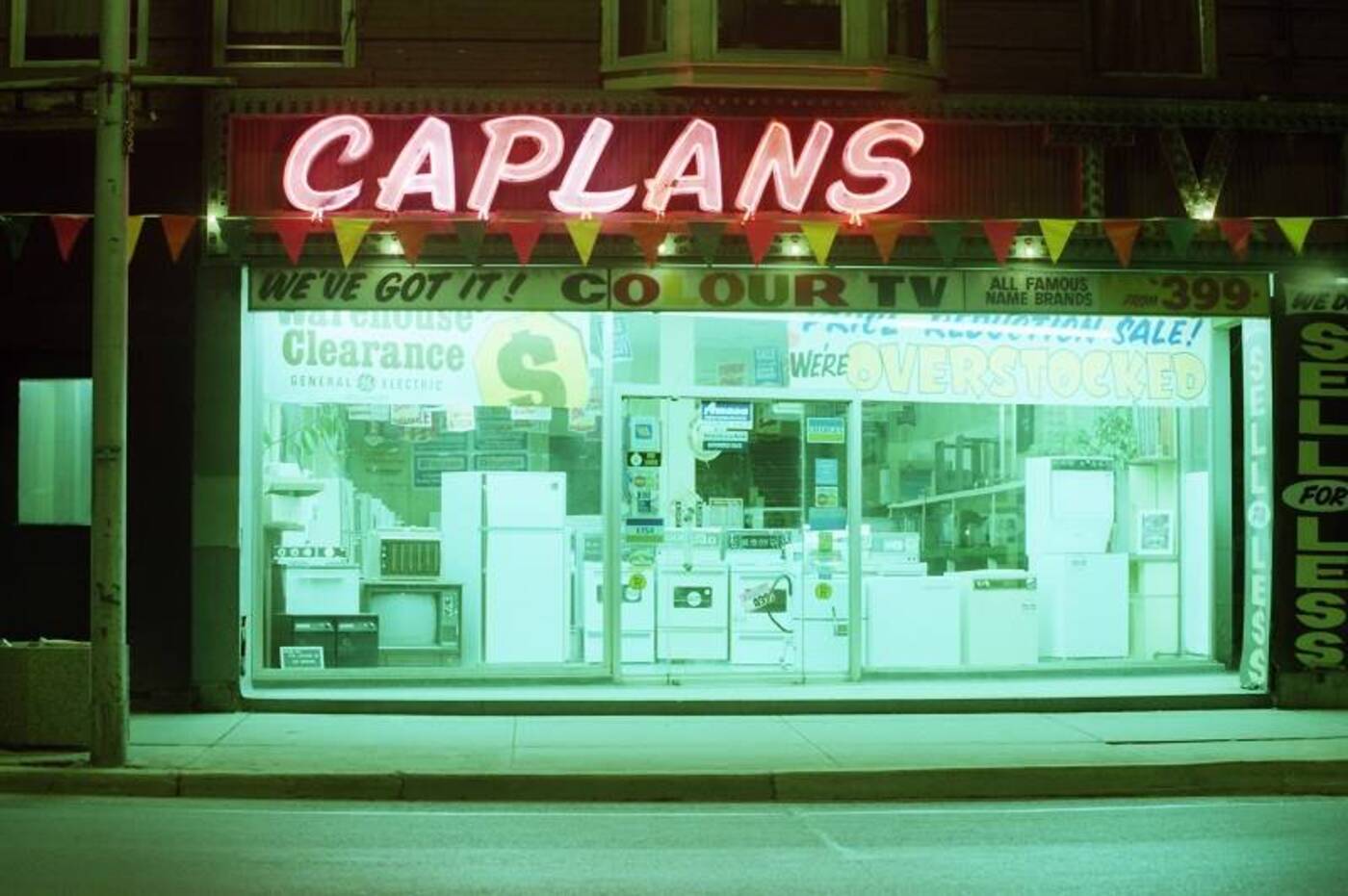 Typical Junction scene in 1984. Photo by Avard Woolaver.
Typical Junction scene in 1984. Photo by Avard Woolaver.
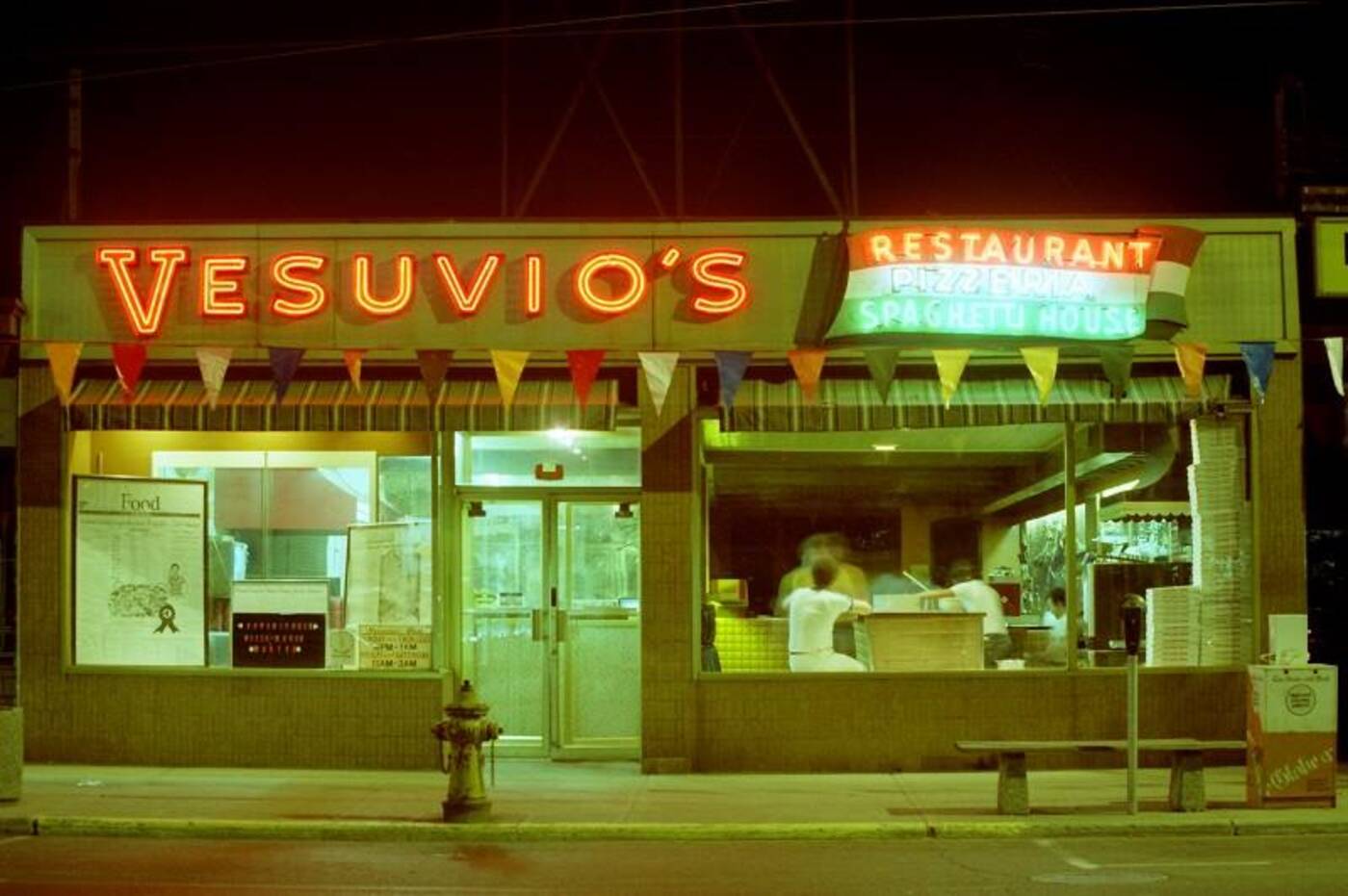 Kicking it at Vesuvio's in when it was still clad with neon. Photo by Avard Woolaver.
Kicking it at Vesuvio's in when it was still clad with neon. Photo by Avard Woolaver.
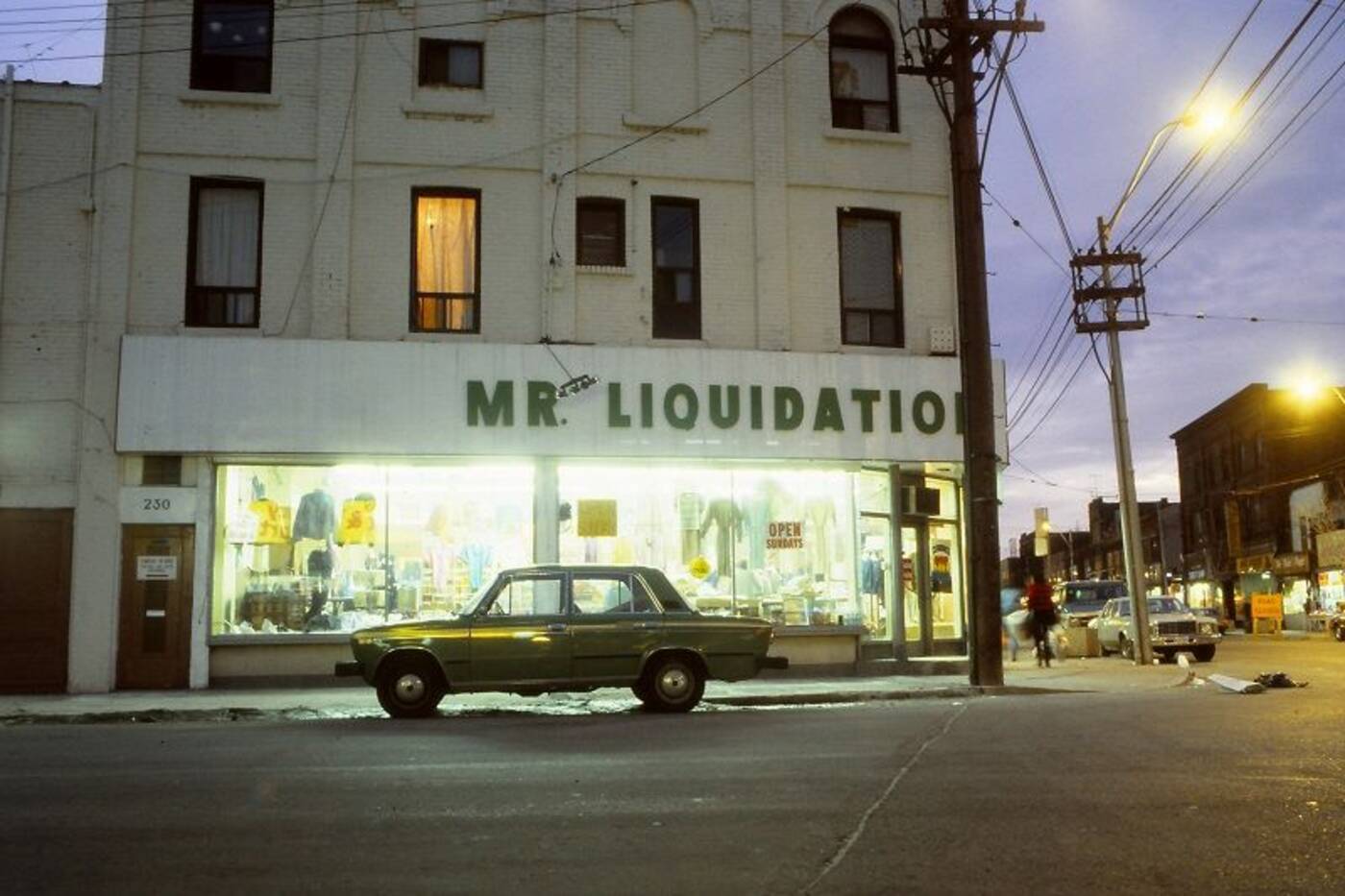 Dundas and Mavety in 1984. Photo by Avard Woolaver.
Dundas and Mavety in 1984. Photo by Avard Woolaver.

Looking up Yonge St. from Gould after the first of Sam's spinning discs went up. Photo by Avard Woolaver.
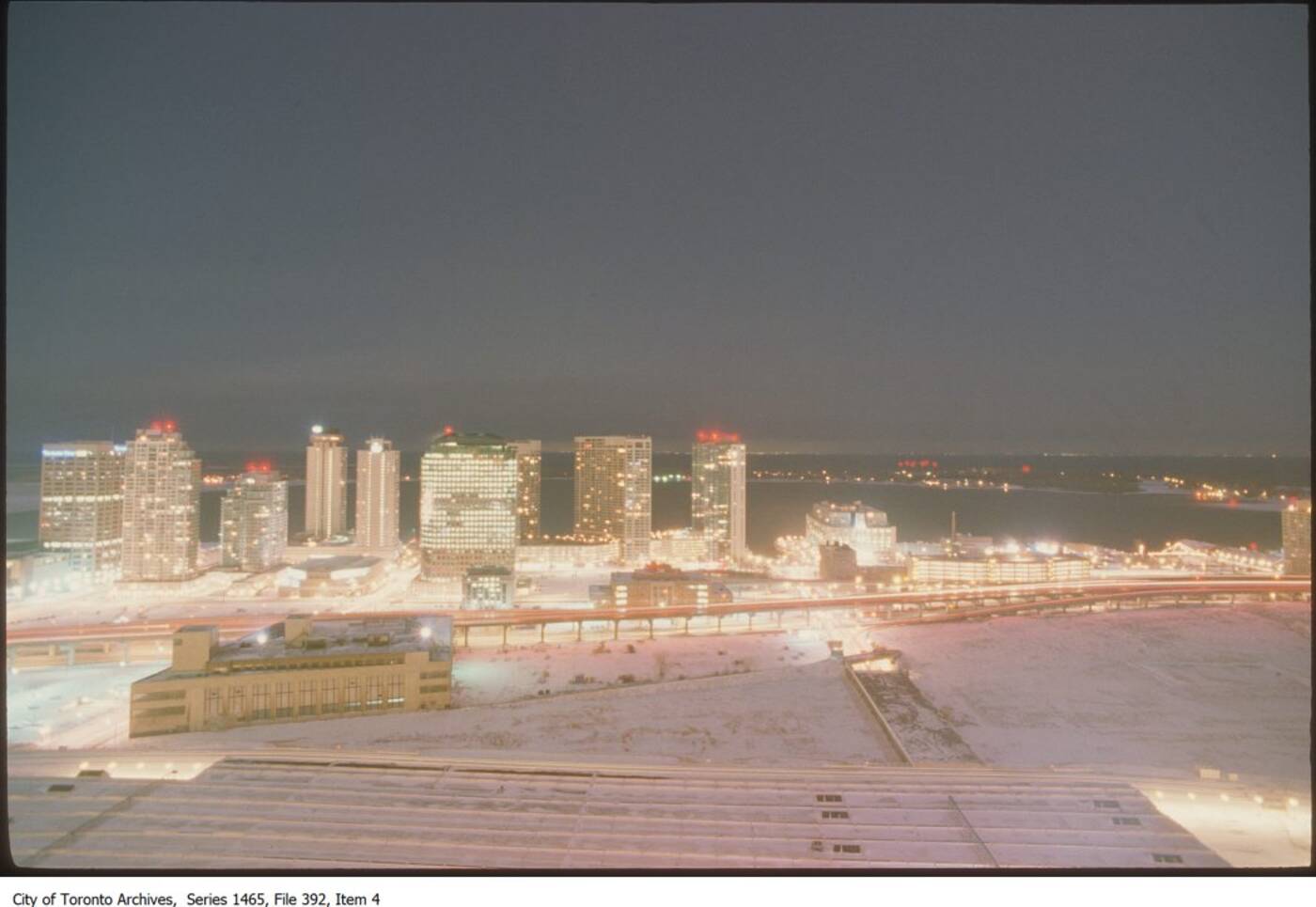
That, folks, is what "South Core" looked like in the mid 1980s. The prominent building you see to the centre-left is the Canada Post Delivery Building, which is where the Air Canada Centre is located now.
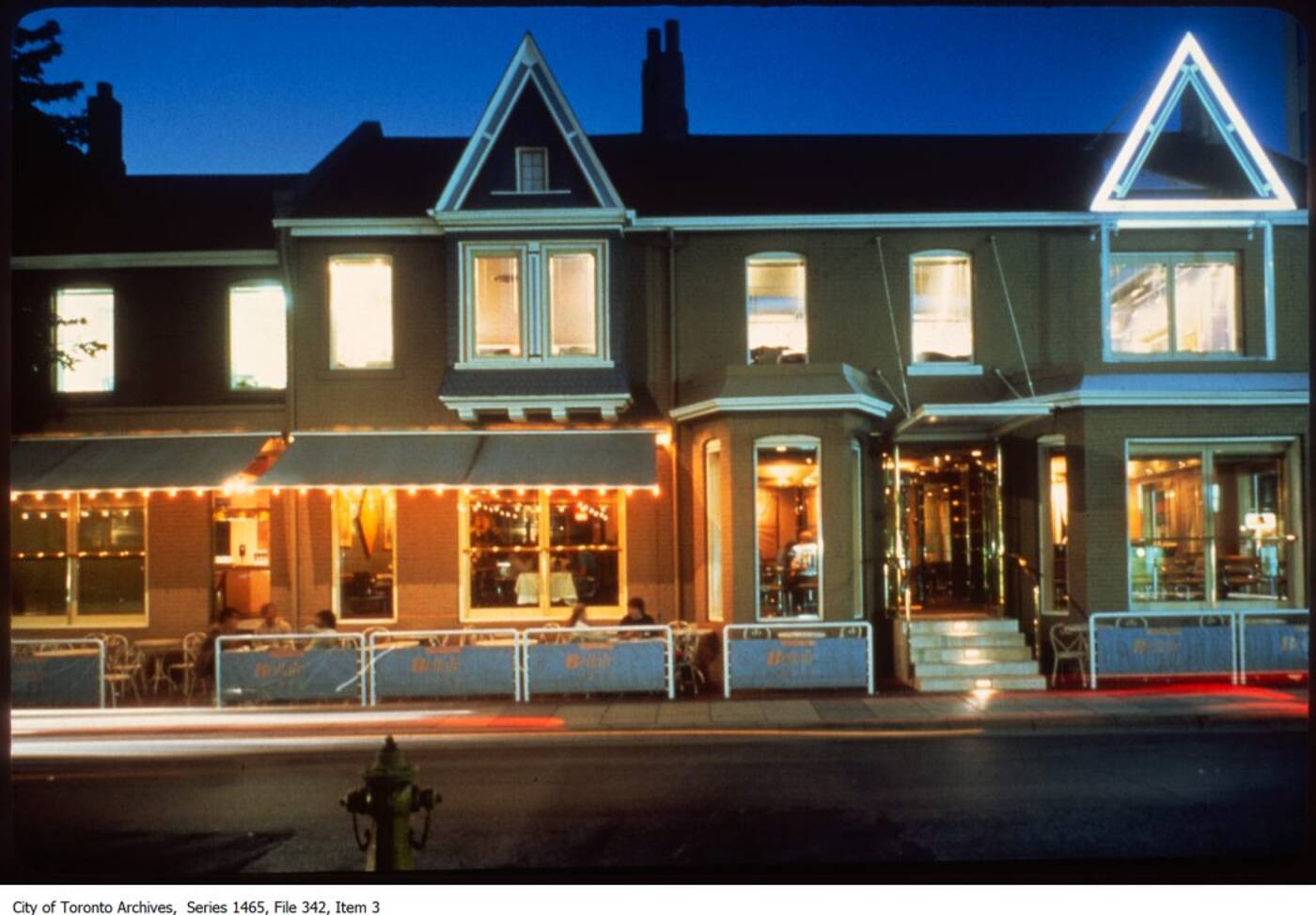
The Bellair Cafe lighting up Yorkville in the late 1980s.
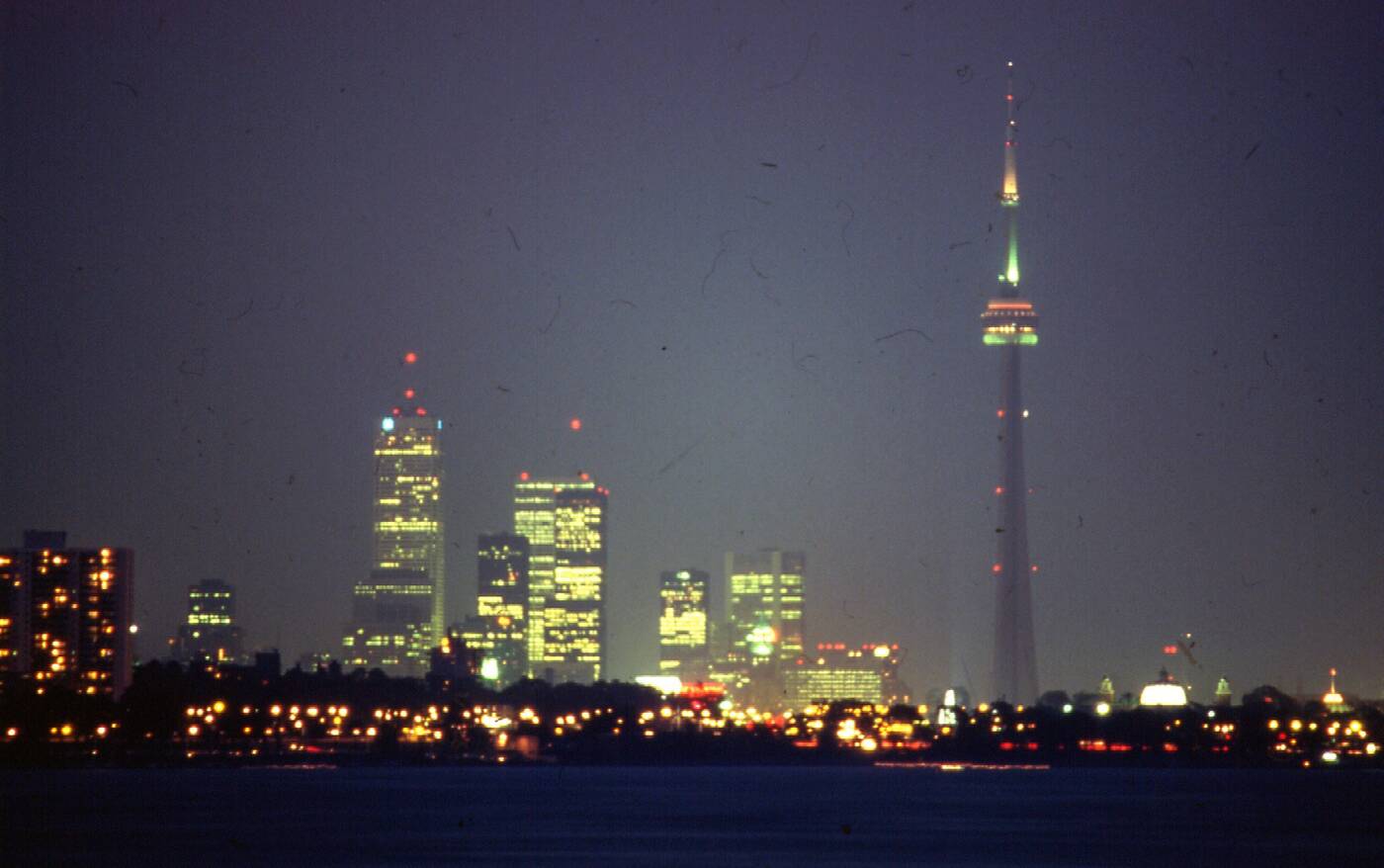
The Toronto skyline in 1987. Photo by Robert Naylor.
Thick Clusters of Wooden Birdhouses by London Fieldworks Sprawl Across Tree Trunks

“Spontaneous City in the Tree of Heaven.” All images © London Fieldworks
In London Fieldworks’ delicate creations, architecture meets nature. Its installations feature pine-colored clusters of minuscule wooden forms that appear to grow upon vast tree trunks. Founded by artists Bruce Gilchrist and Jo Joelson, London Fieldworks is a collaborative and multidisciplinary arts practice with projects at the intersection of architecture, sculpture, installation, and film.
Each of the homes has rounded windows and doors, while those on large evergreen trees resemble natural objects, such as wasp and hornet nests or even fungi and mushrooms. From reflecting Clerkenwell’s urban renewal to offering new habitats for animals, the sprawling birdhouses fuse architectural ideas with nature and art, resulting in sculptures that integrate effortlessly in both natural and urban spaces. Through its installations, the practice explores its concern with the climate crisis through the lens of history, the environment, and culture.
One work, “Spontaneous City in the Tree of Heaven,” references opposite sides of London: Duncan Terrace Gardens in the east and Cremorne Gardens in the west. The installation is constructed from hundreds of bespoke bird boxes reflecting the forms of the local architecture—a combination of Modernist 60’s social housing and Georgian townhouses.
Explore more of London Fieldworks’ projects on its site. You also might enjoy this similarly dense complex for avian neighbors.

“Spontaneous City: Clerkenwell”

Right: “Spontaneous City in the Tree of Heaven”

“Spontaneous City in the Tree of Heaven”

“Spontaneous City in the Tree of Heaven”

“Spontaneous City in the Tree of Lebanon”
This is what Queen West looked like in the 1990s
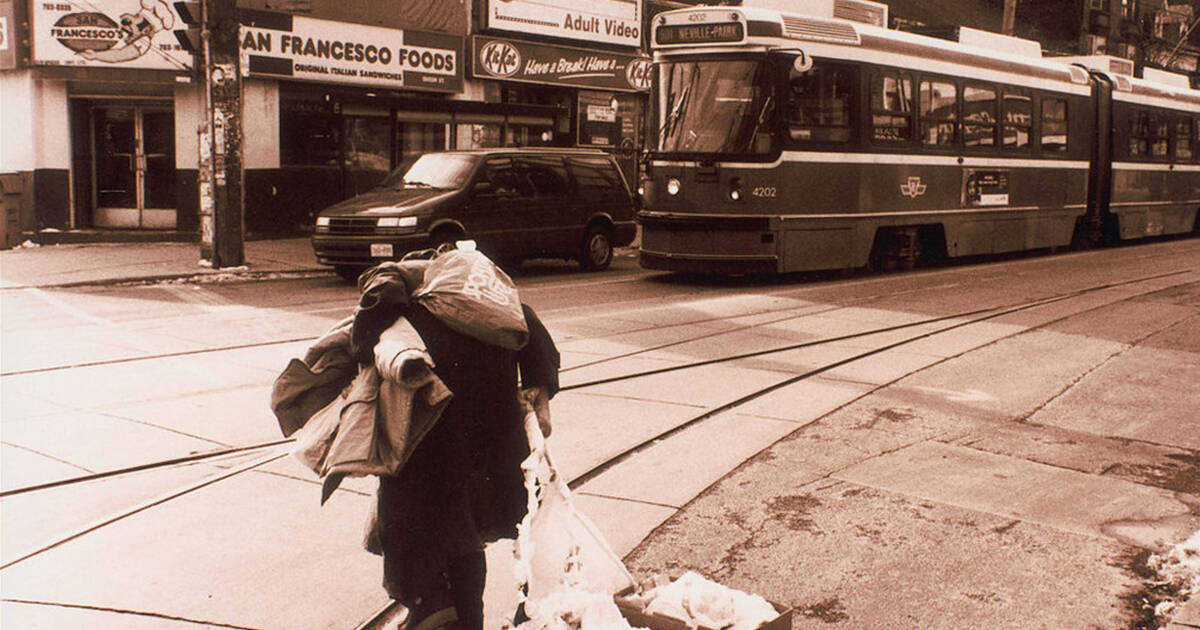
You tend to hear a lot about what Queen West looked like back in the 1980s and '90s, before the furniture stores moved in and the iconic Big Bop closed.
These memories tend to take familiar nostalgic form, idealizing some putative authenticity that has been lost to gentrification and redevelopment.
And while there's some truth to such narratives, this tendency toward glorification likely paints an inaccurate picture of the place.
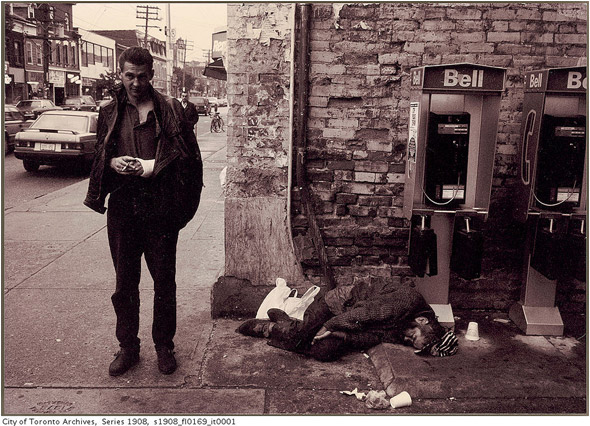
Queen and Bathurst, 1995
Don't get me wrong, I wax nostalgic often enough about Toronto's lost grittiness (a process that's sanitized the city to a degree that's perhaps problematic) but there's a more complicated story than the one that surrounds questions of authenticity.
Photographs by Ivaan Kotlulsky, a jeweller who had a shop at 692 Queen Street West, reveal the characters who passed by his shop and offer a glimpse at the makeup of a street that's changed profoundly over the years.
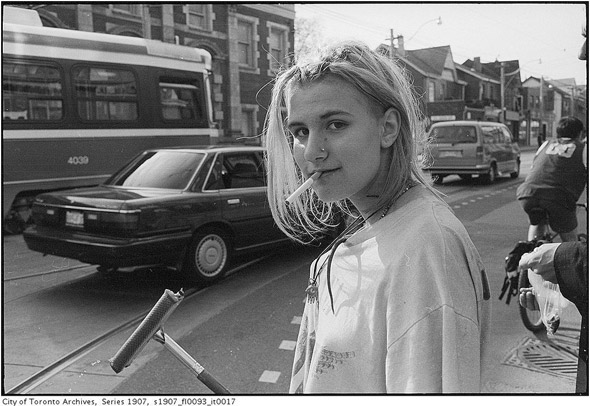
Squeegee kid at Queen and Bathurst, 1996
Some of them depict people down on their luck, while others hint at the changes to come, but they're all shot with a keen eye for the neighbourhood's residents and their experience of the street.
These aren't about architectural documentation, as you might see more obviously in the work of Patrick Cummins, so much as the people who called the neighbourhood home.
And there's a certain tenderness in the manner in which they're depicted that offers considerable insight in to the life of the street.
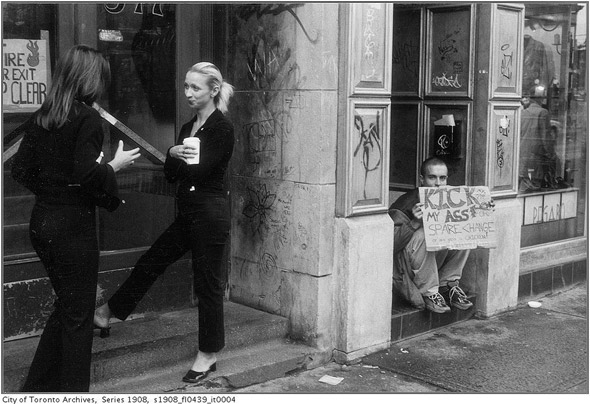
Sign of the times, 1995
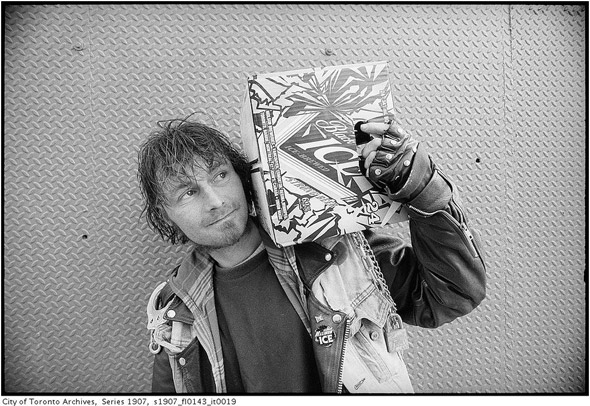
Remember Black Ice? Queen and Markham Beer Store, 1998
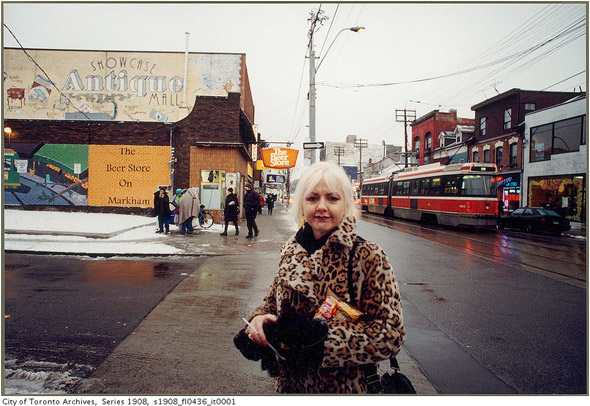
Queen and Markham, 1995
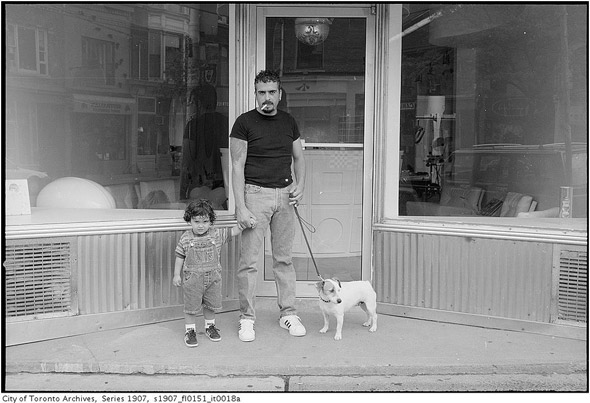
Near Queen and Manning, 1995
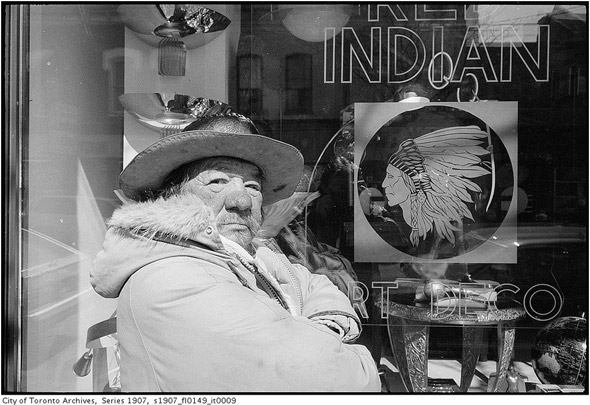
Lester Pawis outside the Red Indian Art Deco Antique Store, 1999
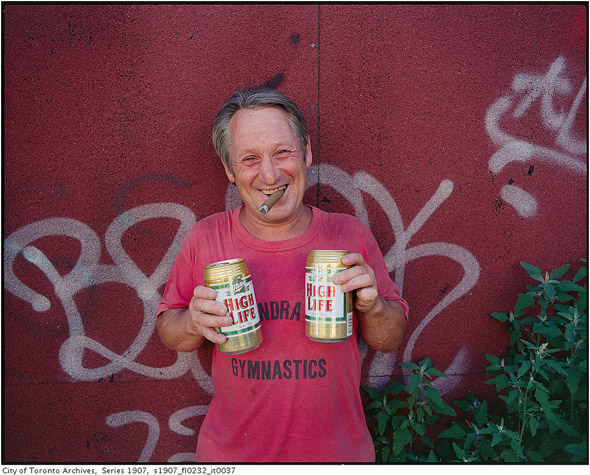
High Life, Queen and Portland 1995
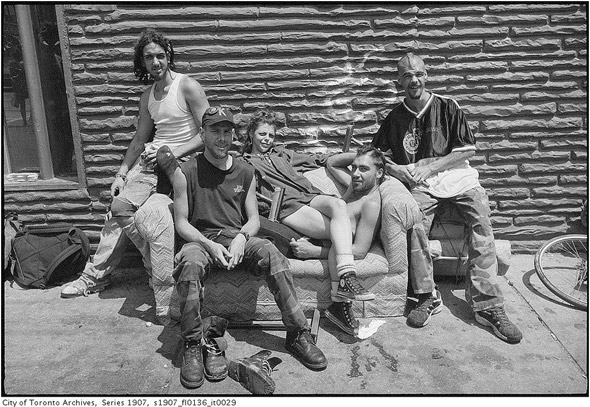
Squeegee crew at Queen and Bathurst, 1998
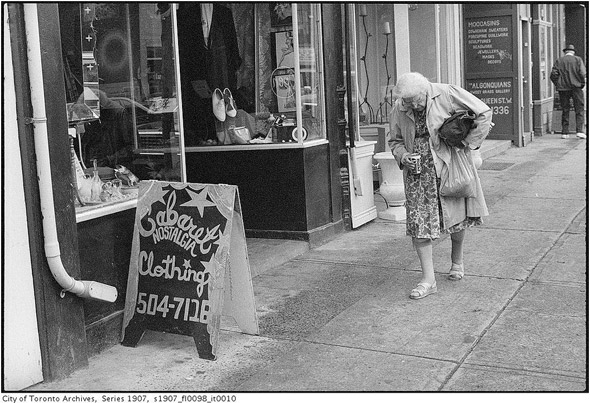
Walking past Cabaret Nostalgia, 1996
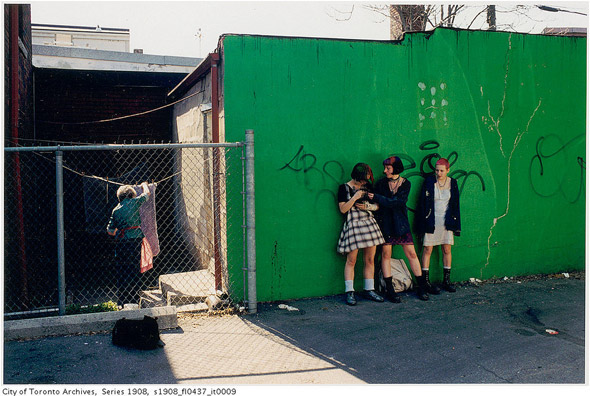
Hanging in a back alley, 1995
The history of Yonge and Dundas back when it was cool
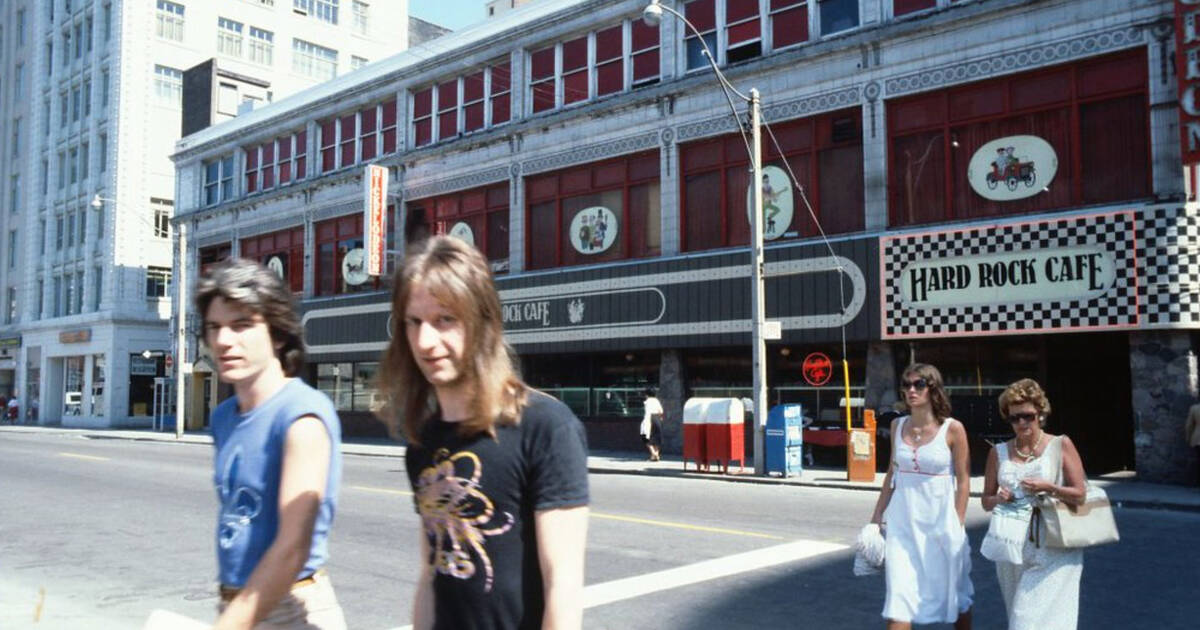
If you asked the average Toronto resident to nominate the most touristy intersection in the city, most would select Yonge and Dundas.
As a central access point to the Eaton Centre and home to one of the city's largest public gathering spots, it draws huge numbers of visitors for its Time Square-ish vibe, but it'd be difficult to track down many locals who are passionate about the place.
Yonge and Dundas may bustle with activity, but it feels corporate, sanitized and highly regulated.
Much of this has to do with the presence of 10 Dundas East, the unfortunate and bland structure that towers over the northeast corner of the intersection.
It opened in 2007 (as Toronto Life Square), but the previous buildings were demolished about a decade earlier to pave way for the development.
The adjacent square arrived earlier in the decade, opening in 2002. There was about a five-year period when the east side of the intersection was almost barren on account of these two construction projects, which would forever change the character of the city.
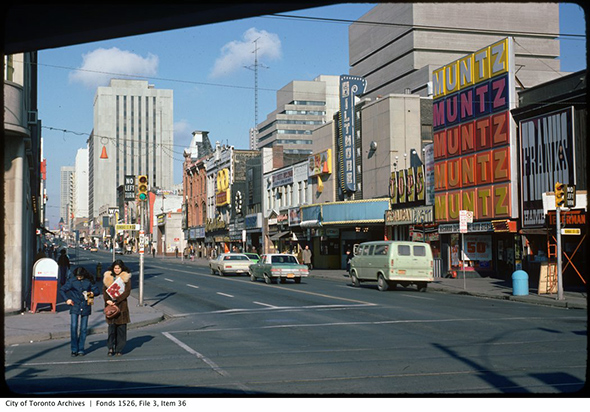
Yonge and Dundas, once the heart of seedy Toronto, was officially cleaned up by the time the square opened. This, of course, was the plan. For years, the city had been looking for a way to revitalize Lower Yonge St. and by 1998 the public square was the centrepiece of the project.
The buildings that were ultimately demolished to pave way for modern day Yonge and Dundas aren't much worth mourning.
The southeast corner was home to the World's Biggest Jean Store, while the northeast side hosted a currency exchange and pawn shop. Something has, however, been lost in the transformation of the place.
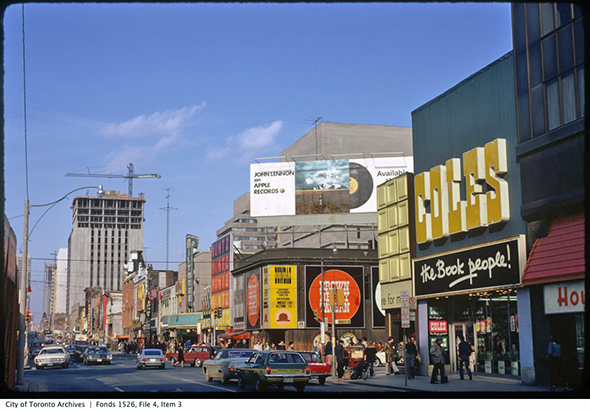
You have to rewind back to the 1970s to get a sense of what Yonge and Dundas was like in its heyday.
At this time, the northeast corner was home to the Brown Derby Tavern, which opened in 1949 and was a mainstay at the intersection. A far cry from Jack Astor's, the Derby was a rough-around-the-edges Toronto institution.
In other words, it wasn't a tourist trap. Yonge and Dundas wasn't just a shopping destination; it was a place you could drink. Even the now shuttered and replaced Hard Rock Cafe, which opened a block south in 1978 (four years after the Derby closed), was a vibrant place back then.
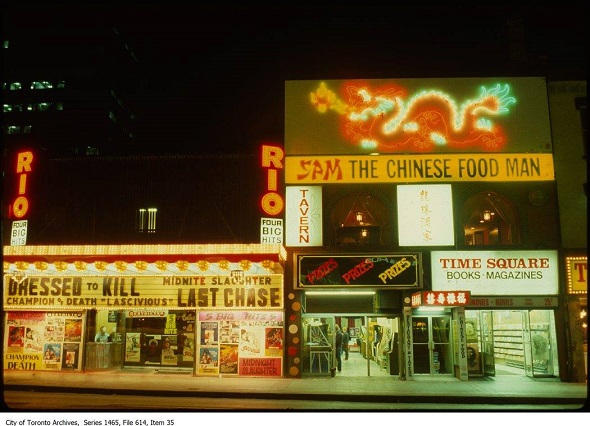
The whole strip of Yonge St. was focused on a more adult brand of entertainment during this period, be that cocktails, live music or lap dances.
Closer to Queen St., the Colonial Tavern was the place to listen to jazz, while north of Dundas you could eat indulge in greasy spoon eats at Tops or late night noodles at Sam the Chinese Food Man.
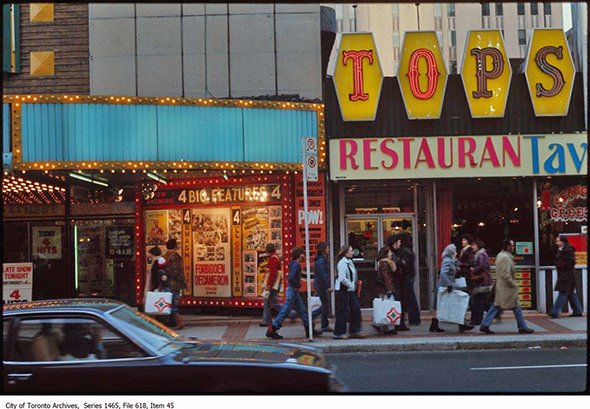
The area was still broadly touristy, but that wasn't its raison d'etre in the 1970s. On the contrary, even through the 1980s you went here to get a dose of gritty Toronto, to expose yourself to the energy that was always pulsing through this corridor of Yonge St.
The shocking death of Emanuel Jaques in 1977 was the first occasion that led to major calls to clean up the street.
People might have tolerated and even liked some of the seediness on Yonge St., but the brutality of the rape and murder of Jaques was a sign that the street had gotten out of control.
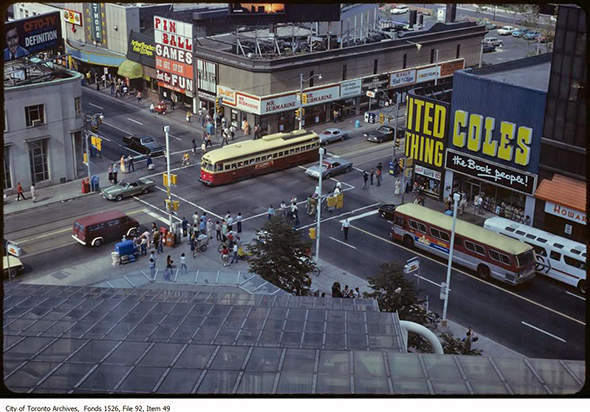
In the years that followed, this section of Yonge St. gradually became more retail-focused. The theatres closed, the taverns shut their doors, and in came a mix of hodgepodge mom and pop retail.
Mr. Sub occupied the old Brown Derby spot through the 1980s, while Coles Book Store had the southeast corner from the late '70s through the '80s.
This was a transitional period, and one which witnessed the area transform to cater to younger people. The arcades blossomed, the head shops proliferated, and the record stores enjoyed a resurgence at Yonge and Gould.
Yonge and Dundas was still cool in the 1980s. Uptown kids would flock down after school to loiter and play games. The Eaton Centre showed cheap movies at the Cineplex, and Lime Rickey's was about as hip as Toronto restaurants got.
The changes through the 1990s were gradual until the city of Toronto appropriated the land for the Yonge-Dundas Square and 10 Dundas East. All of sudden, the whole east side of the intersection was just gone.
By the time the 2000s rolled around most people were happy to see the construction on these projects finally conclude, but it was apparent that Yonge St. was a very different place.
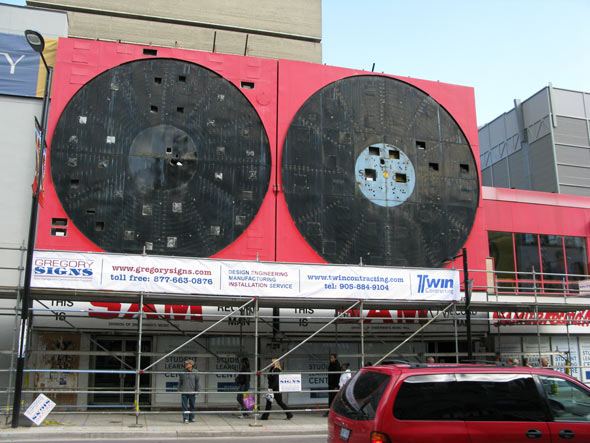
Sam the Record Man closed in 2007, the same year that 10 Dundas East opened. In some sense this is a coincidence. The old record shop was bound to close at some point, but the alignment of these two events is telling of the current state of Yonge and Dundas.
The intersection is still vibrant, marked by street performers and the occasional protest at Yonge-Dundas Square, but somewhere along the way it lost its soul.
Perhaps it happened on that fateful night in 1977. Or perhaps it was 2007. In any case, over those 30 years, everything changed.
This is what Toronto looked like in the 1960s
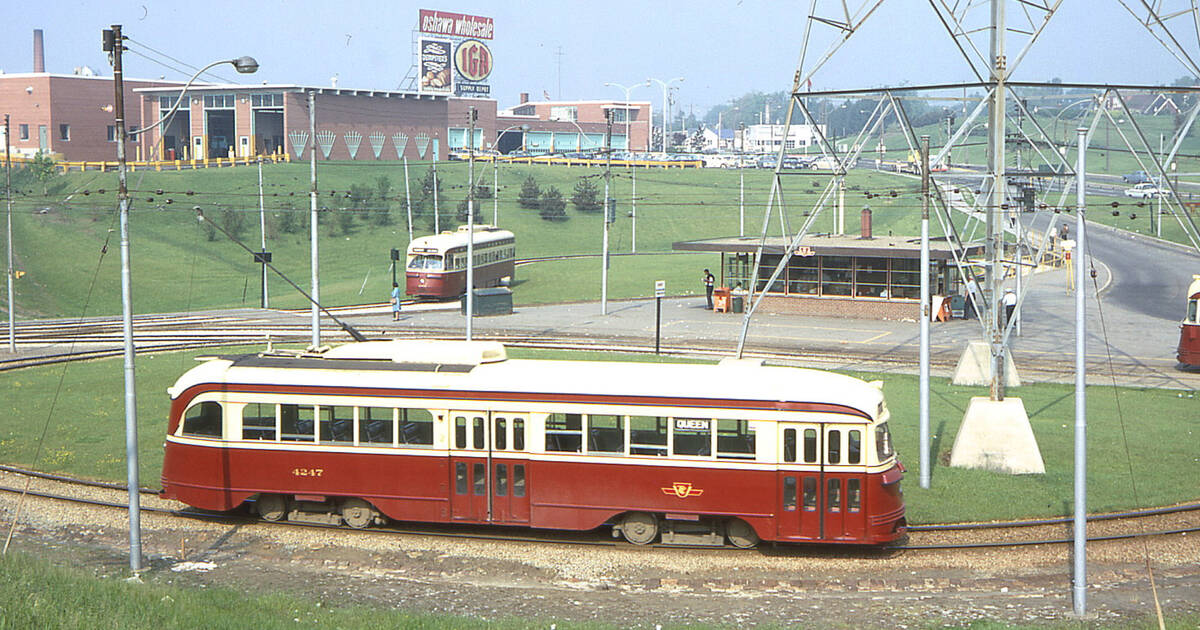
The 1960s in Toronto was a time in which the subways were red, the Leafs were Stanley Cup Winners, Nathan Phillips was still mayor (at the very beginning of the decade) and Yorkville was a hippie hub.
While City Hall was standing proud, the skyline lacked some familiar faces, like the CN Tower (completed 1976), First Canadian Place (completed 1975), Commerce Court West (completed 1972) and Scotia Plaza (completed 1988).
Here are some photos of what Toronto looked like in the 1960s.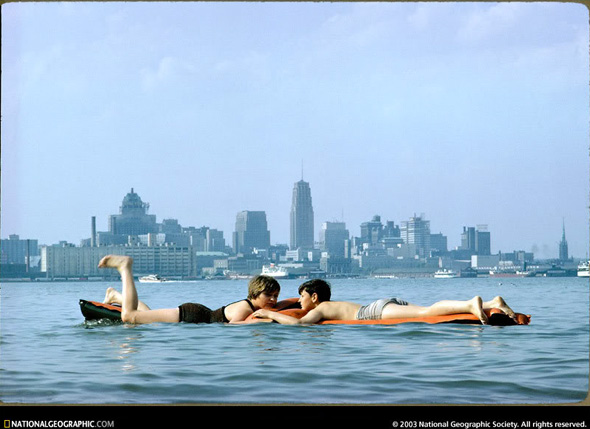
Swimmers with the much less-developed skyline in 1963. Photo from National Geographic. 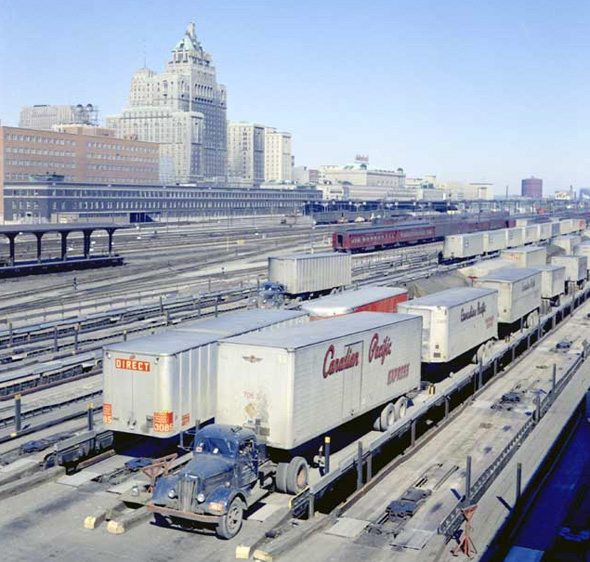 Railway tracks in front of the Royal York, 1963. Photo from Old Time Trains.
Railway tracks in front of the Royal York, 1963. Photo from Old Time Trains.
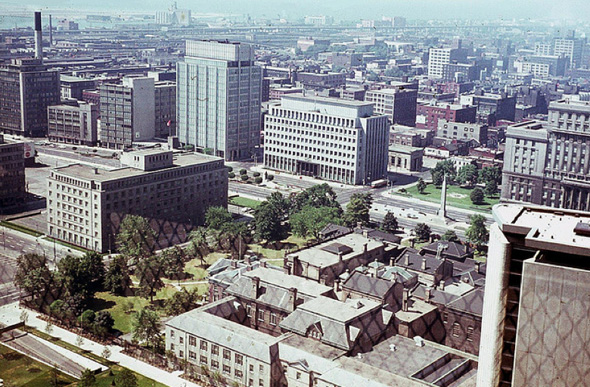
View from the observation deck of City Hall, 1966. Photo from kurtkomit.
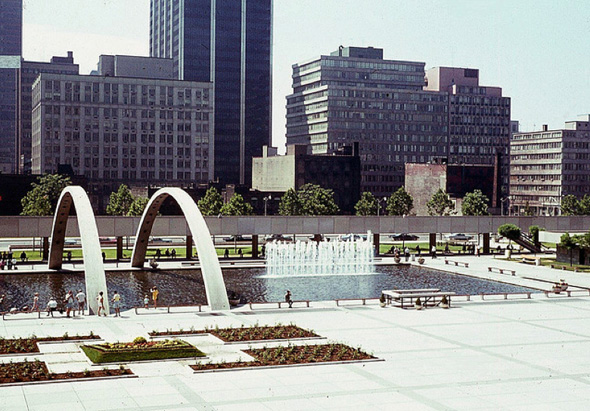
Nathan Phillips Square looking south 1966. Photo from kurtkomit
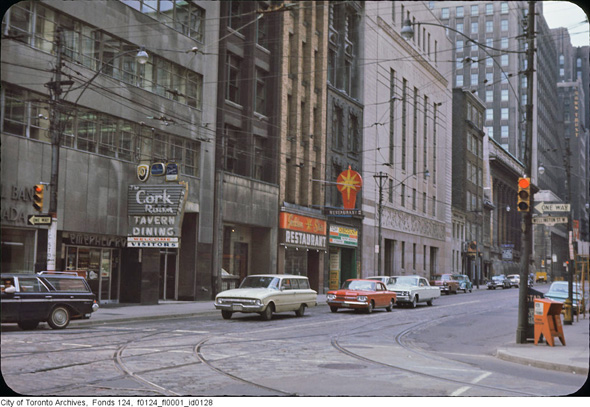
The Financial District. Photo from the Toronto Archives
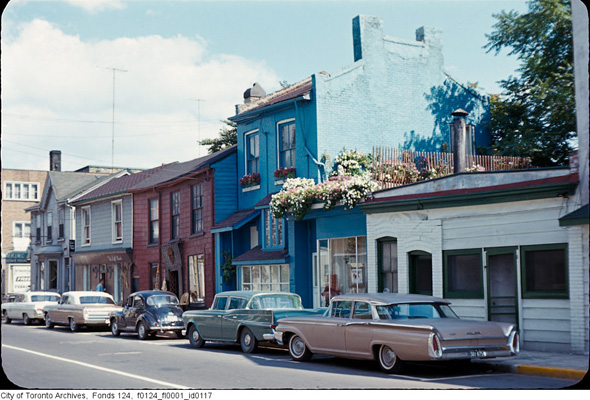
Gerrard Street around 1966. Photo from the Toronto Archives
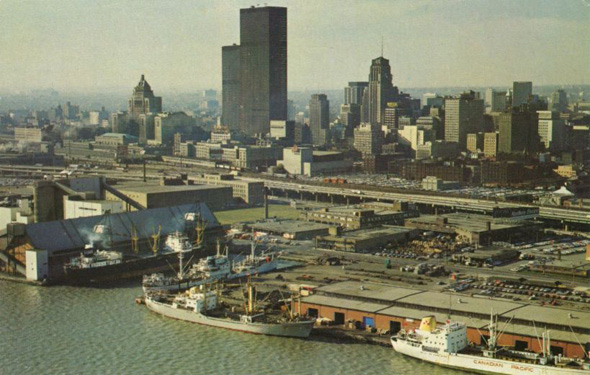
The skyline in 1967. Photo from the Toronto Archives
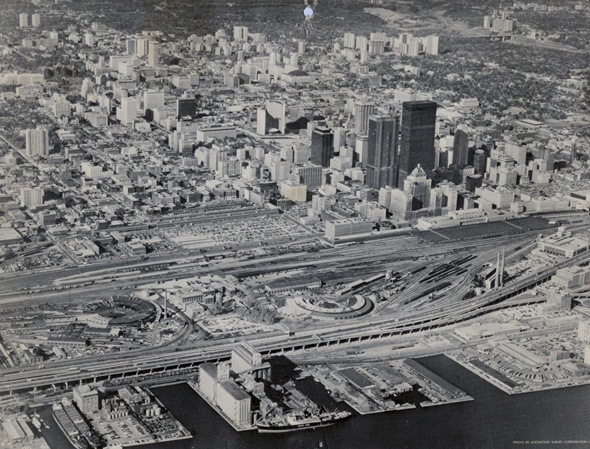
Another angle of the skyline in 1967. Photo from the Toronto Archives.

Bathurst and Sheppard in the 1960s. Photo from the Toronto Archives.
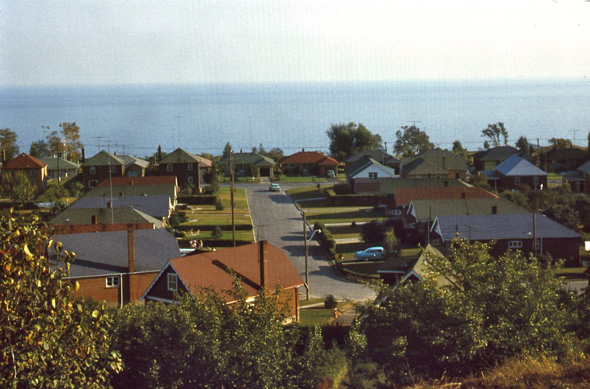
View from Cliffside Drive in Scarborough, 1961. Photo from pjs_deceased.
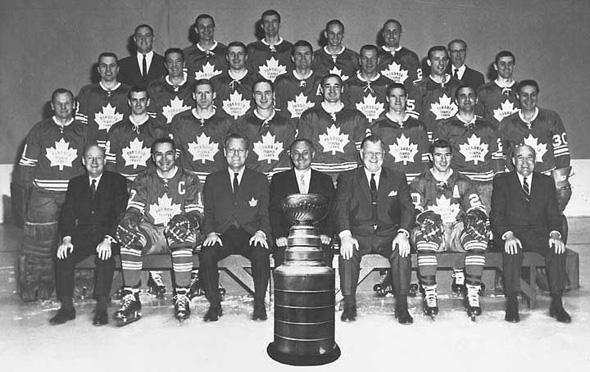
The Toronto Maple Leafs as the 1967 Stanley Cup Champions. Photo from Toronto Maple Leafs.
“Women of the Future” according to the French artist Albert Bergeret, 1902
torp3918Reference?
Your company's office is now allowed to reopen in Toronto and here are the new rules

Offices in Toronto may be allowed to reopen as part of Stage 3 but watercooler chitchat, work events, and even indoor meetings may not be returning for a while.
The rules for workplaces in terms of office safety procedures, number of employees, and opening requirements differ based on work sector and job but most offices are allowed to reopen in Stage 3 as indoor gathering limits have increased to a maximum of 50 people.
According to a preventing COVID-19 in the workplace resource on the government of Ontario website, workplaces are encouraged to post signage in their offices or workplace regarding:
- cleaning work surfaces often
- cleaning tools before and after use
- cleaning regularly touched items
- using boot sanitizing trays
- opening doors and windows to let in fresh air
- taking outdoor breaks
- staggering lunch breaks
- conducting outdoor meetings if possible
- reminders to stay two metres apart from others
To help people, businesses and communities prepare for Stage 3, the government and Ontario's health and safety associations, have released over 100 resources for health and safety which cover a wide range of workplaces.
According to the government of Ontario's "framework for reopening the province during Stage 3" document, businesses are still strongly encouraged to allow their employees to work remotely when possible as a way to contain the spread of COVID-19.
The resources available are said to help employers and workers better understand how to prevent the spread of COVID-19, according to the Government of Ontario's website.
Sector guidelines contain recommendations and tips for employers on how to keep workers safe on the job.
The restaurant and food services sector for example, has many requirements and guidelines including keeping physical distance from others, sanitizing frequently touched surfaces, and washing hands often.
The construction sector has similar guidelines like practicing physical distancing and washing hands often and their rules about sanitizing surfaces and commonly touched items are more specific to their industry and the tools they use.
As new sectors of the economy begin to reopen, additional COVID-19-related workplace safety resources will be added.
This is how yoga studios are reopening in Toronto for Stage 3
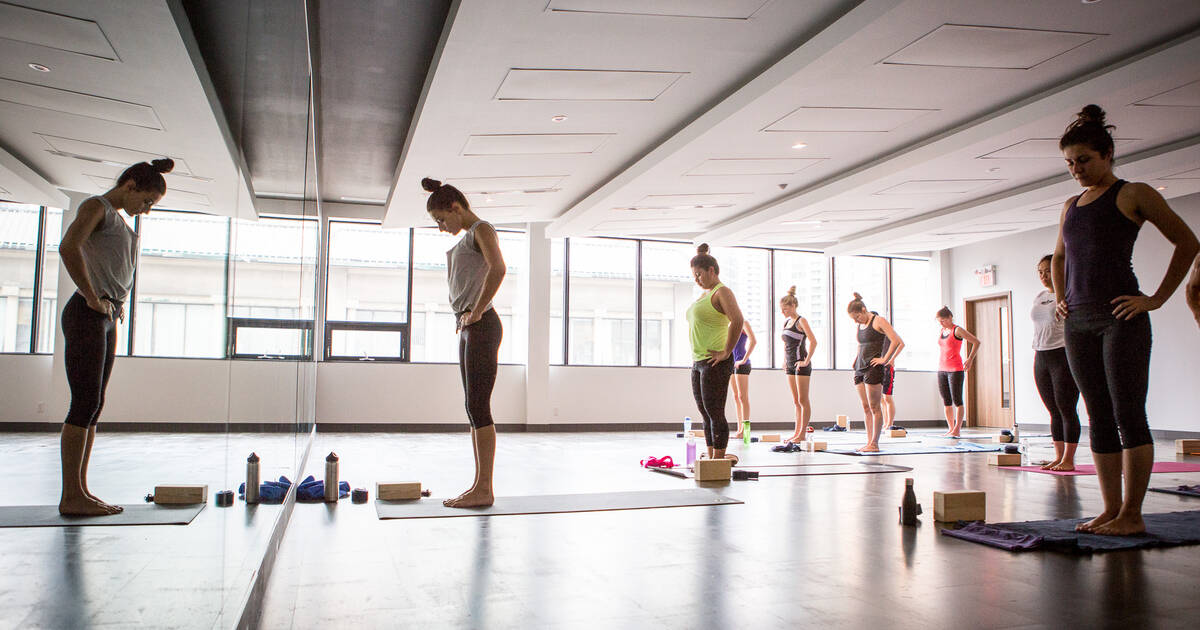
Forget doing yoga outdoors in weird plastic bubbles: Toronto enters Stage 3 on Friday, meaning yoga studios across the city are getting ready to open once more.
Gyms and fitness studios have been given the green light to reopen their doors to clients with increased health measures like physical distancing and reduced capacities.
There were several yoga studios that didn't make it through lockdown, like the independent Roncy staple Sama Yoga & Bodywork or Yyoga's Harbourfront location.
Those who did manage to make it to the other side have announced their reopening dates have also listed all the steps they're taking to keep people safe.
First and foremost, all hot yoga is still off-limits as steam rooms and saunas aren't permitted to open yet under Stage 3.
Studios such as Saana, Sweat and Tonic, and Yoga Tree have taken to social media to highlight some measures, one of which is requiring everyone in the studio to keep their face masks on, except during practice.
Other schools like Kula in the Annex have made it mandatory to wear a mask in all common spaces but have yet to decide if they think it's necessary in the studio too.
One thing all studios have in common is committing to fully sanitizing the studio and high touch areas before and after every class.
The three-storey Sweat & Tonic is implementing mandatory temperature checks before entering and has installed touchless motion sensors at the front entrance so people never have to touch a door at their Yonge and Dundas gym.
They've also reduced capacity by 40 per cent and have introduced touchless check-in at the reception.
Physical distancing markers have been introduced at nearly all studios to make sure mats are the appropriate six feet part.
Yoga Tree says they're suspending the use of all its showers, rental mats, lockers, towels and props — for now.
The studio also says that they'll be sanitizing the space with hospital-grade EPA-approved disinfectants and UV lights
Good ventilation is also a high priority: Kula says it's using air purifiers and will be running HVAC air exchange machine between classes to clear out the studios of all those sweaty particles.
Most yoga studios have been running virtual classes and will continue to do so even as they shift into this new stage of reopening.
Rare Black Panther Shadows His Leopard Mate in Incredible Shot by Photographer Mithun H

“The Eternal Couple.” Image © Mithun H, shared with permission
Since 2014, wildlife filmmaker and photographer Mithun H has been pining for sightings of Saya, a black panther that’s been eluding his admirers in the Kabini Forest in India for years. After camping out in the area for six days, the photographer captured a stunning image of the mysterious animal shadowing his leopard partner, Cleopatra.
Mithun H notes that the couple have been together for four years and have an atypical relationship for the species. “Usually in the courting pairs generally it is the male who takes charge and moves around with the female following close behind. But with this couple, it was definitely Cleo who was in charge while the panther followed,” he wrote on Instagram.
This isn’t the photographer’s first experience with the rare cat, either. He previously worked with National Geographic Wild on The Real Black Panther, which follows Saya’s life. “It’s been a passion and a beautiful journey in the woods of Kabini,” the photographer says. (via PetaPixel)






